ABE Level 4 Diploma in Business Management Specification
VerifiedAdded on 2023/05/15
|38
|9207
|170
AI Summary
In this assessment we will discuss about foundation diploma in business management and below are the summaries point:-
This text is a specification document for the ABE Level 4 Foundation Diploma in Business Management.
It outlines changes to the document format and assessment weighting and provides information on the qualification's recognition, objective, and entry criteria.
The qualification is designed for those seeking to improve their knowledge and skills in business management and offers pathways for progression.
Contribute Materials
Your contribution can guide someone’s learning journey. Share your
documents today.
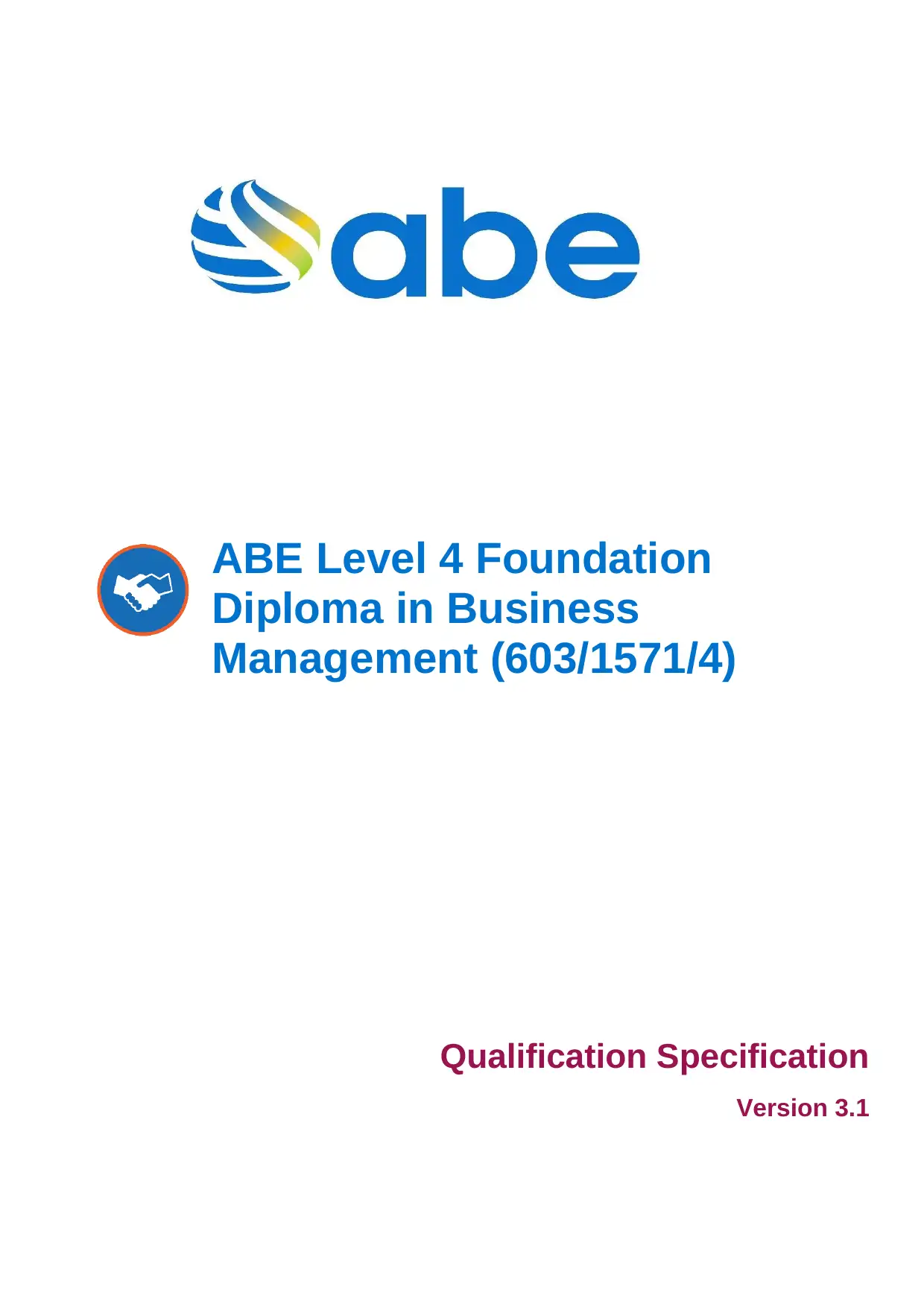
Qualification Specification
Version 3.1
ABE Level 4 Foundation
Diploma in Business
Management (603/1571/4)
Version 3.1
ABE Level 4 Foundation
Diploma in Business
Management (603/1571/4)
Secure Best Marks with AI Grader
Need help grading? Try our AI Grader for instant feedback on your assignments.
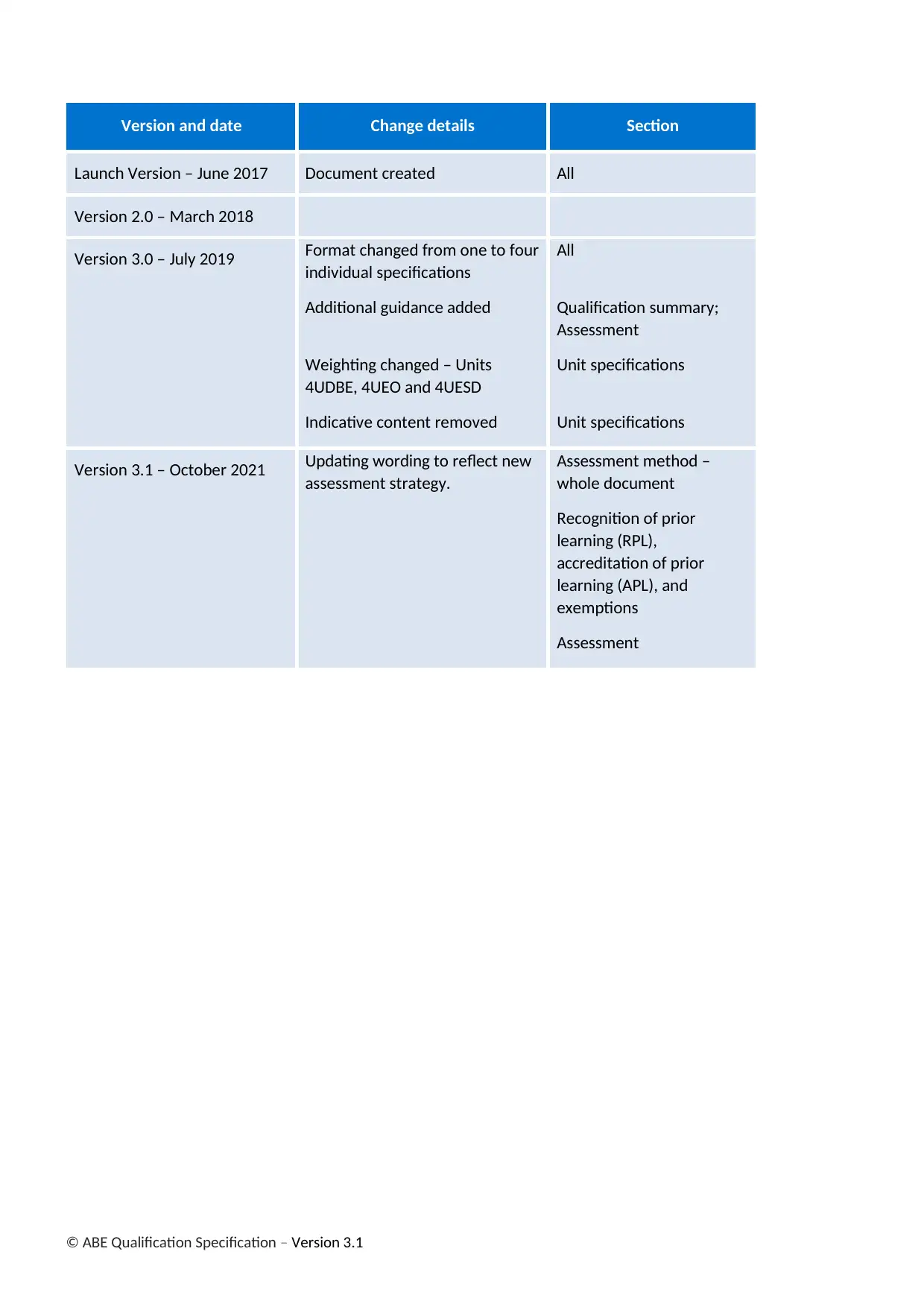
© ABE Qualification Specification – Version 3.1
Version and date Change details Section
Launch Version – June 2017 Document created All
Version 2.0 – March 2018
Version 3.0 – July 2019 Format changed from one to four
individual specifications
Additional guidance added
Weighting changed – Units
4UDBE, 4UEO and 4UESD
Indicative content removed
All
Qualification summary;
Assessment
Unit specifications
Unit specifications
Version 3.1 – October 2021 Updating wording to reflect new
assessment strategy.
Assessment method –
whole document
Recognition of prior
learning (RPL),
accreditation of prior
learning (APL), and
exemptions
Assessment
Version and date Change details Section
Launch Version – June 2017 Document created All
Version 2.0 – March 2018
Version 3.0 – July 2019 Format changed from one to four
individual specifications
Additional guidance added
Weighting changed – Units
4UDBE, 4UEO and 4UESD
Indicative content removed
All
Qualification summary;
Assessment
Unit specifications
Unit specifications
Version 3.1 – October 2021 Updating wording to reflect new
assessment strategy.
Assessment method –
whole document
Recognition of prior
learning (RPL),
accreditation of prior
learning (APL), and
exemptions
Assessment
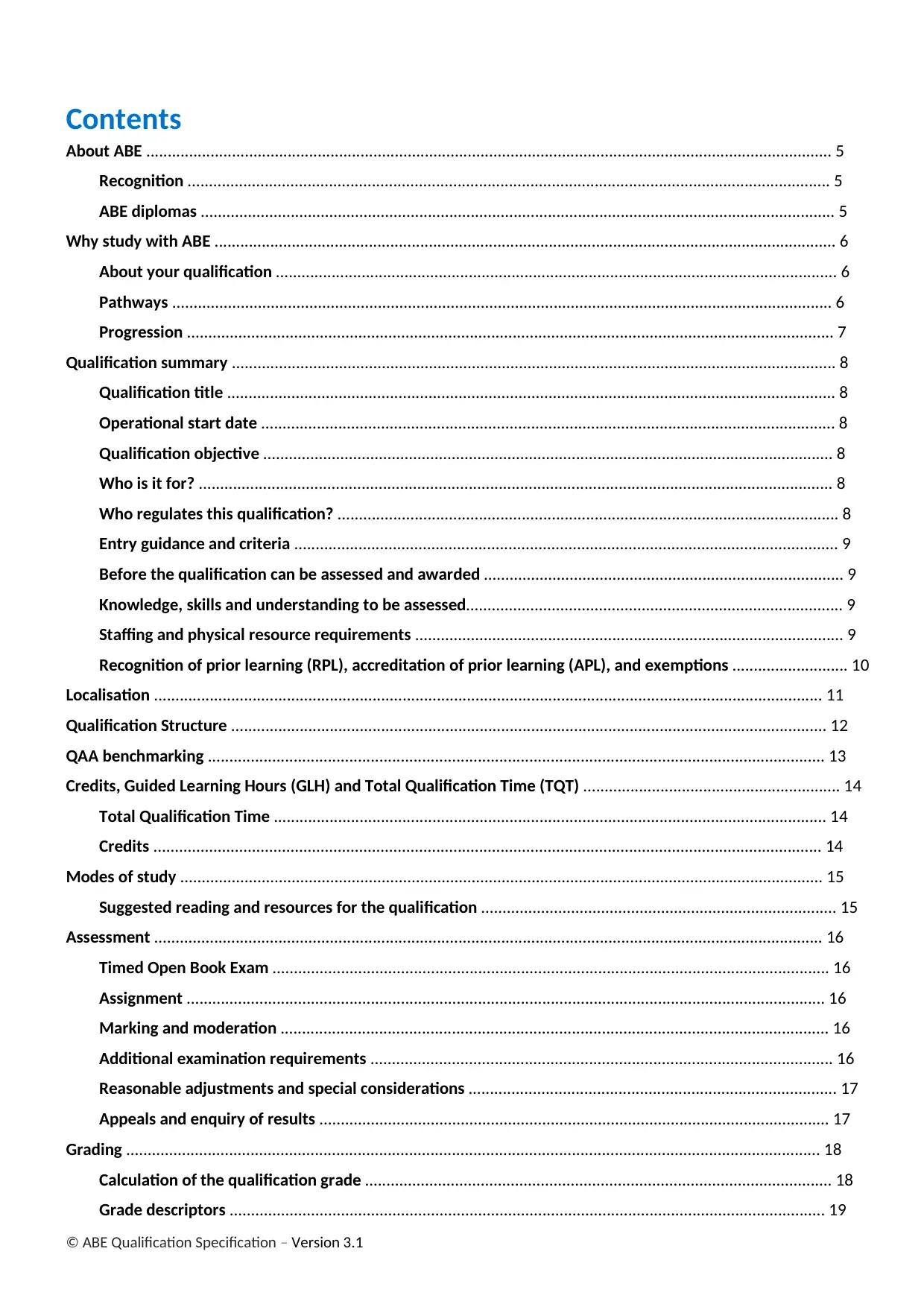
© ABE Qualification Specification – Version 3.1
Contents
About ABE ................................................................................................................................................................ 5
Recognition ...................................................................................................................................................... 5
ABE diplomas .................................................................................................................................................... 5
Why study with ABE ................................................................................................................................................. 6
About your qualification ................................................................................................................................... 6
Pathways .......................................................................................................................................................... 6
Progression ....................................................................................................................................................... 7
Qualification summary ............................................................................................................................................. 8
Qualification title .............................................................................................................................................. 8
Operational start date ...................................................................................................................................... 8
Qualification objective ..................................................................................................................................... 8
Who is it for? .................................................................................................................................................... 8
Who regulates this qualification? ..................................................................................................................... 8
Entry guidance and criteria ............................................................................................................................... 9
Before the qualification can be assessed and awarded .................................................................................... 9
Knowledge, skills and understanding to be assessed........................................................................................ 9
Staffing and physical resource requirements .................................................................................................... 9
Recognition of prior learning (RPL), accreditation of prior learning (APL), and exemptions ........................... 10
Localisation ............................................................................................................................................................ 11
Qualification Structure ........................................................................................................................................... 12
QAA benchmarking ................................................................................................................................................ 13
Credits, Guided Learning Hours (GLH) and Total Qualification Time (TQT) ............................................................ 14
Total Qualification Time ................................................................................................................................. 14
Credits ............................................................................................................................................................ 14
Modes of study ...................................................................................................................................................... 15
Suggested reading and resources for the qualification ................................................................................... 15
Assessment ............................................................................................................................................................ 16
Timed Open Book Exam .................................................................................................................................. 16
Assignment ..................................................................................................................................................... 16
Marking and moderation ................................................................................................................................ 16
Additional examination requirements ............................................................................................................ 16
Reasonable adjustments and special considerations ...................................................................................... 17
Appeals and enquiry of results ....................................................................................................................... 17
Grading .................................................................................................................................................................. 18
Calculation of the qualification grade ............................................................................................................. 18
Grade descriptors ........................................................................................................................................... 19
Contents
About ABE ................................................................................................................................................................ 5
Recognition ...................................................................................................................................................... 5
ABE diplomas .................................................................................................................................................... 5
Why study with ABE ................................................................................................................................................. 6
About your qualification ................................................................................................................................... 6
Pathways .......................................................................................................................................................... 6
Progression ....................................................................................................................................................... 7
Qualification summary ............................................................................................................................................. 8
Qualification title .............................................................................................................................................. 8
Operational start date ...................................................................................................................................... 8
Qualification objective ..................................................................................................................................... 8
Who is it for? .................................................................................................................................................... 8
Who regulates this qualification? ..................................................................................................................... 8
Entry guidance and criteria ............................................................................................................................... 9
Before the qualification can be assessed and awarded .................................................................................... 9
Knowledge, skills and understanding to be assessed........................................................................................ 9
Staffing and physical resource requirements .................................................................................................... 9
Recognition of prior learning (RPL), accreditation of prior learning (APL), and exemptions ........................... 10
Localisation ............................................................................................................................................................ 11
Qualification Structure ........................................................................................................................................... 12
QAA benchmarking ................................................................................................................................................ 13
Credits, Guided Learning Hours (GLH) and Total Qualification Time (TQT) ............................................................ 14
Total Qualification Time ................................................................................................................................. 14
Credits ............................................................................................................................................................ 14
Modes of study ...................................................................................................................................................... 15
Suggested reading and resources for the qualification ................................................................................... 15
Assessment ............................................................................................................................................................ 16
Timed Open Book Exam .................................................................................................................................. 16
Assignment ..................................................................................................................................................... 16
Marking and moderation ................................................................................................................................ 16
Additional examination requirements ............................................................................................................ 16
Reasonable adjustments and special considerations ...................................................................................... 17
Appeals and enquiry of results ....................................................................................................................... 17
Grading .................................................................................................................................................................. 18
Calculation of the qualification grade ............................................................................................................. 18
Grade descriptors ........................................................................................................................................... 19
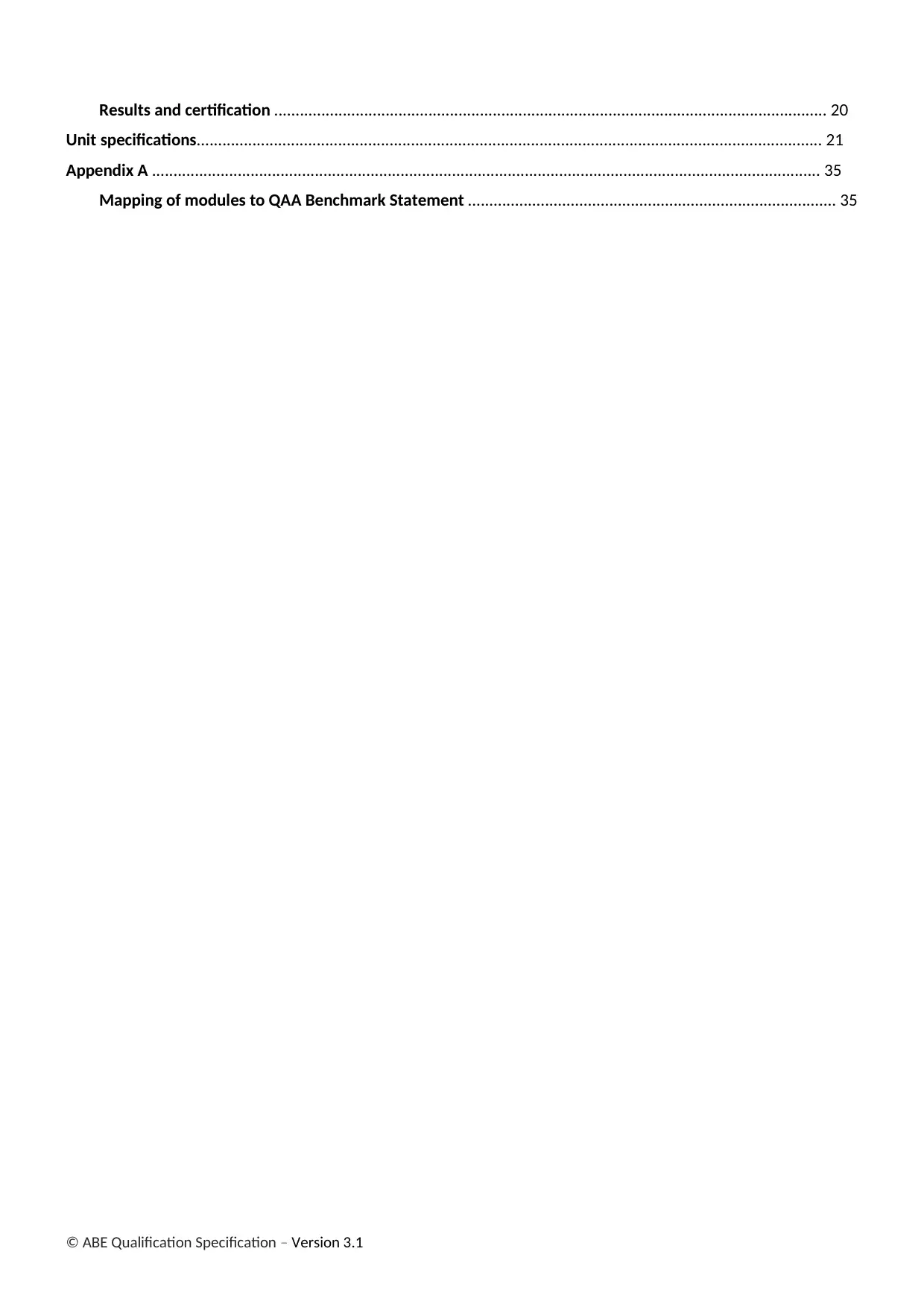
© ABE Qualification Specification – Version 3.1
Results and certification ................................................................................................................................. 20
Unit specifications.................................................................................................................................................. 21
Appendix A ............................................................................................................................................................ 35
Mapping of modules to QAA Benchmark Statement ...................................................................................... 35
Results and certification ................................................................................................................................. 20
Unit specifications.................................................................................................................................................. 21
Appendix A ............................................................................................................................................................ 35
Mapping of modules to QAA Benchmark Statement ...................................................................................... 35
Secure Best Marks with AI Grader
Need help grading? Try our AI Grader for instant feedback on your assignments.
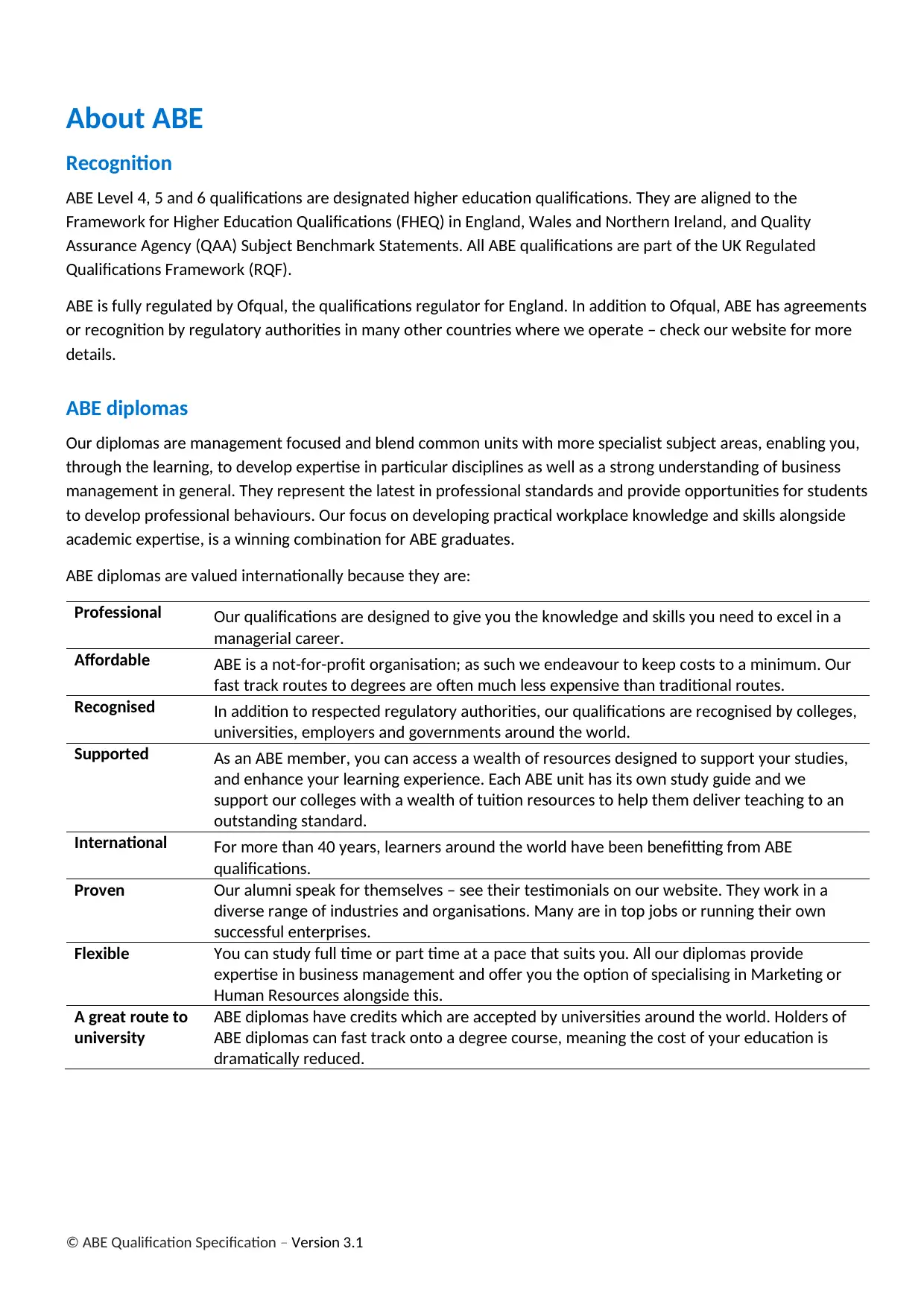
© ABE Qualification Specification – Version 3.1
About ABE
Recognition
ABE Level 4, 5 and 6 qualifications are designated higher education qualifications. They are aligned to the
Framework for Higher Education Qualifications (FHEQ) in England, Wales and Northern Ireland, and Quality
Assurance Agency (QAA) Subject Benchmark Statements. All ABE qualifications are part of the UK Regulated
Qualifications Framework (RQF).
ABE is fully regulated by Ofqual, the qualifications regulator for England. In addition to Ofqual, ABE has agreements
or recognition by regulatory authorities in many other countries where we operate – check our website for more
details.
ABE diplomas
Our diplomas are management focused and blend common units with more specialist subject areas, enabling you,
through the learning, to develop expertise in particular disciplines as well as a strong understanding of business
management in general. They represent the latest in professional standards and provide opportunities for students
to develop professional behaviours. Our focus on developing practical workplace knowledge and skills alongside
academic expertise, is a winning combination for ABE graduates.
ABE diplomas are valued internationally because they are:
Professional Our qualifications are designed to give you the knowledge and skills you need to excel in a
managerial career.
Affordable ABE is a not-for-profit organisation; as such we endeavour to keep costs to a minimum. Our
fast track routes to degrees are often much less expensive than traditional routes.
Recognised In addition to respected regulatory authorities, our qualifications are recognised by colleges,
universities, employers and governments around the world.
Supported As an ABE member, you can access a wealth of resources designed to support your studies,
and enhance your learning experience. Each ABE unit has its own study guide and we
support our colleges with a wealth of tuition resources to help them deliver teaching to an
outstanding standard.
International For more than 40 years, learners around the world have been benefitting from ABE
qualifications.
Proven Our alumni speak for themselves – see their testimonials on our website. They work in a
diverse range of industries and organisations. Many are in top jobs or running their own
successful enterprises.
Flexible You can study full time or part time at a pace that suits you. All our diplomas provide
expertise in business management and offer you the option of specialising in Marketing or
Human Resources alongside this.
A great route to
university
ABE diplomas have credits which are accepted by universities around the world. Holders of
ABE diplomas can fast track onto a degree course, meaning the cost of your education is
dramatically reduced.
About ABE
Recognition
ABE Level 4, 5 and 6 qualifications are designated higher education qualifications. They are aligned to the
Framework for Higher Education Qualifications (FHEQ) in England, Wales and Northern Ireland, and Quality
Assurance Agency (QAA) Subject Benchmark Statements. All ABE qualifications are part of the UK Regulated
Qualifications Framework (RQF).
ABE is fully regulated by Ofqual, the qualifications regulator for England. In addition to Ofqual, ABE has agreements
or recognition by regulatory authorities in many other countries where we operate – check our website for more
details.
ABE diplomas
Our diplomas are management focused and blend common units with more specialist subject areas, enabling you,
through the learning, to develop expertise in particular disciplines as well as a strong understanding of business
management in general. They represent the latest in professional standards and provide opportunities for students
to develop professional behaviours. Our focus on developing practical workplace knowledge and skills alongside
academic expertise, is a winning combination for ABE graduates.
ABE diplomas are valued internationally because they are:
Professional Our qualifications are designed to give you the knowledge and skills you need to excel in a
managerial career.
Affordable ABE is a not-for-profit organisation; as such we endeavour to keep costs to a minimum. Our
fast track routes to degrees are often much less expensive than traditional routes.
Recognised In addition to respected regulatory authorities, our qualifications are recognised by colleges,
universities, employers and governments around the world.
Supported As an ABE member, you can access a wealth of resources designed to support your studies,
and enhance your learning experience. Each ABE unit has its own study guide and we
support our colleges with a wealth of tuition resources to help them deliver teaching to an
outstanding standard.
International For more than 40 years, learners around the world have been benefitting from ABE
qualifications.
Proven Our alumni speak for themselves – see their testimonials on our website. They work in a
diverse range of industries and organisations. Many are in top jobs or running their own
successful enterprises.
Flexible You can study full time or part time at a pace that suits you. All our diplomas provide
expertise in business management and offer you the option of specialising in Marketing or
Human Resources alongside this.
A great route to
university
ABE diplomas have credits which are accepted by universities around the world. Holders of
ABE diplomas can fast track onto a degree course, meaning the cost of your education is
dramatically reduced.
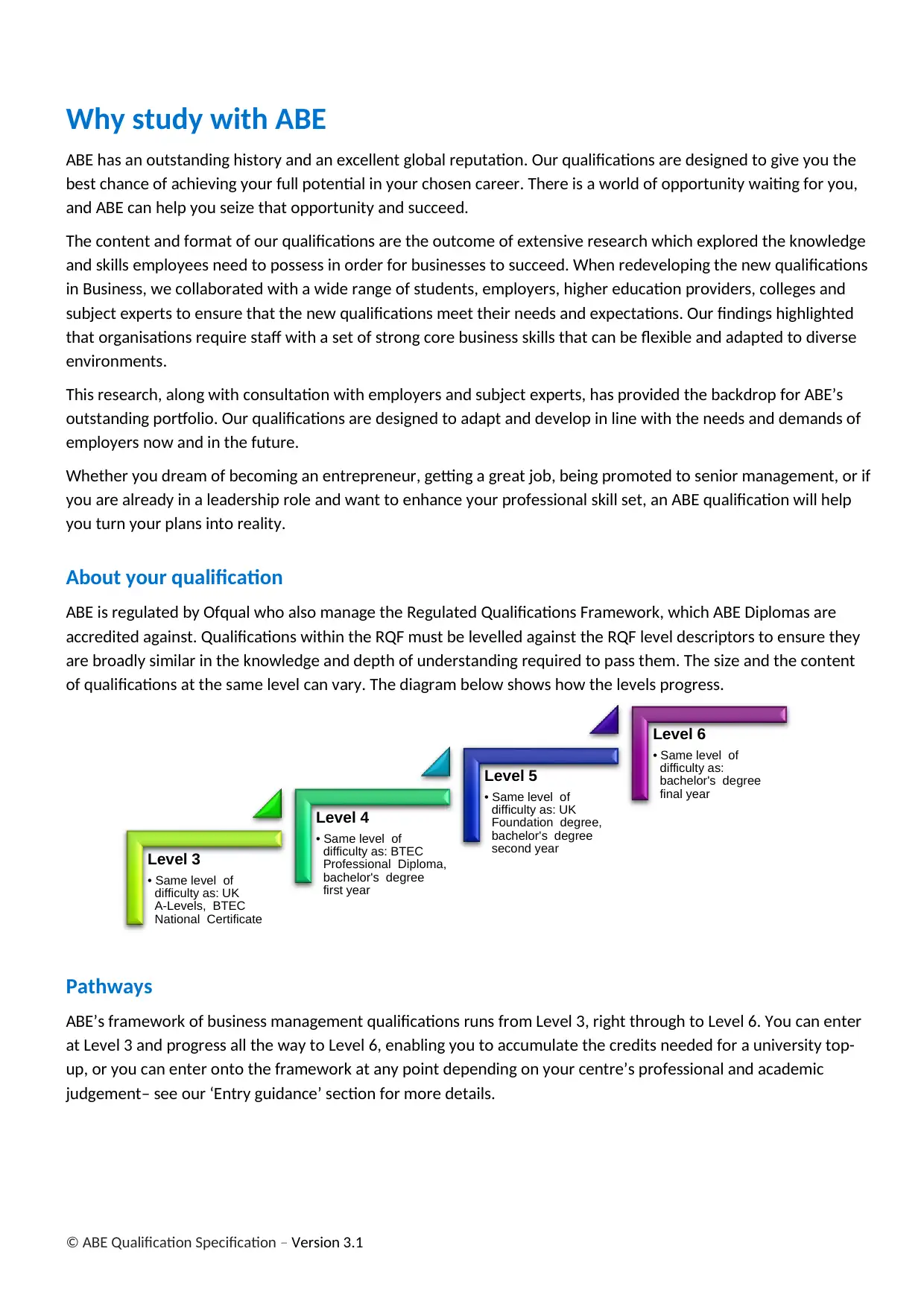
© ABE Qualification Specification – Version 3.1
Why study with ABE
ABE has an outstanding history and an excellent global reputation. Our qualifications are designed to give you the
best chance of achieving your full potential in your chosen career. There is a world of opportunity waiting for you,
and ABE can help you seize that opportunity and succeed.
The content and format of our qualifications are the outcome of extensive research which explored the knowledge
and skills employees need to possess in order for businesses to succeed. When redeveloping the new qualifications
in Business, we collaborated with a wide range of students, employers, higher education providers, colleges and
subject experts to ensure that the new qualifications meet their needs and expectations. Our findings highlighted
that organisations require staff with a set of strong core business skills that can be flexible and adapted to diverse
environments.
This research, along with consultation with employers and subject experts, has provided the backdrop for ABE’s
outstanding portfolio. Our qualifications are designed to adapt and develop in line with the needs and demands of
employers now and in the future.
Whether you dream of becoming an entrepreneur, getting a great job, being promoted to senior management, or if
you are already in a leadership role and want to enhance your professional skill set, an ABE qualification will help
you turn your plans into reality.
About your qualification
ABE is regulated by Ofqual who also manage the Regulated Qualifications Framework, which ABE Diplomas are
accredited against. Qualifications within the RQF must be levelled against the RQF level descriptors to ensure they
are broadly similar in the knowledge and depth of understanding required to pass them. The size and the content
of qualifications at the same level can vary. The diagram below shows how the levels progress.
Pathways
ABE’s framework of business management qualifications runs from Level 3, right through to Level 6. You can enter
at Level 3 and progress all the way to Level 6, enabling you to accumulate the credits needed for a university top-
up, or you can enter onto the framework at any point depending on your centre’s professional and academic
judgement– see our ‘Entry guidance’ section for more details.
Level 3
• Same level of
difficulty as: UK
A-Levels, BTEC
National Certificate
Level 4
• Same level of
difficulty as: BTEC
Professional Diploma,
bachelor's degree
first year
Level 5
• Same level of
difficulty as: UK
Foundation degree,
bachelor's degree
second year
Level 6
• Same level of
difficulty as:
bachelor's degree
final year
Why study with ABE
ABE has an outstanding history and an excellent global reputation. Our qualifications are designed to give you the
best chance of achieving your full potential in your chosen career. There is a world of opportunity waiting for you,
and ABE can help you seize that opportunity and succeed.
The content and format of our qualifications are the outcome of extensive research which explored the knowledge
and skills employees need to possess in order for businesses to succeed. When redeveloping the new qualifications
in Business, we collaborated with a wide range of students, employers, higher education providers, colleges and
subject experts to ensure that the new qualifications meet their needs and expectations. Our findings highlighted
that organisations require staff with a set of strong core business skills that can be flexible and adapted to diverse
environments.
This research, along with consultation with employers and subject experts, has provided the backdrop for ABE’s
outstanding portfolio. Our qualifications are designed to adapt and develop in line with the needs and demands of
employers now and in the future.
Whether you dream of becoming an entrepreneur, getting a great job, being promoted to senior management, or if
you are already in a leadership role and want to enhance your professional skill set, an ABE qualification will help
you turn your plans into reality.
About your qualification
ABE is regulated by Ofqual who also manage the Regulated Qualifications Framework, which ABE Diplomas are
accredited against. Qualifications within the RQF must be levelled against the RQF level descriptors to ensure they
are broadly similar in the knowledge and depth of understanding required to pass them. The size and the content
of qualifications at the same level can vary. The diagram below shows how the levels progress.
Pathways
ABE’s framework of business management qualifications runs from Level 3, right through to Level 6. You can enter
at Level 3 and progress all the way to Level 6, enabling you to accumulate the credits needed for a university top-
up, or you can enter onto the framework at any point depending on your centre’s professional and academic
judgement– see our ‘Entry guidance’ section for more details.
Level 3
• Same level of
difficulty as: UK
A-Levels, BTEC
National Certificate
Level 4
• Same level of
difficulty as: BTEC
Professional Diploma,
bachelor's degree
first year
Level 5
• Same level of
difficulty as: UK
Foundation degree,
bachelor's degree
second year
Level 6
• Same level of
difficulty as:
bachelor's degree
final year
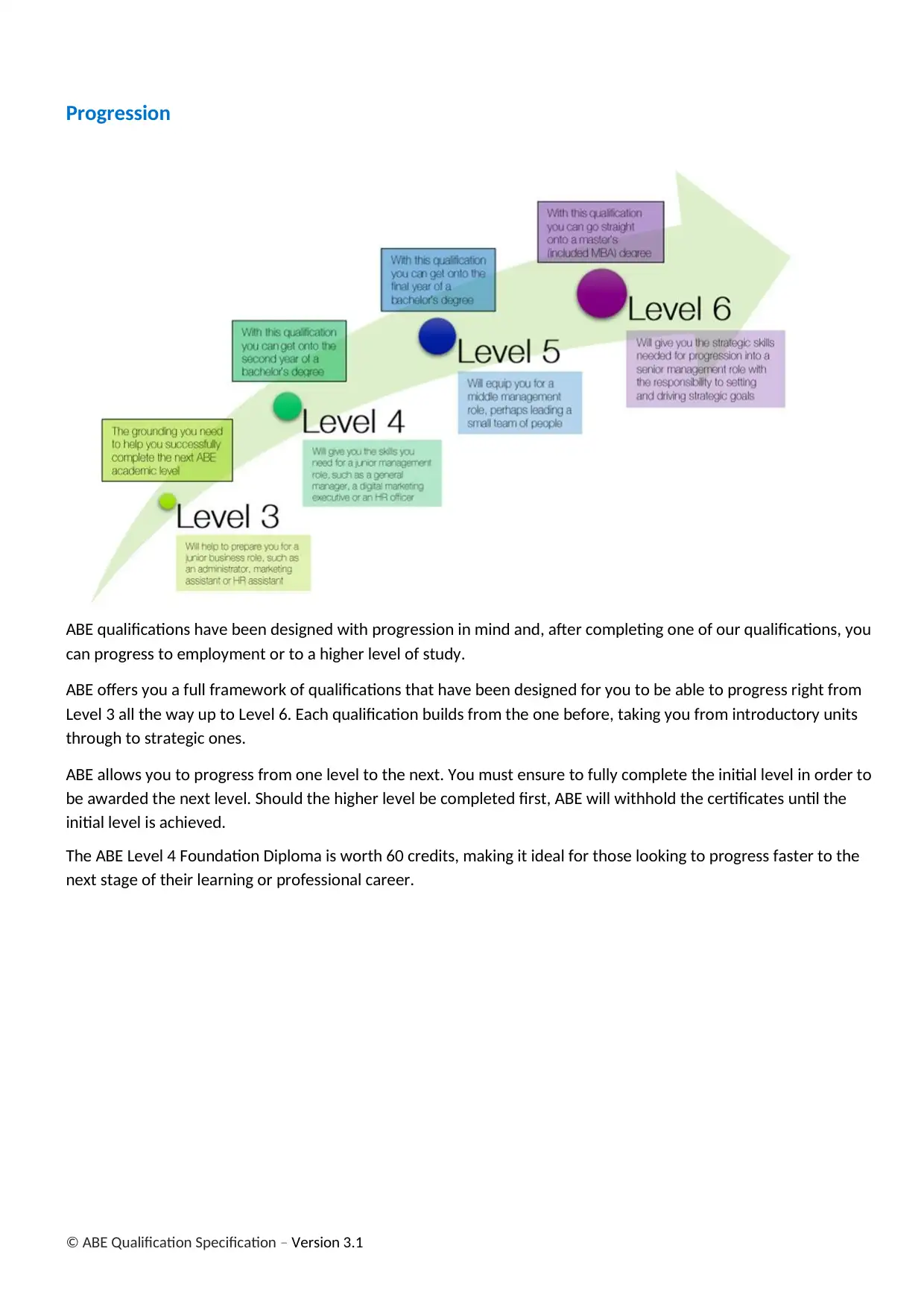
© ABE Qualification Specification – Version 3.1
Progression
ABE qualifications have been designed with progression in mind and, after completing one of our qualifications, you
can progress to employment or to a higher level of study.
ABE offers you a full framework of qualifications that have been designed for you to be able to progress right from
Level 3 all the way up to Level 6. Each qualification builds from the one before, taking you from introductory units
through to strategic ones.
ABE allows you to progress from one level to the next. You must ensure to fully complete the initial level in order to
be awarded the next level. Should the higher level be completed first, ABE will withhold the certificates until the
initial level is achieved.
The ABE Level 4 Foundation Diploma is worth 60 credits, making it ideal for those looking to progress faster to the
next stage of their learning or professional career.
Progression
ABE qualifications have been designed with progression in mind and, after completing one of our qualifications, you
can progress to employment or to a higher level of study.
ABE offers you a full framework of qualifications that have been designed for you to be able to progress right from
Level 3 all the way up to Level 6. Each qualification builds from the one before, taking you from introductory units
through to strategic ones.
ABE allows you to progress from one level to the next. You must ensure to fully complete the initial level in order to
be awarded the next level. Should the higher level be completed first, ABE will withhold the certificates until the
initial level is achieved.
The ABE Level 4 Foundation Diploma is worth 60 credits, making it ideal for those looking to progress faster to the
next stage of their learning or professional career.
Paraphrase This Document
Need a fresh take? Get an instant paraphrase of this document with our AI Paraphraser
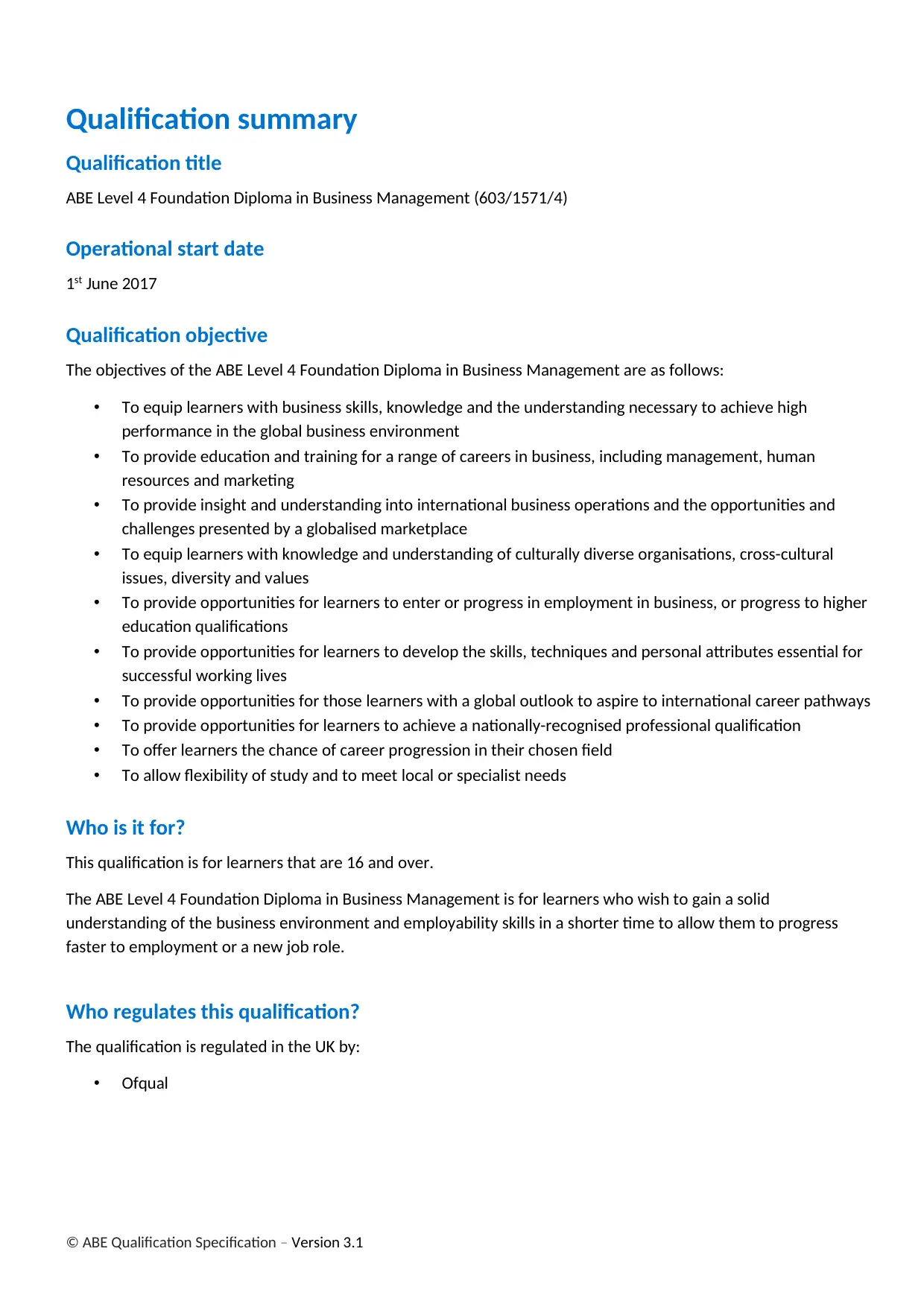
© ABE Qualification Specification – Version 3.1
Qualification summary
Qualification title
ABE Level 4 Foundation Diploma in Business Management (603/1571/4)
Operational start date
1st June 2017
Qualification objective
The objectives of the ABE Level 4 Foundation Diploma in Business Management are as follows:
• To equip learners with business skills, knowledge and the understanding necessary to achieve high
performance in the global business environment
• To provide education and training for a range of careers in business, including management, human
resources and marketing
• To provide insight and understanding into international business operations and the opportunities and
challenges presented by a globalised marketplace
• To equip learners with knowledge and understanding of culturally diverse organisations, cross-cultural
issues, diversity and values
• To provide opportunities for learners to enter or progress in employment in business, or progress to higher
education qualifications
• To provide opportunities for learners to develop the skills, techniques and personal attributes essential for
successful working lives
• To provide opportunities for those learners with a global outlook to aspire to international career pathways
• To provide opportunities for learners to achieve a nationally-recognised professional qualification
• To offer learners the chance of career progression in their chosen field
• To allow flexibility of study and to meet local or specialist needs
Who is it for?
This qualification is for learners that are 16 and over.
The ABE Level 4 Foundation Diploma in Business Management is for learners who wish to gain a solid
understanding of the business environment and employability skills in a shorter time to allow them to progress
faster to employment or a new job role.
Who regulates this qualification?
The qualification is regulated in the UK by:
• Ofqual
Qualification summary
Qualification title
ABE Level 4 Foundation Diploma in Business Management (603/1571/4)
Operational start date
1st June 2017
Qualification objective
The objectives of the ABE Level 4 Foundation Diploma in Business Management are as follows:
• To equip learners with business skills, knowledge and the understanding necessary to achieve high
performance in the global business environment
• To provide education and training for a range of careers in business, including management, human
resources and marketing
• To provide insight and understanding into international business operations and the opportunities and
challenges presented by a globalised marketplace
• To equip learners with knowledge and understanding of culturally diverse organisations, cross-cultural
issues, diversity and values
• To provide opportunities for learners to enter or progress in employment in business, or progress to higher
education qualifications
• To provide opportunities for learners to develop the skills, techniques and personal attributes essential for
successful working lives
• To provide opportunities for those learners with a global outlook to aspire to international career pathways
• To provide opportunities for learners to achieve a nationally-recognised professional qualification
• To offer learners the chance of career progression in their chosen field
• To allow flexibility of study and to meet local or specialist needs
Who is it for?
This qualification is for learners that are 16 and over.
The ABE Level 4 Foundation Diploma in Business Management is for learners who wish to gain a solid
understanding of the business environment and employability skills in a shorter time to allow them to progress
faster to employment or a new job role.
Who regulates this qualification?
The qualification is regulated in the UK by:
• Ofqual
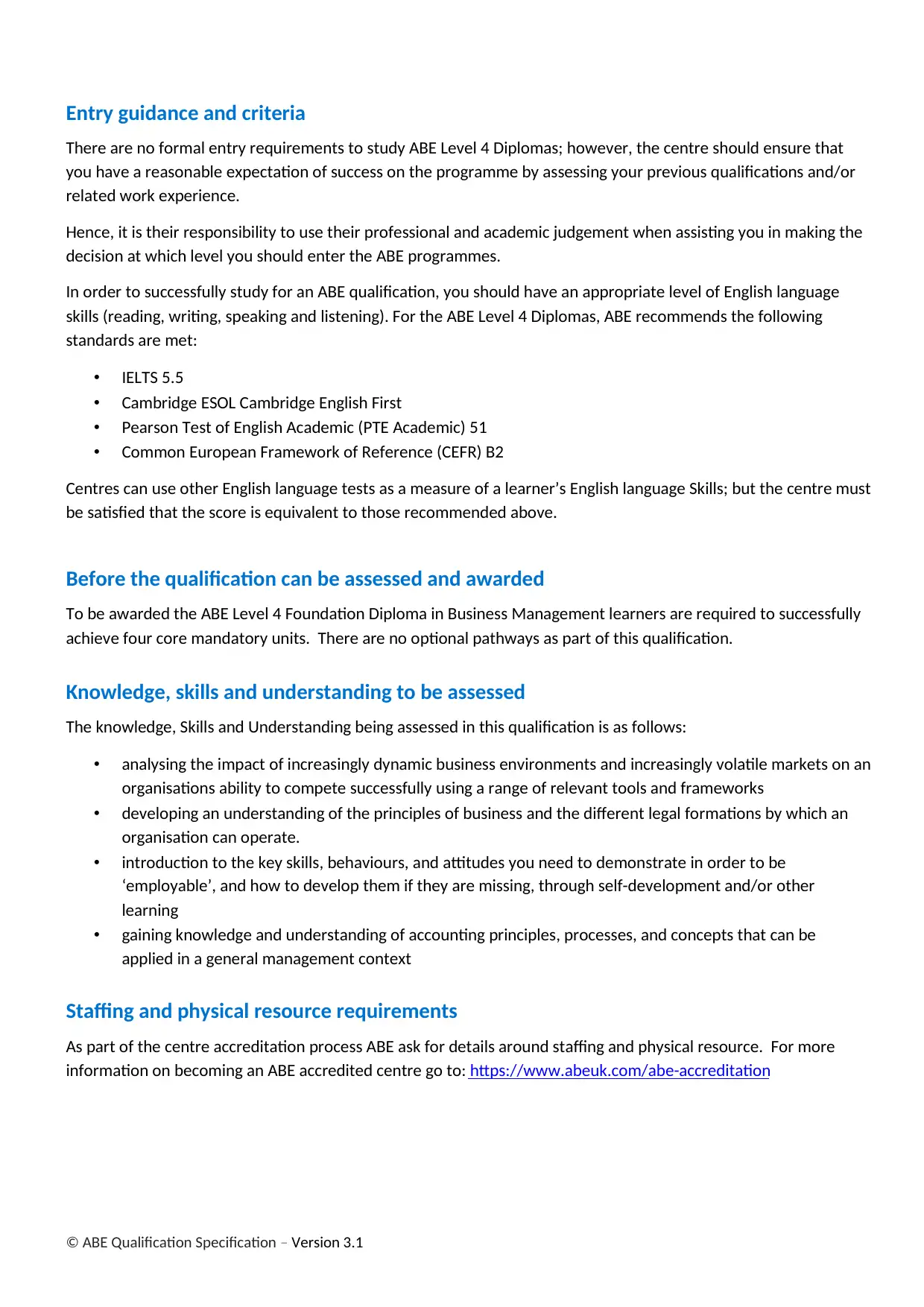
© ABE Qualification Specification – Version 3.1
Entry guidance and criteria
There are no formal entry requirements to study ABE Level 4 Diplomas; however, the centre should ensure that
you have a reasonable expectation of success on the programme by assessing your previous qualifications and/or
related work experience.
Hence, it is their responsibility to use their professional and academic judgement when assisting you in making the
decision at which level you should enter the ABE programmes.
In order to successfully study for an ABE qualification, you should have an appropriate level of English language
skills (reading, writing, speaking and listening). For the ABE Level 4 Diplomas, ABE recommends the following
standards are met:
• IELTS 5.5
• Cambridge ESOL Cambridge English First
• Pearson Test of English Academic (PTE Academic) 51
• Common European Framework of Reference (CEFR) B2
Centres can use other English language tests as a measure of a learner’s English language Skills; but the centre must
be satisfied that the score is equivalent to those recommended above.
Before the qualification can be assessed and awarded
To be awarded the ABE Level 4 Foundation Diploma in Business Management learners are required to successfully
achieve four core mandatory units. There are no optional pathways as part of this qualification.
Knowledge, skills and understanding to be assessed
The knowledge, Skills and Understanding being assessed in this qualification is as follows:
• analysing the impact of increasingly dynamic business environments and increasingly volatile markets on an
organisations ability to compete successfully using a range of relevant tools and frameworks
• developing an understanding of the principles of business and the different legal formations by which an
organisation can operate.
• introduction to the key skills, behaviours, and attitudes you need to demonstrate in order to be
‘employable’, and how to develop them if they are missing, through self-development and/or other
learning
• gaining knowledge and understanding of accounting principles, processes, and concepts that can be
applied in a general management context
Staffing and physical resource requirements
As part of the centre accreditation process ABE ask for details around staffing and physical resource. For more
information on becoming an ABE accredited centre go to: https://www.abeuk.com/abe-accreditation
Entry guidance and criteria
There are no formal entry requirements to study ABE Level 4 Diplomas; however, the centre should ensure that
you have a reasonable expectation of success on the programme by assessing your previous qualifications and/or
related work experience.
Hence, it is their responsibility to use their professional and academic judgement when assisting you in making the
decision at which level you should enter the ABE programmes.
In order to successfully study for an ABE qualification, you should have an appropriate level of English language
skills (reading, writing, speaking and listening). For the ABE Level 4 Diplomas, ABE recommends the following
standards are met:
• IELTS 5.5
• Cambridge ESOL Cambridge English First
• Pearson Test of English Academic (PTE Academic) 51
• Common European Framework of Reference (CEFR) B2
Centres can use other English language tests as a measure of a learner’s English language Skills; but the centre must
be satisfied that the score is equivalent to those recommended above.
Before the qualification can be assessed and awarded
To be awarded the ABE Level 4 Foundation Diploma in Business Management learners are required to successfully
achieve four core mandatory units. There are no optional pathways as part of this qualification.
Knowledge, skills and understanding to be assessed
The knowledge, Skills and Understanding being assessed in this qualification is as follows:
• analysing the impact of increasingly dynamic business environments and increasingly volatile markets on an
organisations ability to compete successfully using a range of relevant tools and frameworks
• developing an understanding of the principles of business and the different legal formations by which an
organisation can operate.
• introduction to the key skills, behaviours, and attitudes you need to demonstrate in order to be
‘employable’, and how to develop them if they are missing, through self-development and/or other
learning
• gaining knowledge and understanding of accounting principles, processes, and concepts that can be
applied in a general management context
Staffing and physical resource requirements
As part of the centre accreditation process ABE ask for details around staffing and physical resource. For more
information on becoming an ABE accredited centre go to: https://www.abeuk.com/abe-accreditation
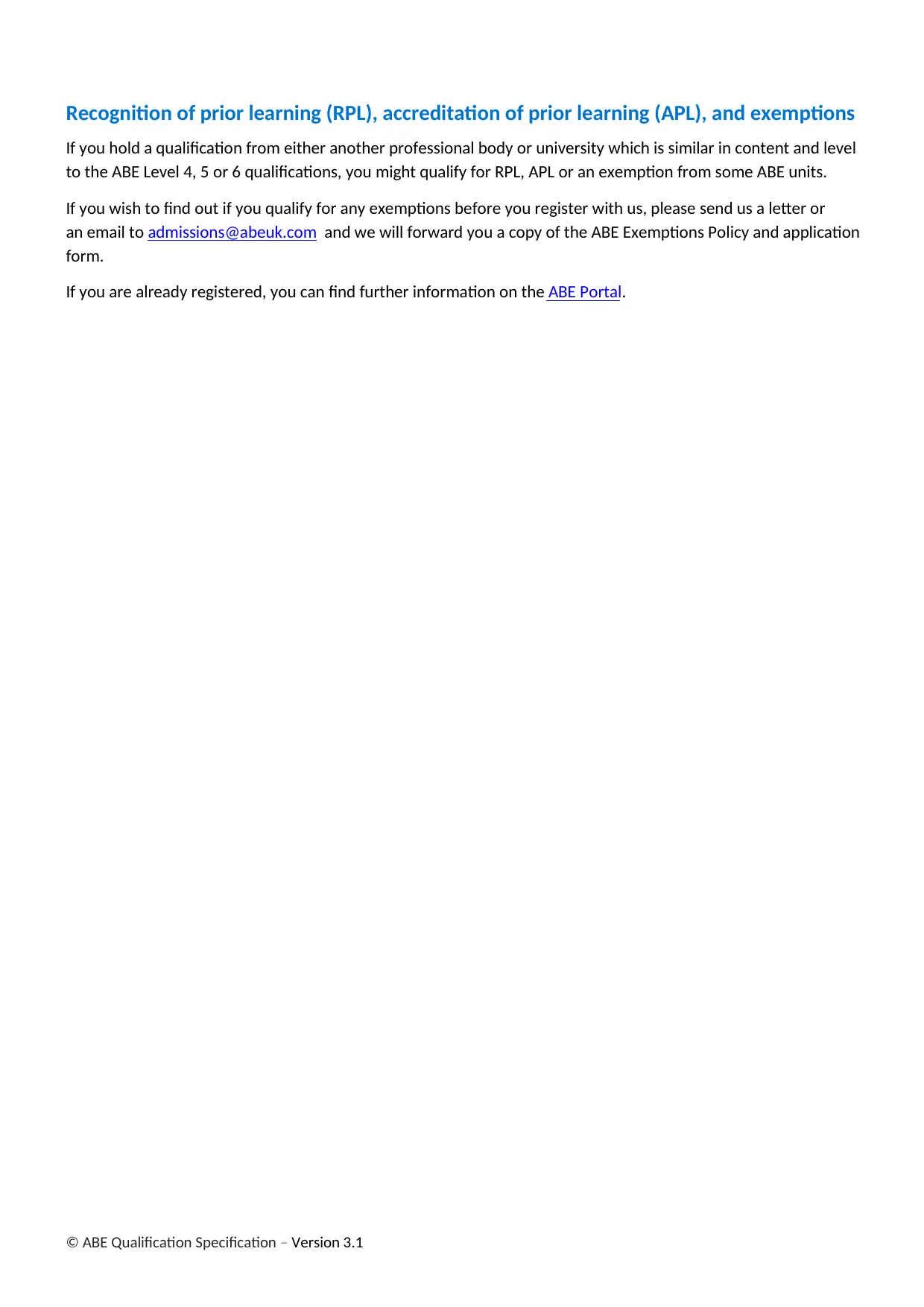
© ABE Qualification Specification – Version 3.1
Recognition of prior learning (RPL), accreditation of prior learning (APL), and exemptions
If you hold a qualification from either another professional body or university which is similar in content and level
to the ABE Level 4, 5 or 6 qualifications, you might qualify for RPL, APL or an exemption from some ABE units.
If you wish to find out if you qualify for any exemptions before you register with us, please send us a letter or
an email to admissions@abeuk.com and we will forward you a copy of the ABE Exemptions Policy and application
form.
If you are already registered, you can find further information on the ABE Portal.
Recognition of prior learning (RPL), accreditation of prior learning (APL), and exemptions
If you hold a qualification from either another professional body or university which is similar in content and level
to the ABE Level 4, 5 or 6 qualifications, you might qualify for RPL, APL or an exemption from some ABE units.
If you wish to find out if you qualify for any exemptions before you register with us, please send us a letter or
an email to admissions@abeuk.com and we will forward you a copy of the ABE Exemptions Policy and application
form.
If you are already registered, you can find further information on the ABE Portal.
Secure Best Marks with AI Grader
Need help grading? Try our AI Grader for instant feedback on your assignments.
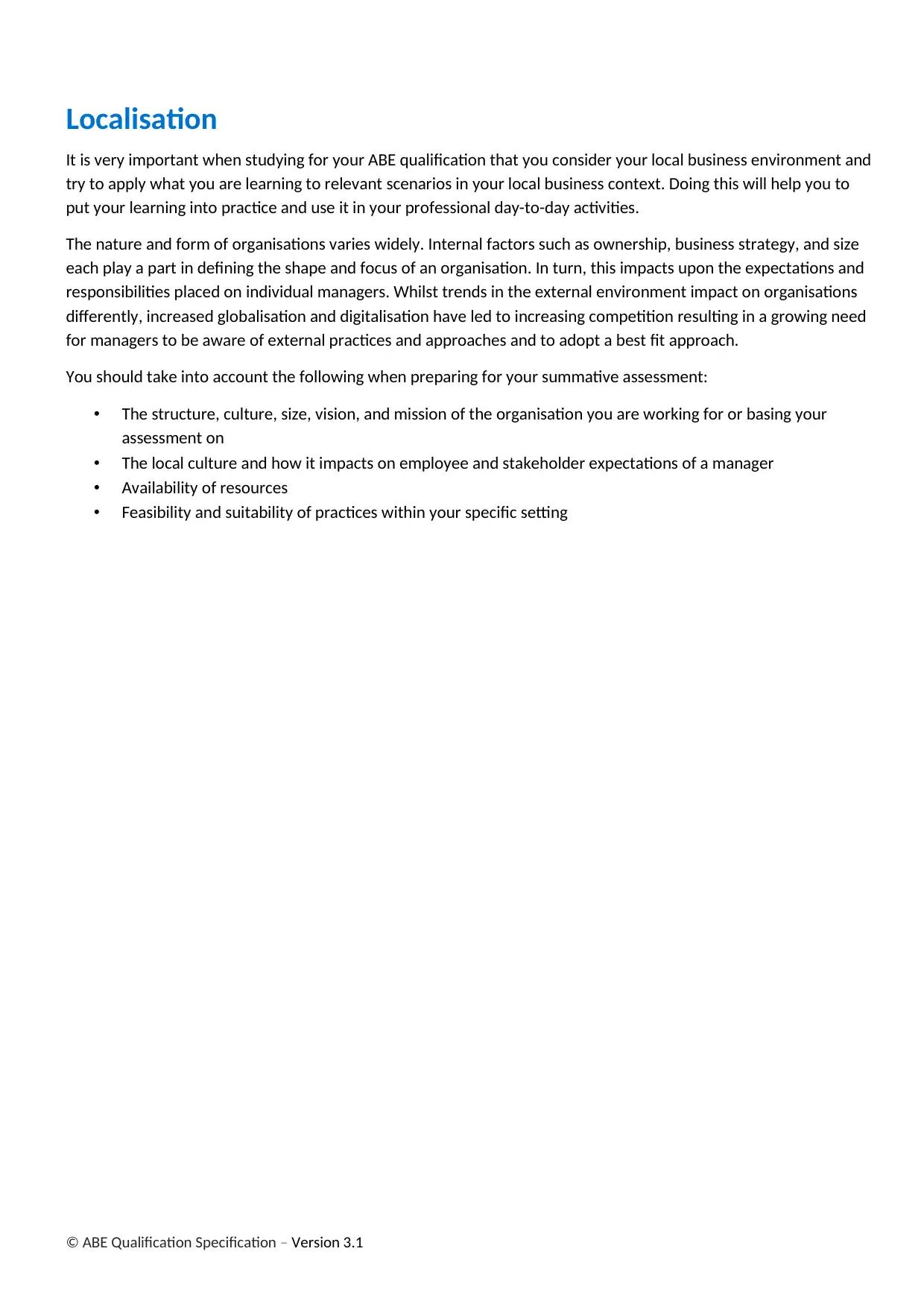
© ABE Qualification Specification – Version 3.1
Localisation
It is very important when studying for your ABE qualification that you consider your local business environment and
try to apply what you are learning to relevant scenarios in your local business context. Doing this will help you to
put your learning into practice and use it in your professional day-to-day activities.
The nature and form of organisations varies widely. Internal factors such as ownership, business strategy, and size
each play a part in defining the shape and focus of an organisation. In turn, this impacts upon the expectations and
responsibilities placed on individual managers. Whilst trends in the external environment impact on organisations
differently, increased globalisation and digitalisation have led to increasing competition resulting in a growing need
for managers to be aware of external practices and approaches and to adopt a best fit approach.
You should take into account the following when preparing for your summative assessment:
• The structure, culture, size, vision, and mission of the organisation you are working for or basing your
assessment on
• The local culture and how it impacts on employee and stakeholder expectations of a manager
• Availability of resources
• Feasibility and suitability of practices within your specific setting
Localisation
It is very important when studying for your ABE qualification that you consider your local business environment and
try to apply what you are learning to relevant scenarios in your local business context. Doing this will help you to
put your learning into practice and use it in your professional day-to-day activities.
The nature and form of organisations varies widely. Internal factors such as ownership, business strategy, and size
each play a part in defining the shape and focus of an organisation. In turn, this impacts upon the expectations and
responsibilities placed on individual managers. Whilst trends in the external environment impact on organisations
differently, increased globalisation and digitalisation have led to increasing competition resulting in a growing need
for managers to be aware of external practices and approaches and to adopt a best fit approach.
You should take into account the following when preparing for your summative assessment:
• The structure, culture, size, vision, and mission of the organisation you are working for or basing your
assessment on
• The local culture and how it impacts on employee and stakeholder expectations of a manager
• Availability of resources
• Feasibility and suitability of practices within your specific setting
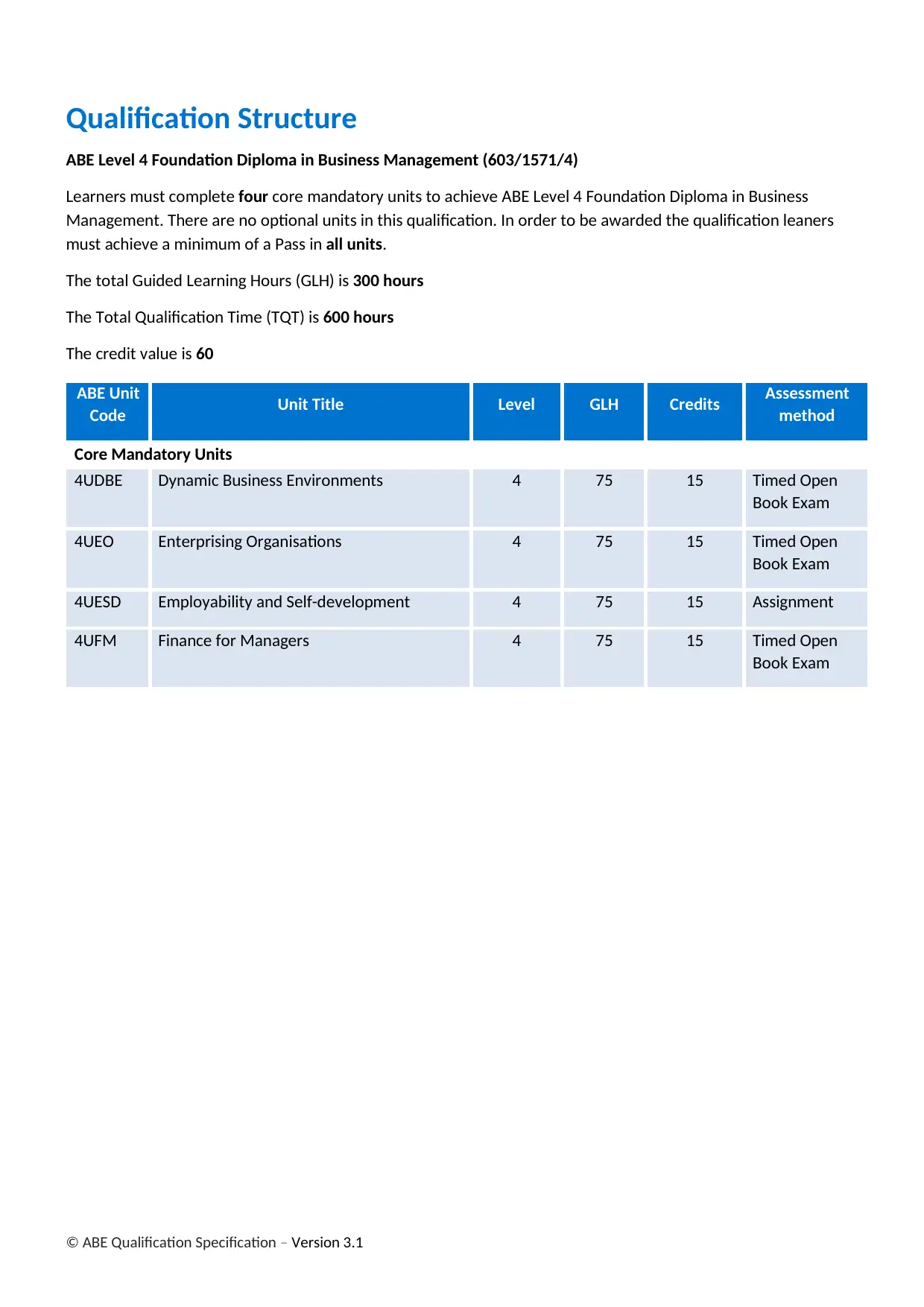
© ABE Qualification Specification – Version 3.1
Qualification Structure
ABE Level 4 Foundation Diploma in Business Management (603/1571/4)
Learners must complete four core mandatory units to achieve ABE Level 4 Foundation Diploma in Business
Management. There are no optional units in this qualification. In order to be awarded the qualification leaners
must achieve a minimum of a Pass in all units.
The total Guided Learning Hours (GLH) is 300 hours
The Total Qualification Time (TQT) is 600 hours
The credit value is 60
ABE Unit
Code Unit Title Level GLH Credits Assessment
method
Core Mandatory Units
4UDBE Dynamic Business Environments 4 75 15 Timed Open
Book Exam
4UEO Enterprising Organisations 4 75 15 Timed Open
Book Exam
4UESD Employability and Self-development 4 75 15 Assignment
4UFM Finance for Managers 4 75 15 Timed Open
Book Exam
Qualification Structure
ABE Level 4 Foundation Diploma in Business Management (603/1571/4)
Learners must complete four core mandatory units to achieve ABE Level 4 Foundation Diploma in Business
Management. There are no optional units in this qualification. In order to be awarded the qualification leaners
must achieve a minimum of a Pass in all units.
The total Guided Learning Hours (GLH) is 300 hours
The Total Qualification Time (TQT) is 600 hours
The credit value is 60
ABE Unit
Code Unit Title Level GLH Credits Assessment
method
Core Mandatory Units
4UDBE Dynamic Business Environments 4 75 15 Timed Open
Book Exam
4UEO Enterprising Organisations 4 75 15 Timed Open
Book Exam
4UESD Employability and Self-development 4 75 15 Assignment
4UFM Finance for Managers 4 75 15 Timed Open
Book Exam
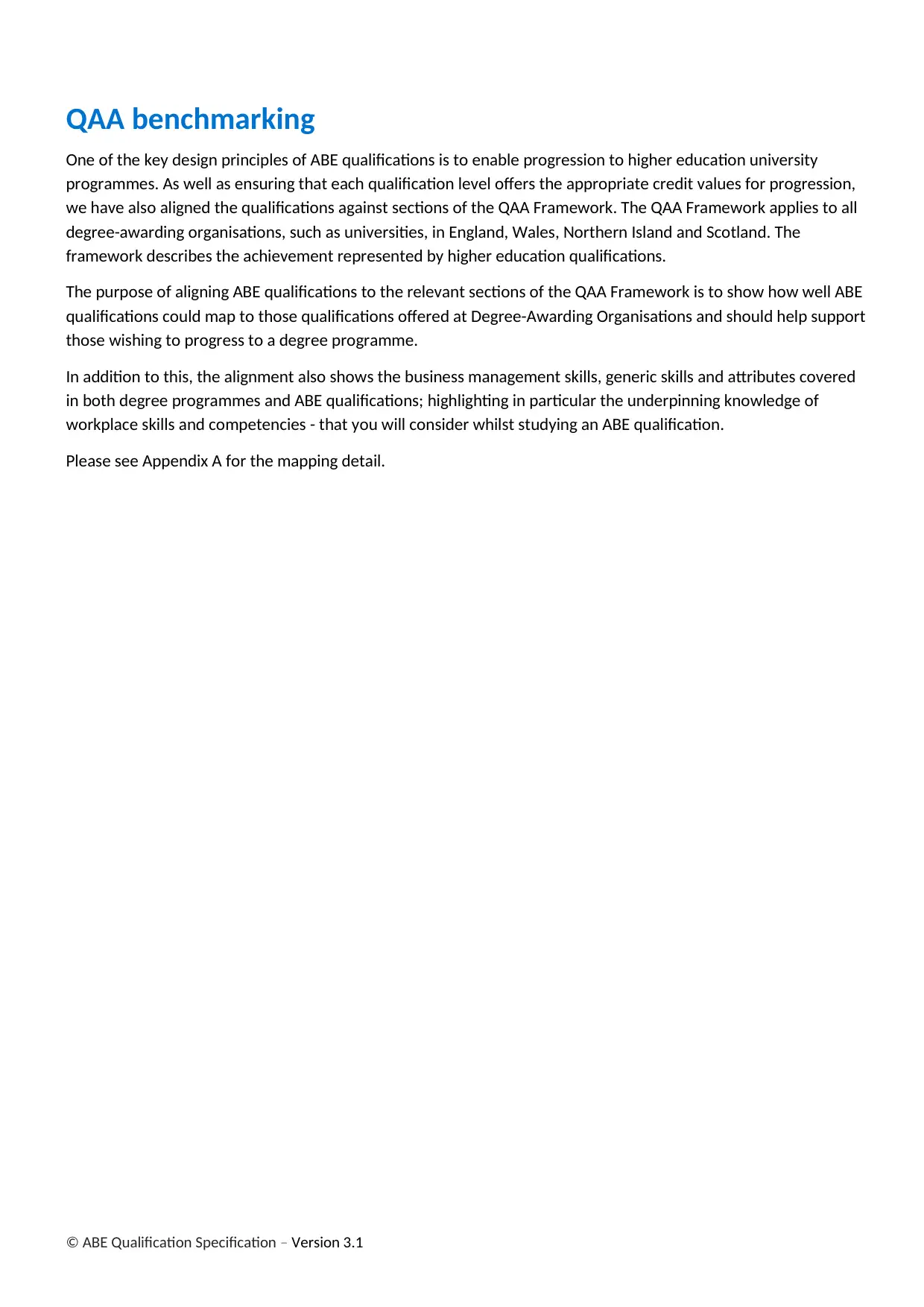
© ABE Qualification Specification – Version 3.1
QAA benchmarking
One of the key design principles of ABE qualifications is to enable progression to higher education university
programmes. As well as ensuring that each qualification level offers the appropriate credit values for progression,
we have also aligned the qualifications against sections of the QAA Framework. The QAA Framework applies to all
degree-awarding organisations, such as universities, in England, Wales, Northern Island and Scotland. The
framework describes the achievement represented by higher education qualifications.
The purpose of aligning ABE qualifications to the relevant sections of the QAA Framework is to show how well ABE
qualifications could map to those qualifications offered at Degree-Awarding Organisations and should help support
those wishing to progress to a degree programme.
In addition to this, the alignment also shows the business management skills, generic skills and attributes covered
in both degree programmes and ABE qualifications; highlighting in particular the underpinning knowledge of
workplace skills and competencies - that you will consider whilst studying an ABE qualification.
Please see Appendix A for the mapping detail.
QAA benchmarking
One of the key design principles of ABE qualifications is to enable progression to higher education university
programmes. As well as ensuring that each qualification level offers the appropriate credit values for progression,
we have also aligned the qualifications against sections of the QAA Framework. The QAA Framework applies to all
degree-awarding organisations, such as universities, in England, Wales, Northern Island and Scotland. The
framework describes the achievement represented by higher education qualifications.
The purpose of aligning ABE qualifications to the relevant sections of the QAA Framework is to show how well ABE
qualifications could map to those qualifications offered at Degree-Awarding Organisations and should help support
those wishing to progress to a degree programme.
In addition to this, the alignment also shows the business management skills, generic skills and attributes covered
in both degree programmes and ABE qualifications; highlighting in particular the underpinning knowledge of
workplace skills and competencies - that you will consider whilst studying an ABE qualification.
Please see Appendix A for the mapping detail.
Paraphrase This Document
Need a fresh take? Get an instant paraphrase of this document with our AI Paraphraser
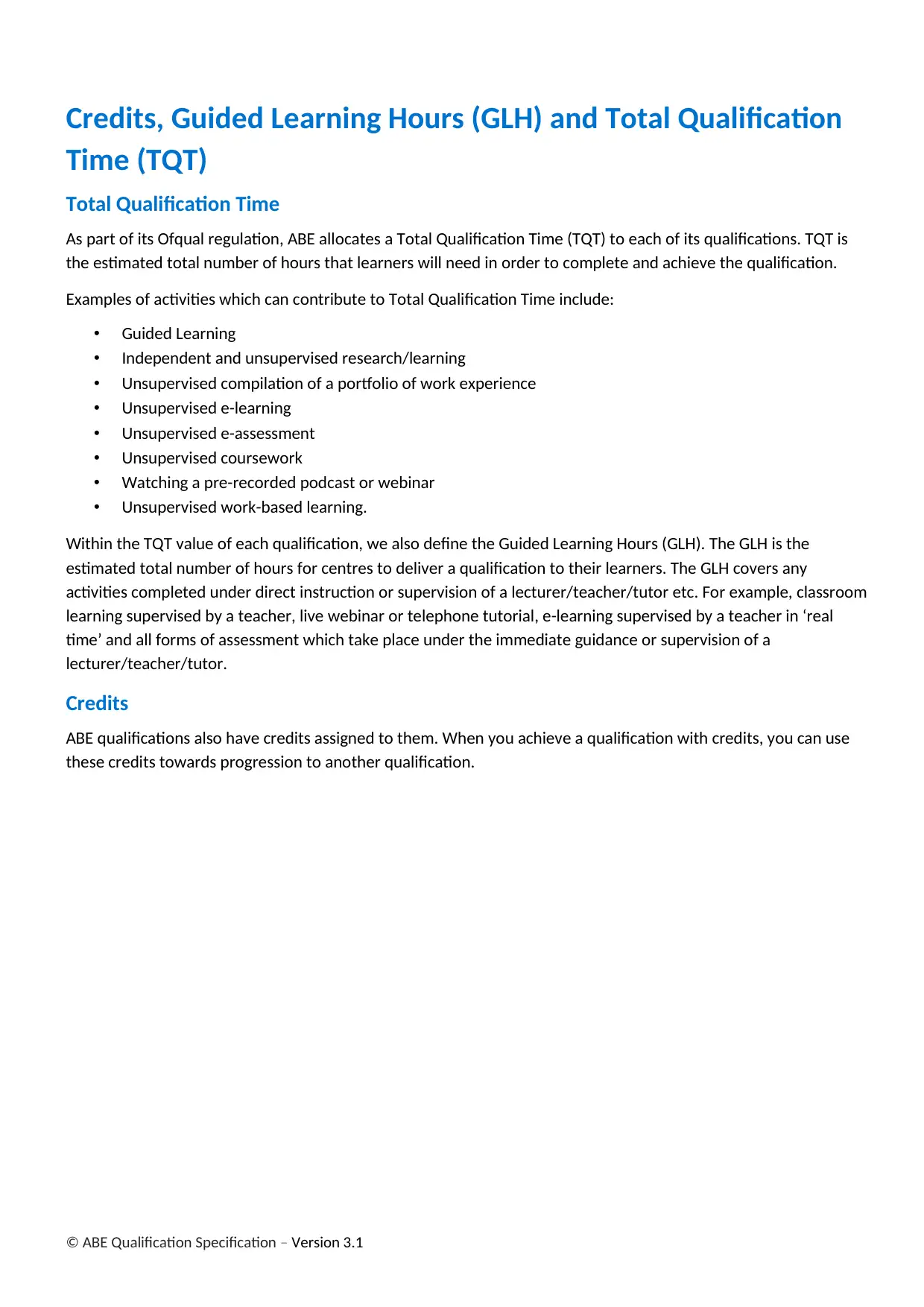
© ABE Qualification Specification – Version 3.1
Credits, Guided Learning Hours (GLH) and Total Qualification
Time (TQT)
Total Qualification Time
As part of its Ofqual regulation, ABE allocates a Total Qualification Time (TQT) to each of its qualifications. TQT is
the estimated total number of hours that learners will need in order to complete and achieve the qualification.
Examples of activities which can contribute to Total Qualification Time include:
• Guided Learning
• Independent and unsupervised research/learning
• Unsupervised compilation of a portfolio of work experience
• Unsupervised e-learning
• Unsupervised e-assessment
• Unsupervised coursework
• Watching a pre-recorded podcast or webinar
• Unsupervised work-based learning.
Within the TQT value of each qualification, we also define the Guided Learning Hours (GLH). The GLH is the
estimated total number of hours for centres to deliver a qualification to their learners. The GLH covers any
activities completed under direct instruction or supervision of a lecturer/teacher/tutor etc. For example, classroom
learning supervised by a teacher, live webinar or telephone tutorial, e-learning supervised by a teacher in ‘real
time’ and all forms of assessment which take place under the immediate guidance or supervision of a
lecturer/teacher/tutor.
Credits
ABE qualifications also have credits assigned to them. When you achieve a qualification with credits, you can use
these credits towards progression to another qualification.
Credits, Guided Learning Hours (GLH) and Total Qualification
Time (TQT)
Total Qualification Time
As part of its Ofqual regulation, ABE allocates a Total Qualification Time (TQT) to each of its qualifications. TQT is
the estimated total number of hours that learners will need in order to complete and achieve the qualification.
Examples of activities which can contribute to Total Qualification Time include:
• Guided Learning
• Independent and unsupervised research/learning
• Unsupervised compilation of a portfolio of work experience
• Unsupervised e-learning
• Unsupervised e-assessment
• Unsupervised coursework
• Watching a pre-recorded podcast or webinar
• Unsupervised work-based learning.
Within the TQT value of each qualification, we also define the Guided Learning Hours (GLH). The GLH is the
estimated total number of hours for centres to deliver a qualification to their learners. The GLH covers any
activities completed under direct instruction or supervision of a lecturer/teacher/tutor etc. For example, classroom
learning supervised by a teacher, live webinar or telephone tutorial, e-learning supervised by a teacher in ‘real
time’ and all forms of assessment which take place under the immediate guidance or supervision of a
lecturer/teacher/tutor.
Credits
ABE qualifications also have credits assigned to them. When you achieve a qualification with credits, you can use
these credits towards progression to another qualification.
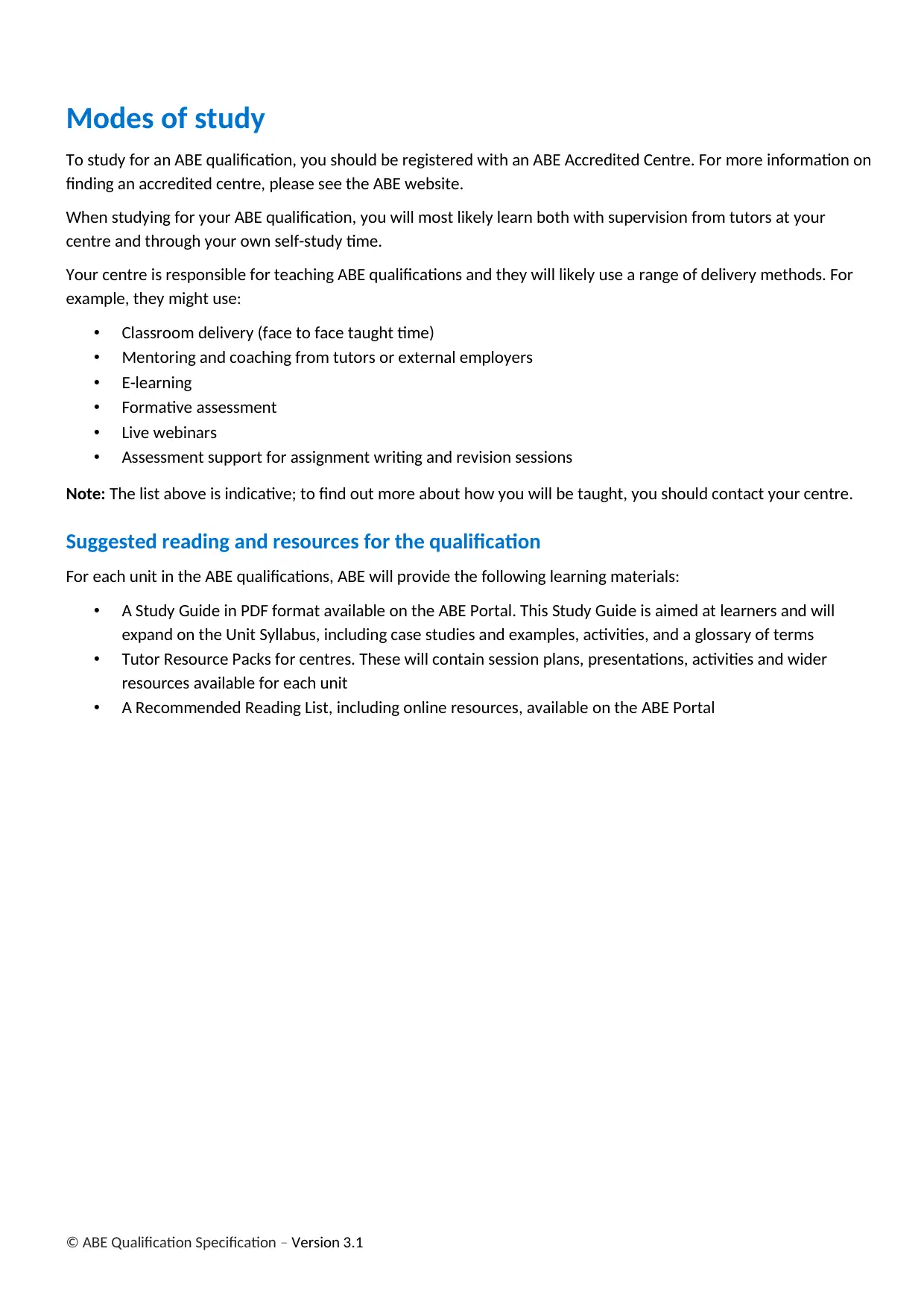
© ABE Qualification Specification – Version 3.1
Modes of study
To study for an ABE qualification, you should be registered with an ABE Accredited Centre. For more information on
finding an accredited centre, please see the ABE website.
When studying for your ABE qualification, you will most likely learn both with supervision from tutors at your
centre and through your own self-study time.
Your centre is responsible for teaching ABE qualifications and they will likely use a range of delivery methods. For
example, they might use:
• Classroom delivery (face to face taught time)
• Mentoring and coaching from tutors or external employers
• E-learning
• Formative assessment
• Live webinars
• Assessment support for assignment writing and revision sessions
Note: The list above is indicative; to find out more about how you will be taught, you should contact your centre.
Suggested reading and resources for the qualification
For each unit in the ABE qualifications, ABE will provide the following learning materials:
• A Study Guide in PDF format available on the ABE Portal. This Study Guide is aimed at learners and will
expand on the Unit Syllabus, including case studies and examples, activities, and a glossary of terms
• Tutor Resource Packs for centres. These will contain session plans, presentations, activities and wider
resources available for each unit
• A Recommended Reading List, including online resources, available on the ABE Portal
Modes of study
To study for an ABE qualification, you should be registered with an ABE Accredited Centre. For more information on
finding an accredited centre, please see the ABE website.
When studying for your ABE qualification, you will most likely learn both with supervision from tutors at your
centre and through your own self-study time.
Your centre is responsible for teaching ABE qualifications and they will likely use a range of delivery methods. For
example, they might use:
• Classroom delivery (face to face taught time)
• Mentoring and coaching from tutors or external employers
• E-learning
• Formative assessment
• Live webinars
• Assessment support for assignment writing and revision sessions
Note: The list above is indicative; to find out more about how you will be taught, you should contact your centre.
Suggested reading and resources for the qualification
For each unit in the ABE qualifications, ABE will provide the following learning materials:
• A Study Guide in PDF format available on the ABE Portal. This Study Guide is aimed at learners and will
expand on the Unit Syllabus, including case studies and examples, activities, and a glossary of terms
• Tutor Resource Packs for centres. These will contain session plans, presentations, activities and wider
resources available for each unit
• A Recommended Reading List, including online resources, available on the ABE Portal
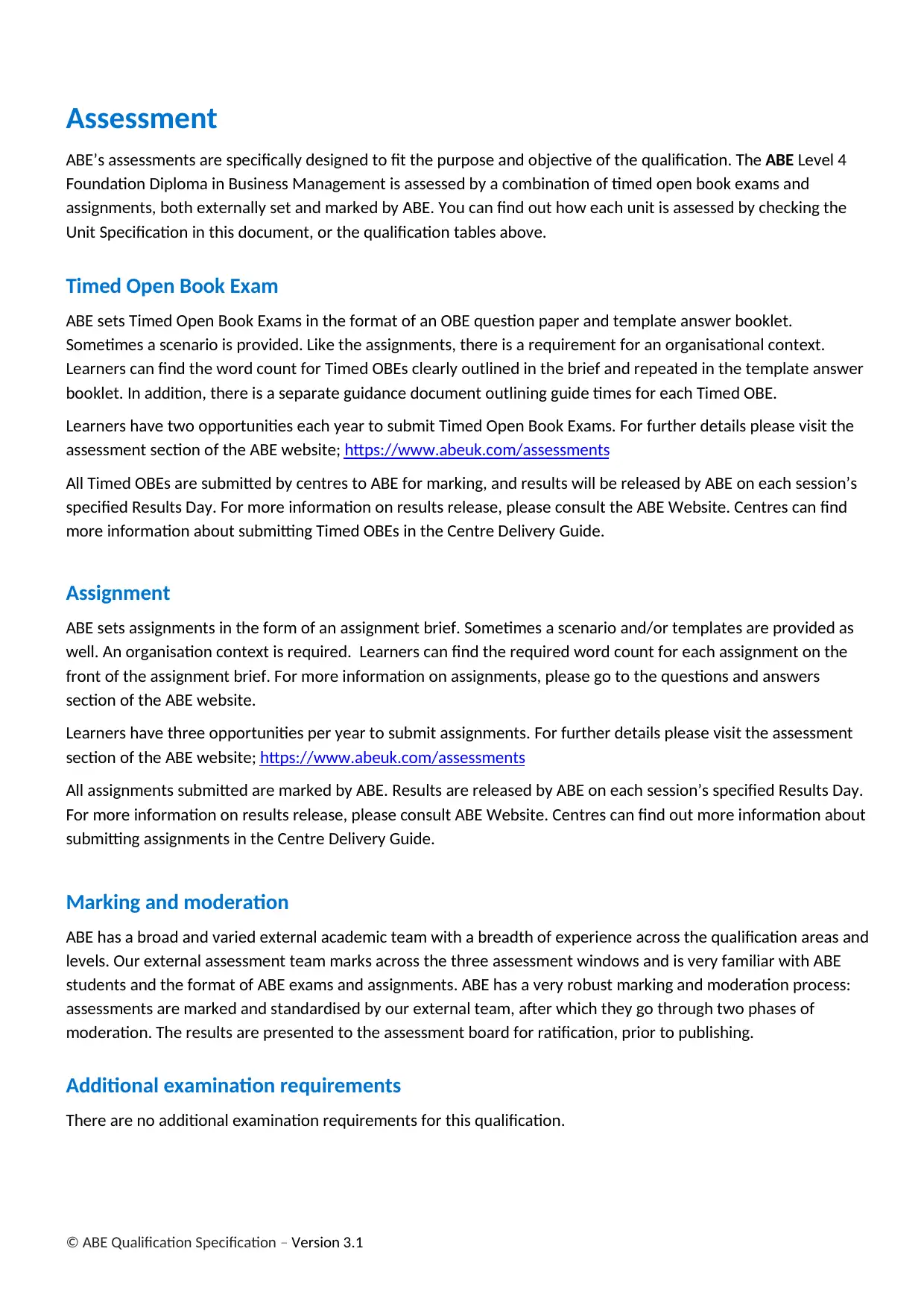
© ABE Qualification Specification – Version 3.1
Assessment
ABE’s assessments are specifically designed to fit the purpose and objective of the qualification. The ABE Level 4
Foundation Diploma in Business Management is assessed by a combination of timed open book exams and
assignments, both externally set and marked by ABE. You can find out how each unit is assessed by checking the
Unit Specification in this document, or the qualification tables above.
Timed Open Book Exam
ABE sets Timed Open Book Exams in the format of an OBE question paper and template answer booklet.
Sometimes a scenario is provided. Like the assignments, there is a requirement for an organisational context.
Learners can find the word count for Timed OBEs clearly outlined in the brief and repeated in the template answer
booklet. In addition, there is a separate guidance document outlining guide times for each Timed OBE.
Learners have two opportunities each year to submit Timed Open Book Exams. For further details please visit the
assessment section of the ABE website; https://www.abeuk.com/assessments
All Timed OBEs are submitted by centres to ABE for marking, and results will be released by ABE on each session’s
specified Results Day. For more information on results release, please consult the ABE Website. Centres can find
more information about submitting Timed OBEs in the Centre Delivery Guide.
Assignment
ABE sets assignments in the form of an assignment brief. Sometimes a scenario and/or templates are provided as
well. An organisation context is required. Learners can find the required word count for each assignment on the
front of the assignment brief. For more information on assignments, please go to the questions and answers
section of the ABE website.
Learners have three opportunities per year to submit assignments. For further details please visit the assessment
section of the ABE website; https://www.abeuk.com/assessments
All assignments submitted are marked by ABE. Results are released by ABE on each session’s specified Results Day.
For more information on results release, please consult ABE Website. Centres can find out more information about
submitting assignments in the Centre Delivery Guide.
Marking and moderation
ABE has a broad and varied external academic team with a breadth of experience across the qualification areas and
levels. Our external assessment team marks across the three assessment windows and is very familiar with ABE
students and the format of ABE exams and assignments. ABE has a very robust marking and moderation process:
assessments are marked and standardised by our external team, after which they go through two phases of
moderation. The results are presented to the assessment board for ratification, prior to publishing.
Additional examination requirements
There are no additional examination requirements for this qualification.
Assessment
ABE’s assessments are specifically designed to fit the purpose and objective of the qualification. The ABE Level 4
Foundation Diploma in Business Management is assessed by a combination of timed open book exams and
assignments, both externally set and marked by ABE. You can find out how each unit is assessed by checking the
Unit Specification in this document, or the qualification tables above.
Timed Open Book Exam
ABE sets Timed Open Book Exams in the format of an OBE question paper and template answer booklet.
Sometimes a scenario is provided. Like the assignments, there is a requirement for an organisational context.
Learners can find the word count for Timed OBEs clearly outlined in the brief and repeated in the template answer
booklet. In addition, there is a separate guidance document outlining guide times for each Timed OBE.
Learners have two opportunities each year to submit Timed Open Book Exams. For further details please visit the
assessment section of the ABE website; https://www.abeuk.com/assessments
All Timed OBEs are submitted by centres to ABE for marking, and results will be released by ABE on each session’s
specified Results Day. For more information on results release, please consult the ABE Website. Centres can find
more information about submitting Timed OBEs in the Centre Delivery Guide.
Assignment
ABE sets assignments in the form of an assignment brief. Sometimes a scenario and/or templates are provided as
well. An organisation context is required. Learners can find the required word count for each assignment on the
front of the assignment brief. For more information on assignments, please go to the questions and answers
section of the ABE website.
Learners have three opportunities per year to submit assignments. For further details please visit the assessment
section of the ABE website; https://www.abeuk.com/assessments
All assignments submitted are marked by ABE. Results are released by ABE on each session’s specified Results Day.
For more information on results release, please consult ABE Website. Centres can find out more information about
submitting assignments in the Centre Delivery Guide.
Marking and moderation
ABE has a broad and varied external academic team with a breadth of experience across the qualification areas and
levels. Our external assessment team marks across the three assessment windows and is very familiar with ABE
students and the format of ABE exams and assignments. ABE has a very robust marking and moderation process:
assessments are marked and standardised by our external team, after which they go through two phases of
moderation. The results are presented to the assessment board for ratification, prior to publishing.
Additional examination requirements
There are no additional examination requirements for this qualification.
Secure Best Marks with AI Grader
Need help grading? Try our AI Grader for instant feedback on your assignments.
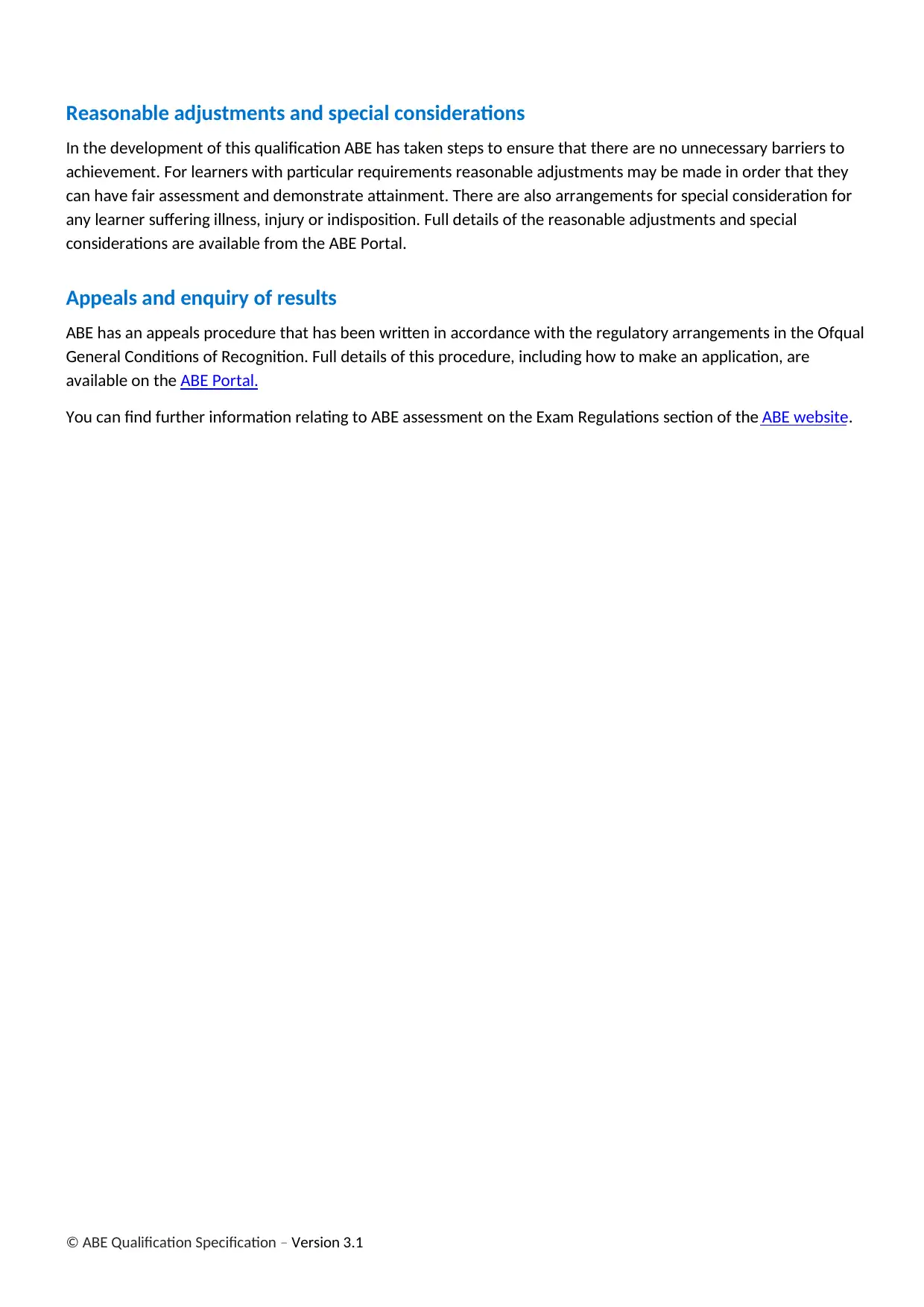
© ABE Qualification Specification – Version 3.1
Reasonable adjustments and special considerations
In the development of this qualification ABE has taken steps to ensure that there are no unnecessary barriers to
achievement. For learners with particular requirements reasonable adjustments may be made in order that they
can have fair assessment and demonstrate attainment. There are also arrangements for special consideration for
any learner suffering illness, injury or indisposition. Full details of the reasonable adjustments and special
considerations are available from the ABE Portal.
Appeals and enquiry of results
ABE has an appeals procedure that has been written in accordance with the regulatory arrangements in the Ofqual
General Conditions of Recognition. Full details of this procedure, including how to make an application, are
available on the ABE Portal.
You can find further information relating to ABE assessment on the Exam Regulations section of the ABE website.
Reasonable adjustments and special considerations
In the development of this qualification ABE has taken steps to ensure that there are no unnecessary barriers to
achievement. For learners with particular requirements reasonable adjustments may be made in order that they
can have fair assessment and demonstrate attainment. There are also arrangements for special consideration for
any learner suffering illness, injury or indisposition. Full details of the reasonable adjustments and special
considerations are available from the ABE Portal.
Appeals and enquiry of results
ABE has an appeals procedure that has been written in accordance with the regulatory arrangements in the Ofqual
General Conditions of Recognition. Full details of this procedure, including how to make an application, are
available on the ABE Portal.
You can find further information relating to ABE assessment on the Exam Regulations section of the ABE website.
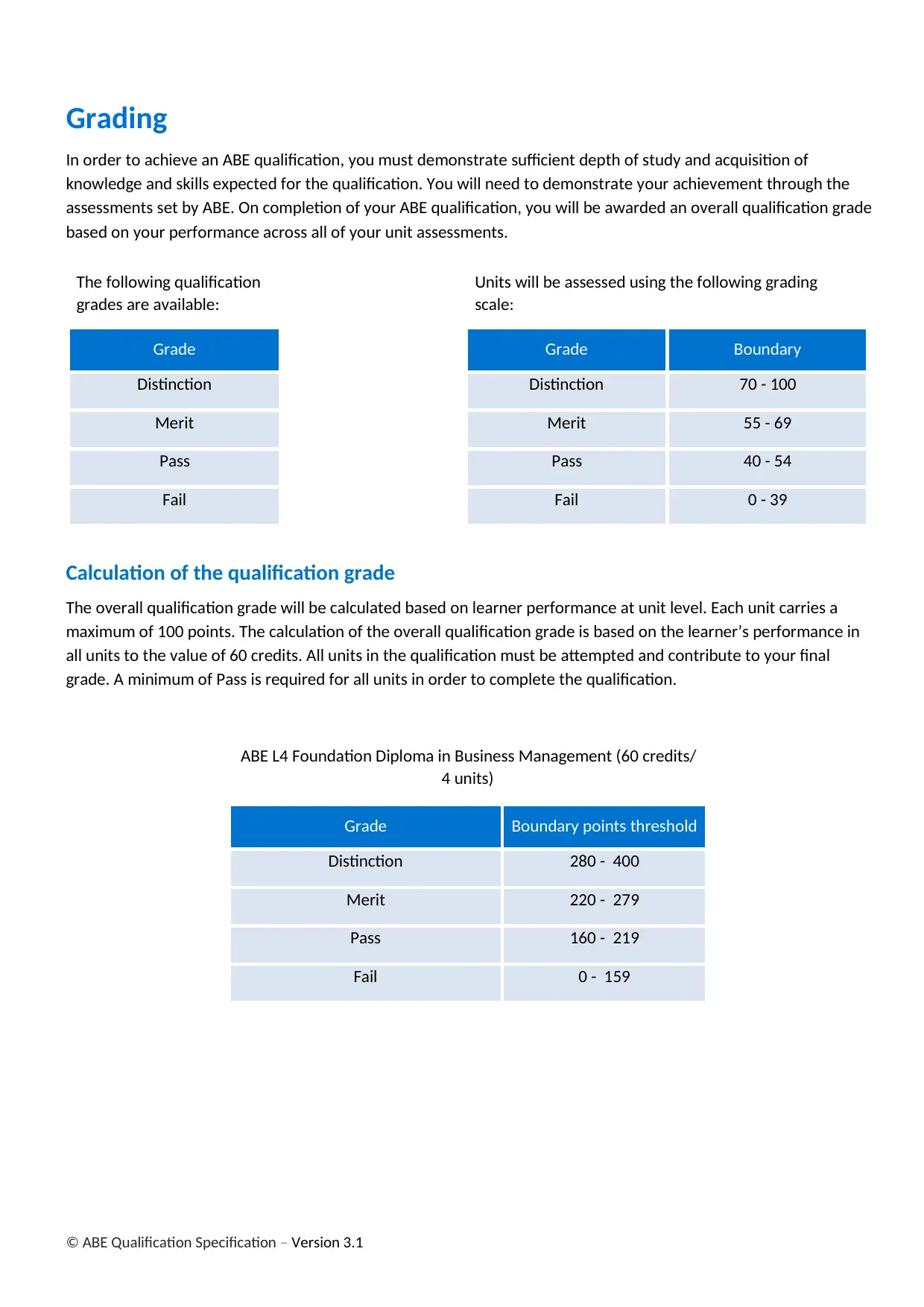
© ABE Qualification Specification – Version 3.1
Grading
In order to achieve an ABE qualification, you must demonstrate sufficient depth of study and acquisition of
knowledge and skills expected for the qualification. You will need to demonstrate your achievement through the
assessments set by ABE. On completion of your ABE qualification, you will be awarded an overall qualification grade
based on your performance across all of your unit assessments.
The following qualification
grades are available:
Units will be assessed using the following grading
scale:
Grade Grade Boundary
Distinction Distinction 70 - 100
Merit Merit 55 - 69
Pass Pass 40 - 54
Fail Fail 0 - 39
Calculation of the qualification grade
The overall qualification grade will be calculated based on learner performance at unit level. Each unit carries a
maximum of 100 points. The calculation of the overall qualification grade is based on the learner’s performance in
all units to the value of 60 credits. All units in the qualification must be attempted and contribute to your final
grade. A minimum of Pass is required for all units in order to complete the qualification.
ABE L4 Foundation Diploma in Business Management (60 credits/
4 units)
Grade Boundary points threshold
Distinction 280 - 400
Merit 220 - 279
Pass 160 - 219
Fail 0 - 159
Grading
In order to achieve an ABE qualification, you must demonstrate sufficient depth of study and acquisition of
knowledge and skills expected for the qualification. You will need to demonstrate your achievement through the
assessments set by ABE. On completion of your ABE qualification, you will be awarded an overall qualification grade
based on your performance across all of your unit assessments.
The following qualification
grades are available:
Units will be assessed using the following grading
scale:
Grade Grade Boundary
Distinction Distinction 70 - 100
Merit Merit 55 - 69
Pass Pass 40 - 54
Fail Fail 0 - 39
Calculation of the qualification grade
The overall qualification grade will be calculated based on learner performance at unit level. Each unit carries a
maximum of 100 points. The calculation of the overall qualification grade is based on the learner’s performance in
all units to the value of 60 credits. All units in the qualification must be attempted and contribute to your final
grade. A minimum of Pass is required for all units in order to complete the qualification.
ABE L4 Foundation Diploma in Business Management (60 credits/
4 units)
Grade Boundary points threshold
Distinction 280 - 400
Merit 220 - 279
Pass 160 - 219
Fail 0 - 159
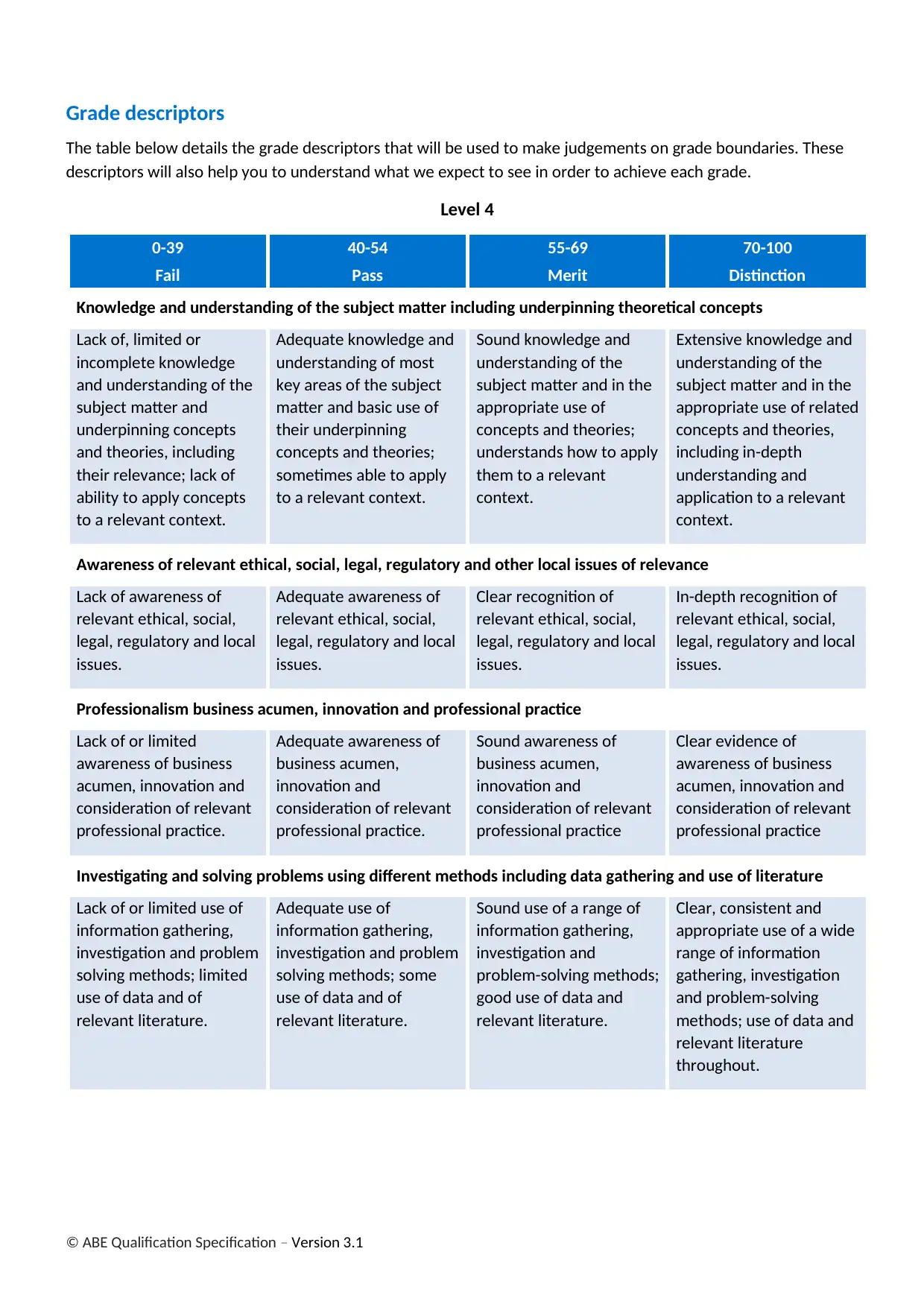
© ABE Qualification Specification – Version 3.1
Grade descriptors
The table below details the grade descriptors that will be used to make judgements on grade boundaries. These
descriptors will also help you to understand what we expect to see in order to achieve each grade.
Level 4
0-39
Fail
40-54
Pass
55-69
Merit
70-100
Distinction
Knowledge and understanding of the subject matter including underpinning theoretical concepts
Lack of, limited or
incomplete knowledge
and understanding of the
subject matter and
underpinning concepts
and theories, including
their relevance; lack of
ability to apply concepts
to a relevant context.
Adequate knowledge and
understanding of most
key areas of the subject
matter and basic use of
their underpinning
concepts and theories;
sometimes able to apply
to a relevant context.
Sound knowledge and
understanding of the
subject matter and in the
appropriate use of
concepts and theories;
understands how to apply
them to a relevant
context.
Extensive knowledge and
understanding of the
subject matter and in the
appropriate use of related
concepts and theories,
including in-depth
understanding and
application to a relevant
context.
Awareness of relevant ethical, social, legal, regulatory and other local issues of relevance
Lack of awareness of
relevant ethical, social,
legal, regulatory and local
issues.
Adequate awareness of
relevant ethical, social,
legal, regulatory and local
issues.
Clear recognition of
relevant ethical, social,
legal, regulatory and local
issues.
In-depth recognition of
relevant ethical, social,
legal, regulatory and local
issues.
Professionalism business acumen, innovation and professional practice
Lack of or limited
awareness of business
acumen, innovation and
consideration of relevant
professional practice.
Adequate awareness of
business acumen,
innovation and
consideration of relevant
professional practice.
Sound awareness of
business acumen,
innovation and
consideration of relevant
professional practice
Clear evidence of
awareness of business
acumen, innovation and
consideration of relevant
professional practice
Investigating and solving problems using different methods including data gathering and use of literature
Lack of or limited use of
information gathering,
investigation and problem
solving methods; limited
use of data and of
relevant literature.
Adequate use of
information gathering,
investigation and problem
solving methods; some
use of data and of
relevant literature.
Sound use of a range of
information gathering,
investigation and
problem-solving methods;
good use of data and
relevant literature.
Clear, consistent and
appropriate use of a wide
range of information
gathering, investigation
and problem-solving
methods; use of data and
relevant literature
throughout.
Grade descriptors
The table below details the grade descriptors that will be used to make judgements on grade boundaries. These
descriptors will also help you to understand what we expect to see in order to achieve each grade.
Level 4
0-39
Fail
40-54
Pass
55-69
Merit
70-100
Distinction
Knowledge and understanding of the subject matter including underpinning theoretical concepts
Lack of, limited or
incomplete knowledge
and understanding of the
subject matter and
underpinning concepts
and theories, including
their relevance; lack of
ability to apply concepts
to a relevant context.
Adequate knowledge and
understanding of most
key areas of the subject
matter and basic use of
their underpinning
concepts and theories;
sometimes able to apply
to a relevant context.
Sound knowledge and
understanding of the
subject matter and in the
appropriate use of
concepts and theories;
understands how to apply
them to a relevant
context.
Extensive knowledge and
understanding of the
subject matter and in the
appropriate use of related
concepts and theories,
including in-depth
understanding and
application to a relevant
context.
Awareness of relevant ethical, social, legal, regulatory and other local issues of relevance
Lack of awareness of
relevant ethical, social,
legal, regulatory and local
issues.
Adequate awareness of
relevant ethical, social,
legal, regulatory and local
issues.
Clear recognition of
relevant ethical, social,
legal, regulatory and local
issues.
In-depth recognition of
relevant ethical, social,
legal, regulatory and local
issues.
Professionalism business acumen, innovation and professional practice
Lack of or limited
awareness of business
acumen, innovation and
consideration of relevant
professional practice.
Adequate awareness of
business acumen,
innovation and
consideration of relevant
professional practice.
Sound awareness of
business acumen,
innovation and
consideration of relevant
professional practice
Clear evidence of
awareness of business
acumen, innovation and
consideration of relevant
professional practice
Investigating and solving problems using different methods including data gathering and use of literature
Lack of or limited use of
information gathering,
investigation and problem
solving methods; limited
use of data and of
relevant literature.
Adequate use of
information gathering,
investigation and problem
solving methods; some
use of data and of
relevant literature.
Sound use of a range of
information gathering,
investigation and
problem-solving methods;
good use of data and
relevant literature.
Clear, consistent and
appropriate use of a wide
range of information
gathering, investigation
and problem-solving
methods; use of data and
relevant literature
throughout.
Paraphrase This Document
Need a fresh take? Get an instant paraphrase of this document with our AI Paraphraser
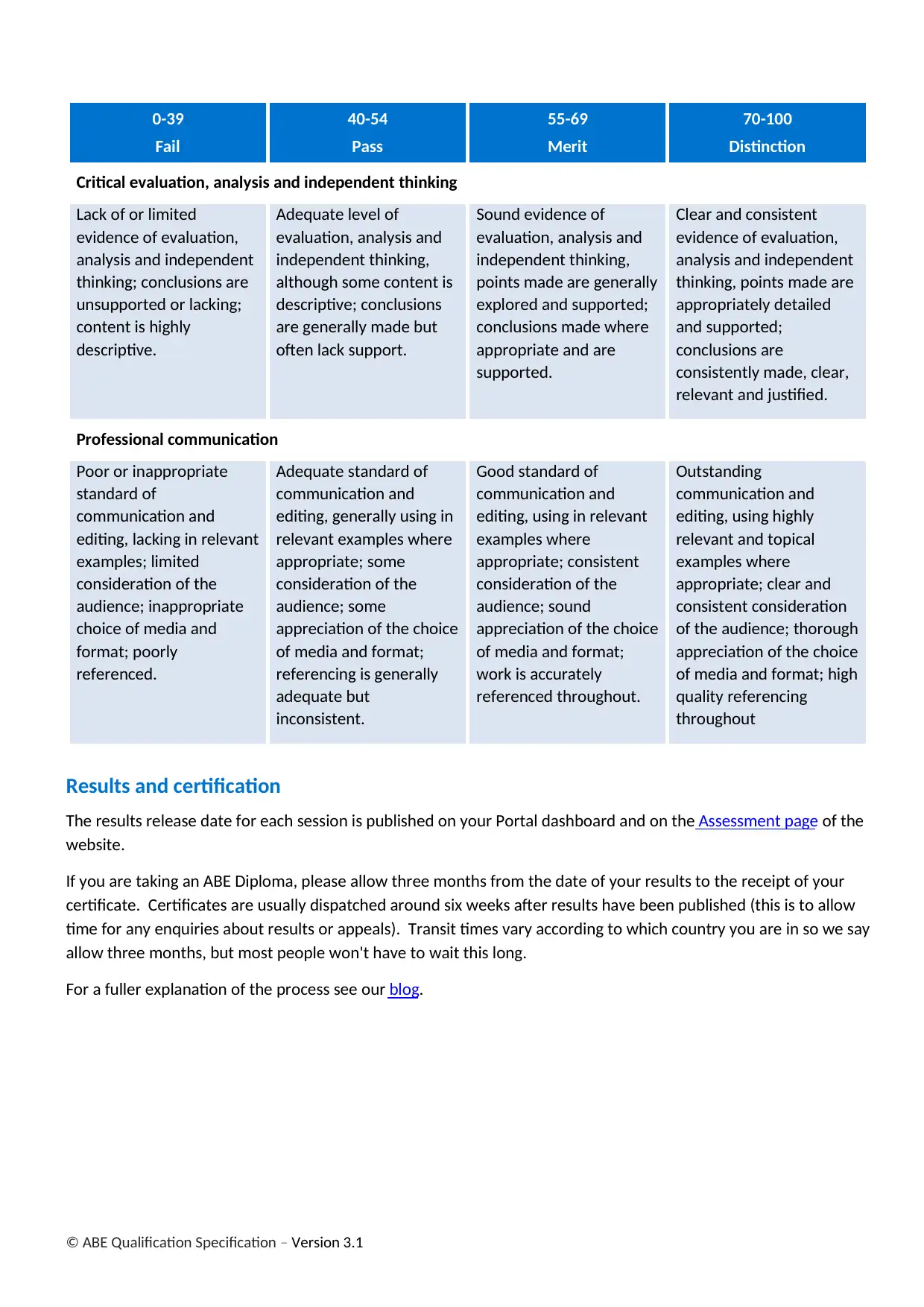
© ABE Qualification Specification – Version 3.1
0-39
Fail
40-54
Pass
55-69
Merit
70-100
Distinction
Critical evaluation, analysis and independent thinking
Lack of or limited
evidence of evaluation,
analysis and independent
thinking; conclusions are
unsupported or lacking;
content is highly
descriptive.
Adequate level of
evaluation, analysis and
independent thinking,
although some content is
descriptive; conclusions
are generally made but
often lack support.
Sound evidence of
evaluation, analysis and
independent thinking,
points made are generally
explored and supported;
conclusions made where
appropriate and are
supported.
Clear and consistent
evidence of evaluation,
analysis and independent
thinking, points made are
appropriately detailed
and supported;
conclusions are
consistently made, clear,
relevant and justified.
Professional communication
Poor or inappropriate
standard of
communication and
editing, lacking in relevant
examples; limited
consideration of the
audience; inappropriate
choice of media and
format; poorly
referenced.
Adequate standard of
communication and
editing, generally using in
relevant examples where
appropriate; some
consideration of the
audience; some
appreciation of the choice
of media and format;
referencing is generally
adequate but
inconsistent.
Good standard of
communication and
editing, using in relevant
examples where
appropriate; consistent
consideration of the
audience; sound
appreciation of the choice
of media and format;
work is accurately
referenced throughout.
Outstanding
communication and
editing, using highly
relevant and topical
examples where
appropriate; clear and
consistent consideration
of the audience; thorough
appreciation of the choice
of media and format; high
quality referencing
throughout
Results and certification
The results release date for each session is published on your Portal dashboard and on the Assessment page of the
website.
If you are taking an ABE Diploma, please allow three months from the date of your results to the receipt of your
certificate. Certificates are usually dispatched around six weeks after results have been published (this is to allow
time for any enquiries about results or appeals). Transit times vary according to which country you are in so we say
allow three months, but most people won't have to wait this long.
For a fuller explanation of the process see our blog.
0-39
Fail
40-54
Pass
55-69
Merit
70-100
Distinction
Critical evaluation, analysis and independent thinking
Lack of or limited
evidence of evaluation,
analysis and independent
thinking; conclusions are
unsupported or lacking;
content is highly
descriptive.
Adequate level of
evaluation, analysis and
independent thinking,
although some content is
descriptive; conclusions
are generally made but
often lack support.
Sound evidence of
evaluation, analysis and
independent thinking,
points made are generally
explored and supported;
conclusions made where
appropriate and are
supported.
Clear and consistent
evidence of evaluation,
analysis and independent
thinking, points made are
appropriately detailed
and supported;
conclusions are
consistently made, clear,
relevant and justified.
Professional communication
Poor or inappropriate
standard of
communication and
editing, lacking in relevant
examples; limited
consideration of the
audience; inappropriate
choice of media and
format; poorly
referenced.
Adequate standard of
communication and
editing, generally using in
relevant examples where
appropriate; some
consideration of the
audience; some
appreciation of the choice
of media and format;
referencing is generally
adequate but
inconsistent.
Good standard of
communication and
editing, using in relevant
examples where
appropriate; consistent
consideration of the
audience; sound
appreciation of the choice
of media and format;
work is accurately
referenced throughout.
Outstanding
communication and
editing, using highly
relevant and topical
examples where
appropriate; clear and
consistent consideration
of the audience; thorough
appreciation of the choice
of media and format; high
quality referencing
throughout
Results and certification
The results release date for each session is published on your Portal dashboard and on the Assessment page of the
website.
If you are taking an ABE Diploma, please allow three months from the date of your results to the receipt of your
certificate. Certificates are usually dispatched around six weeks after results have been published (this is to allow
time for any enquiries about results or appeals). Transit times vary according to which country you are in so we say
allow three months, but most people won't have to wait this long.
For a fuller explanation of the process see our blog.
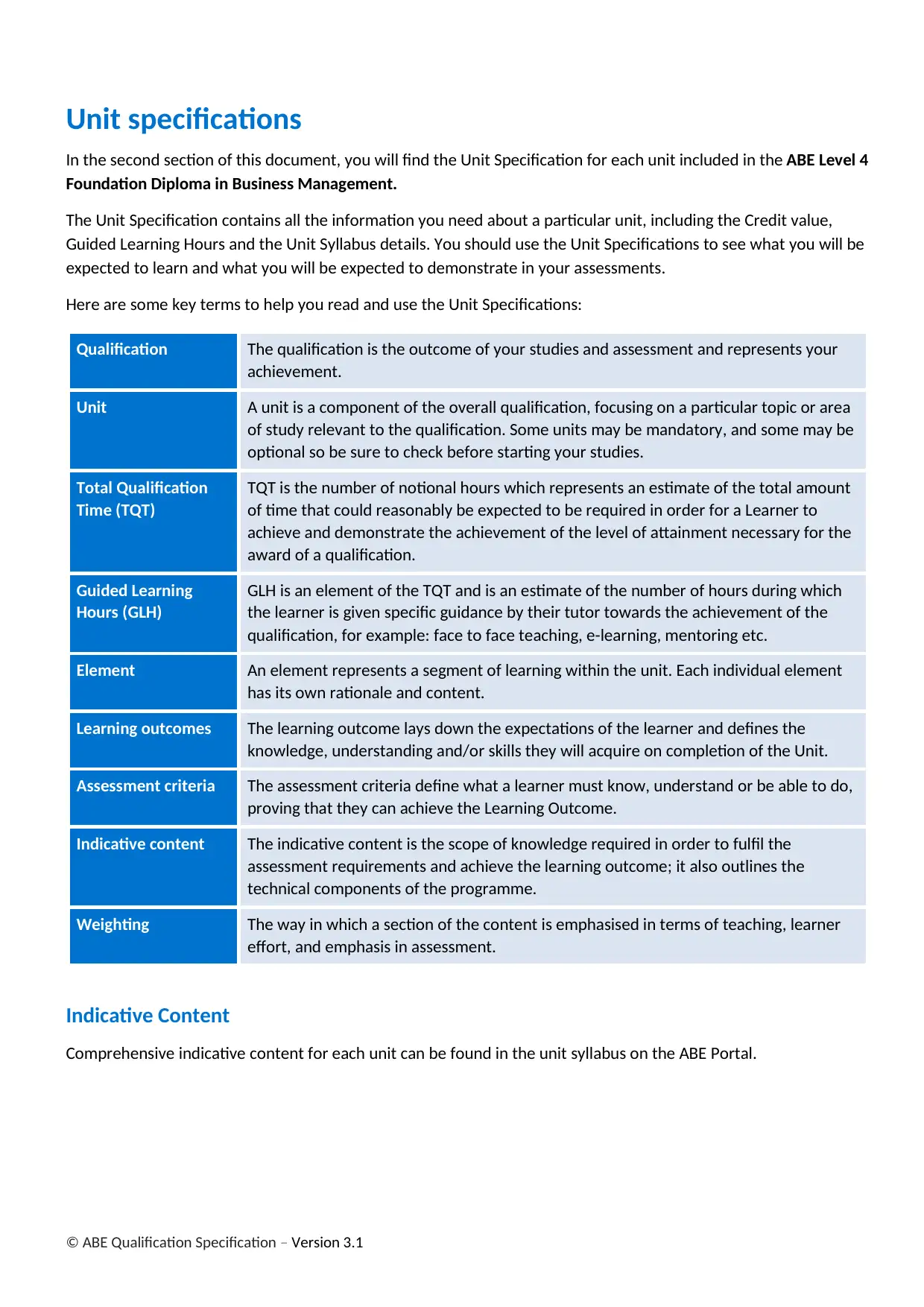
© ABE Qualification Specification – Version 3.1
Unit specifications
In the second section of this document, you will find the Unit Specification for each unit included in the ABE Level 4
Foundation Diploma in Business Management.
The Unit Specification contains all the information you need about a particular unit, including the Credit value,
Guided Learning Hours and the Unit Syllabus details. You should use the Unit Specifications to see what you will be
expected to learn and what you will be expected to demonstrate in your assessments.
Here are some key terms to help you read and use the Unit Specifications:
Qualification The qualification is the outcome of your studies and assessment and represents your
achievement.
Unit A unit is a component of the overall qualification, focusing on a particular topic or area
of study relevant to the qualification. Some units may be mandatory, and some may be
optional so be sure to check before starting your studies.
Total Qualification
Time (TQT)
TQT is the number of notional hours which represents an estimate of the total amount
of time that could reasonably be expected to be required in order for a Learner to
achieve and demonstrate the achievement of the level of attainment necessary for the
award of a qualification.
Guided Learning
Hours (GLH)
GLH is an element of the TQT and is an estimate of the number of hours during which
the learner is given specific guidance by their tutor towards the achievement of the
qualification, for example: face to face teaching, e-learning, mentoring etc.
Element An element represents a segment of learning within the unit. Each individual element
has its own rationale and content.
Learning outcomes The learning outcome lays down the expectations of the learner and defines the
knowledge, understanding and/or skills they will acquire on completion of the Unit.
Assessment criteria The assessment criteria define what a learner must know, understand or be able to do,
proving that they can achieve the Learning Outcome.
Indicative content The indicative content is the scope of knowledge required in order to fulfil the
assessment requirements and achieve the learning outcome; it also outlines the
technical components of the programme.
Weighting The way in which a section of the content is emphasised in terms of teaching, learner
effort, and emphasis in assessment.
Indicative Content
Comprehensive indicative content for each unit can be found in the unit syllabus on the ABE Portal.
Unit specifications
In the second section of this document, you will find the Unit Specification for each unit included in the ABE Level 4
Foundation Diploma in Business Management.
The Unit Specification contains all the information you need about a particular unit, including the Credit value,
Guided Learning Hours and the Unit Syllabus details. You should use the Unit Specifications to see what you will be
expected to learn and what you will be expected to demonstrate in your assessments.
Here are some key terms to help you read and use the Unit Specifications:
Qualification The qualification is the outcome of your studies and assessment and represents your
achievement.
Unit A unit is a component of the overall qualification, focusing on a particular topic or area
of study relevant to the qualification. Some units may be mandatory, and some may be
optional so be sure to check before starting your studies.
Total Qualification
Time (TQT)
TQT is the number of notional hours which represents an estimate of the total amount
of time that could reasonably be expected to be required in order for a Learner to
achieve and demonstrate the achievement of the level of attainment necessary for the
award of a qualification.
Guided Learning
Hours (GLH)
GLH is an element of the TQT and is an estimate of the number of hours during which
the learner is given specific guidance by their tutor towards the achievement of the
qualification, for example: face to face teaching, e-learning, mentoring etc.
Element An element represents a segment of learning within the unit. Each individual element
has its own rationale and content.
Learning outcomes The learning outcome lays down the expectations of the learner and defines the
knowledge, understanding and/or skills they will acquire on completion of the Unit.
Assessment criteria The assessment criteria define what a learner must know, understand or be able to do,
proving that they can achieve the Learning Outcome.
Indicative content The indicative content is the scope of knowledge required in order to fulfil the
assessment requirements and achieve the learning outcome; it also outlines the
technical components of the programme.
Weighting The way in which a section of the content is emphasised in terms of teaching, learner
effort, and emphasis in assessment.
Indicative Content
Comprehensive indicative content for each unit can be found in the unit syllabus on the ABE Portal.
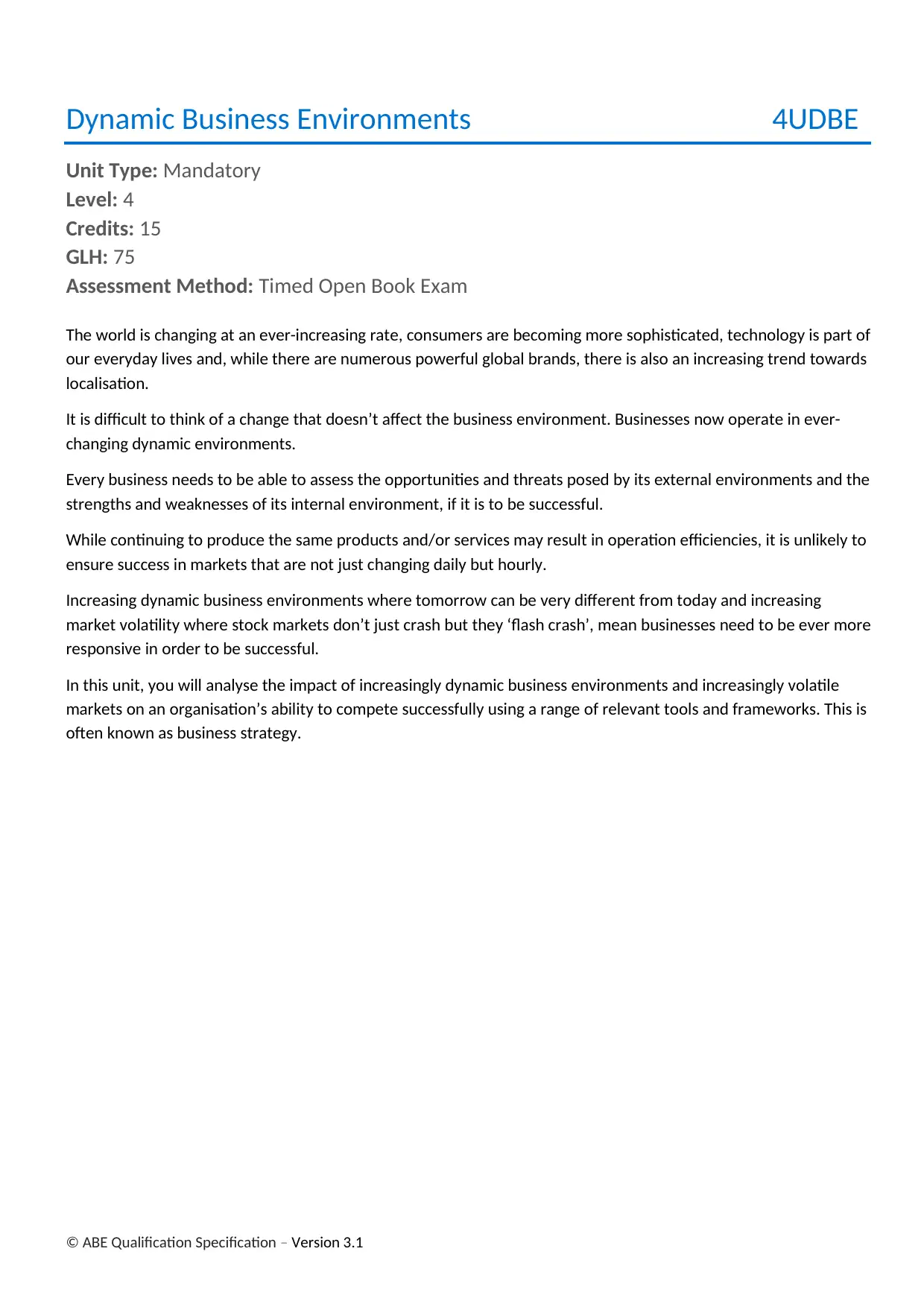
© ABE Qualification Specification – Version 3.1
Dynamic Business Environments 4UDBE
Unit Type: Mandatory
Level: 4
Credits: 15
GLH: 75
Assessment Method: Timed Open Book Exam
The world is changing at an ever-increasing rate, consumers are becoming more sophisticated, technology is part of
our everyday lives and, while there are numerous powerful global brands, there is also an increasing trend towards
localisation.
It is difficult to think of a change that doesn’t affect the business environment. Businesses now operate in ever-
changing dynamic environments.
Every business needs to be able to assess the opportunities and threats posed by its external environments and the
strengths and weaknesses of its internal environment, if it is to be successful.
While continuing to produce the same products and/or services may result in operation efficiencies, it is unlikely to
ensure success in markets that are not just changing daily but hourly.
Increasing dynamic business environments where tomorrow can be very different from today and increasing
market volatility where stock markets don’t just crash but they ‘flash crash’, mean businesses need to be ever more
responsive in order to be successful.
In this unit, you will analyse the impact of increasingly dynamic business environments and increasingly volatile
markets on an organisation’s ability to compete successfully using a range of relevant tools and frameworks. This is
often known as business strategy.
Dynamic Business Environments 4UDBE
Unit Type: Mandatory
Level: 4
Credits: 15
GLH: 75
Assessment Method: Timed Open Book Exam
The world is changing at an ever-increasing rate, consumers are becoming more sophisticated, technology is part of
our everyday lives and, while there are numerous powerful global brands, there is also an increasing trend towards
localisation.
It is difficult to think of a change that doesn’t affect the business environment. Businesses now operate in ever-
changing dynamic environments.
Every business needs to be able to assess the opportunities and threats posed by its external environments and the
strengths and weaknesses of its internal environment, if it is to be successful.
While continuing to produce the same products and/or services may result in operation efficiencies, it is unlikely to
ensure success in markets that are not just changing daily but hourly.
Increasing dynamic business environments where tomorrow can be very different from today and increasing
market volatility where stock markets don’t just crash but they ‘flash crash’, mean businesses need to be ever more
responsive in order to be successful.
In this unit, you will analyse the impact of increasingly dynamic business environments and increasingly volatile
markets on an organisation’s ability to compete successfully using a range of relevant tools and frameworks. This is
often known as business strategy.
Secure Best Marks with AI Grader
Need help grading? Try our AI Grader for instant feedback on your assignments.
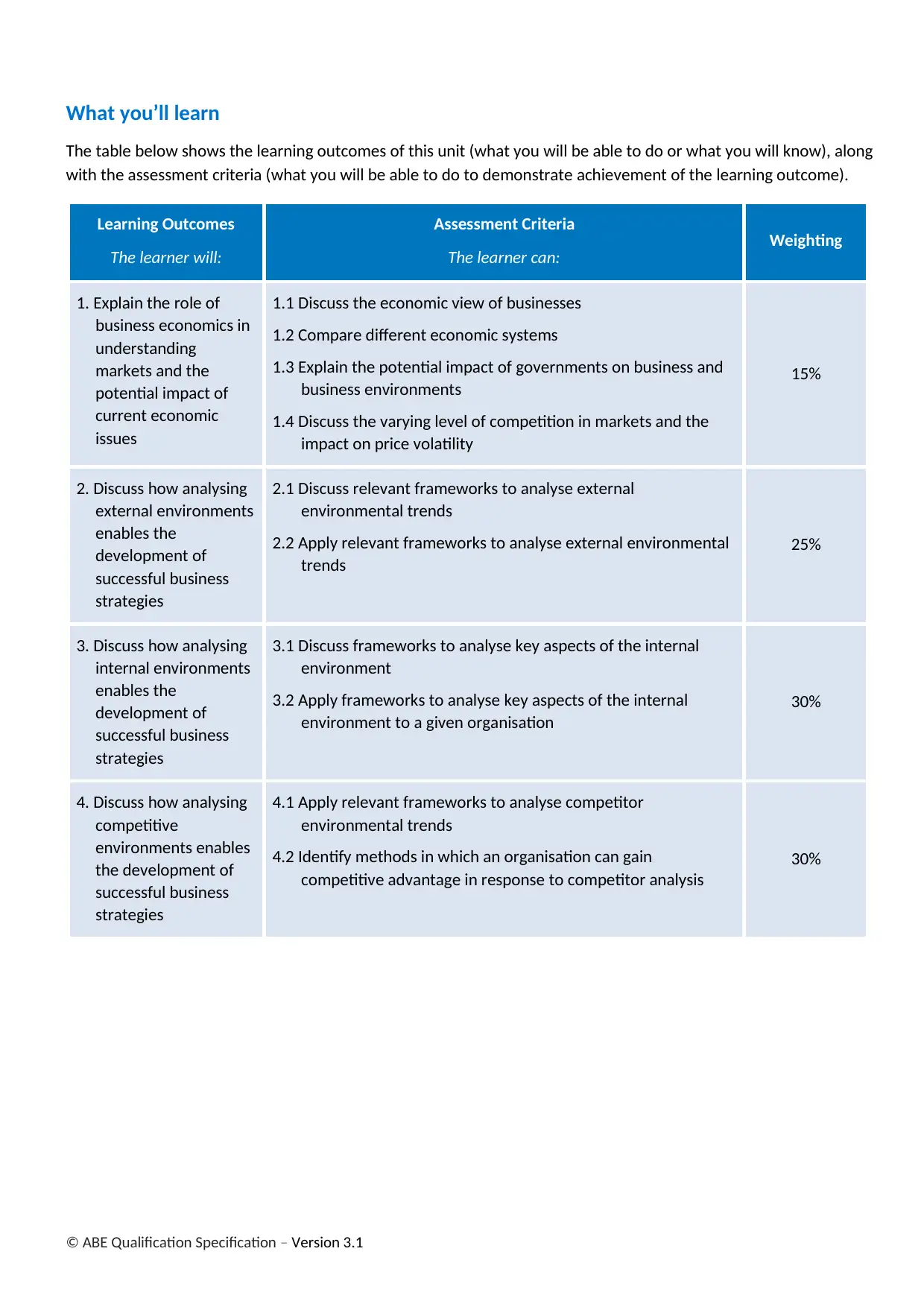
© ABE Qualification Specification – Version 3.1
What you’ll learn
The table below shows the learning outcomes of this unit (what you will be able to do or what you will know), along
with the assessment criteria (what you will be able to do to demonstrate achievement of the learning outcome).
Learning Outcomes
The learner will:
Assessment Criteria
The learner can: Weighting
1. Explain the role of
business economics in
understanding
markets and the
potential impact of
current economic
issues
1.1 Discuss the economic view of businesses
1.2 Compare different economic systems
1.3 Explain the potential impact of governments on business and
business environments
1.4 Discuss the varying level of competition in markets and the
impact on price volatility
15%
2. Discuss how analysing
external environments
enables the
development of
successful business
strategies
2.1 Discuss relevant frameworks to analyse external
environmental trends
2.2 Apply relevant frameworks to analyse external environmental
trends
25%
3. Discuss how analysing
internal environments
enables the
development of
successful business
strategies
3.1 Discuss frameworks to analyse key aspects of the internal
environment
3.2 Apply frameworks to analyse key aspects of the internal
environment to a given organisation
30%
4. Discuss how analysing
competitive
environments enables
the development of
successful business
strategies
4.1 Apply relevant frameworks to analyse competitor
environmental trends
4.2 Identify methods in which an organisation can gain
competitive advantage in response to competitor analysis
30%
What you’ll learn
The table below shows the learning outcomes of this unit (what you will be able to do or what you will know), along
with the assessment criteria (what you will be able to do to demonstrate achievement of the learning outcome).
Learning Outcomes
The learner will:
Assessment Criteria
The learner can: Weighting
1. Explain the role of
business economics in
understanding
markets and the
potential impact of
current economic
issues
1.1 Discuss the economic view of businesses
1.2 Compare different economic systems
1.3 Explain the potential impact of governments on business and
business environments
1.4 Discuss the varying level of competition in markets and the
impact on price volatility
15%
2. Discuss how analysing
external environments
enables the
development of
successful business
strategies
2.1 Discuss relevant frameworks to analyse external
environmental trends
2.2 Apply relevant frameworks to analyse external environmental
trends
25%
3. Discuss how analysing
internal environments
enables the
development of
successful business
strategies
3.1 Discuss frameworks to analyse key aspects of the internal
environment
3.2 Apply frameworks to analyse key aspects of the internal
environment to a given organisation
30%
4. Discuss how analysing
competitive
environments enables
the development of
successful business
strategies
4.1 Apply relevant frameworks to analyse competitor
environmental trends
4.2 Identify methods in which an organisation can gain
competitive advantage in response to competitor analysis
30%
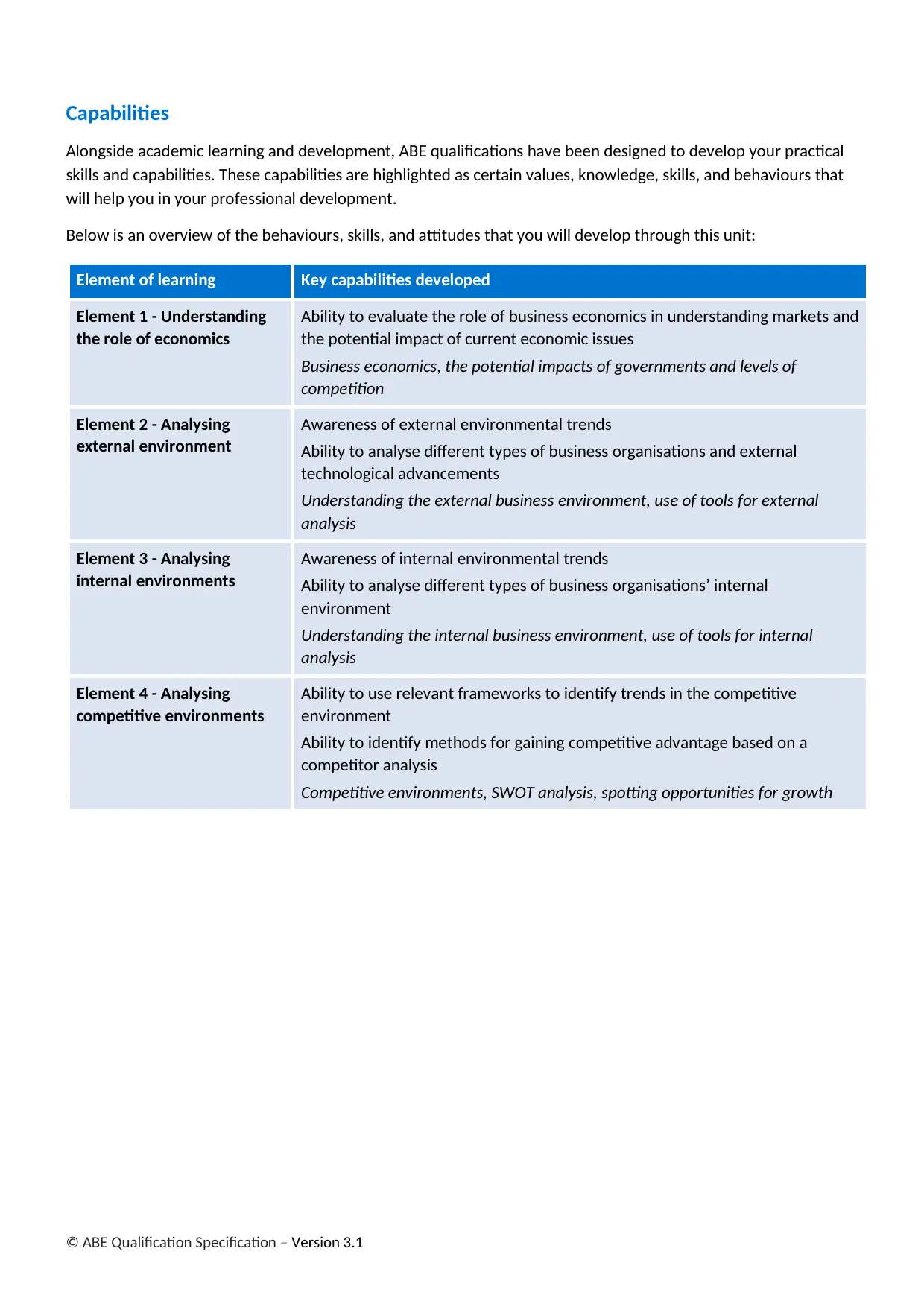
© ABE Qualification Specification – Version 3.1
Capabilities
Alongside academic learning and development, ABE qualifications have been designed to develop your practical
skills and capabilities. These capabilities are highlighted as certain values, knowledge, skills, and behaviours that
will help you in your professional development.
Below is an overview of the behaviours, skills, and attitudes that you will develop through this unit:
Element of learning Key capabilities developed
Element 1 - Understanding
the role of economics
Ability to evaluate the role of business economics in understanding markets and
the potential impact of current economic issues
Business economics, the potential impacts of governments and levels of
competition
Element 2 - Analysing
external environment
Awareness of external environmental trends
Ability to analyse different types of business organisations and external
technological advancements
Understanding the external business environment, use of tools for external
analysis
Element 3 - Analysing
internal environments
Awareness of internal environmental trends
Ability to analyse different types of business organisations’ internal
environment
Understanding the internal business environment, use of tools for internal
analysis
Element 4 - Analysing
competitive environments
Ability to use relevant frameworks to identify trends in the competitive
environment
Ability to identify methods for gaining competitive advantage based on a
competitor analysis
Competitive environments, SWOT analysis, spotting opportunities for growth
Capabilities
Alongside academic learning and development, ABE qualifications have been designed to develop your practical
skills and capabilities. These capabilities are highlighted as certain values, knowledge, skills, and behaviours that
will help you in your professional development.
Below is an overview of the behaviours, skills, and attitudes that you will develop through this unit:
Element of learning Key capabilities developed
Element 1 - Understanding
the role of economics
Ability to evaluate the role of business economics in understanding markets and
the potential impact of current economic issues
Business economics, the potential impacts of governments and levels of
competition
Element 2 - Analysing
external environment
Awareness of external environmental trends
Ability to analyse different types of business organisations and external
technological advancements
Understanding the external business environment, use of tools for external
analysis
Element 3 - Analysing
internal environments
Awareness of internal environmental trends
Ability to analyse different types of business organisations’ internal
environment
Understanding the internal business environment, use of tools for internal
analysis
Element 4 - Analysing
competitive environments
Ability to use relevant frameworks to identify trends in the competitive
environment
Ability to identify methods for gaining competitive advantage based on a
competitor analysis
Competitive environments, SWOT analysis, spotting opportunities for growth
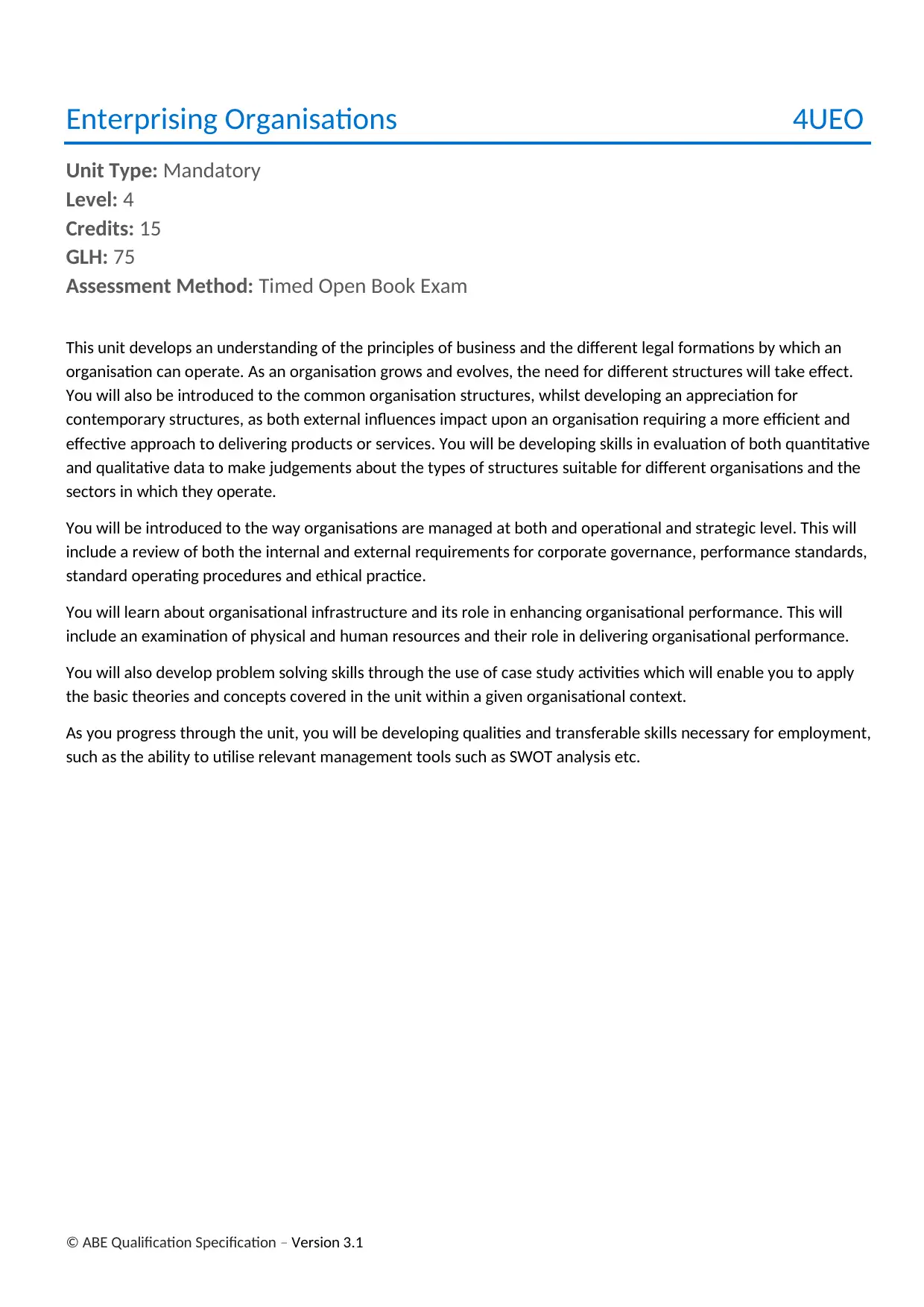
© ABE Qualification Specification – Version 3.1
Enterprising Organisations 4UEO
Unit Type: Mandatory
Level: 4
Credits: 15
GLH: 75
Assessment Method: Timed Open Book Exam
This unit develops an understanding of the principles of business and the different legal formations by which an
organisation can operate. As an organisation grows and evolves, the need for different structures will take effect.
You will also be introduced to the common organisation structures, whilst developing an appreciation for
contemporary structures, as both external influences impact upon an organisation requiring a more efficient and
effective approach to delivering products or services. You will be developing skills in evaluation of both quantitative
and qualitative data to make judgements about the types of structures suitable for different organisations and the
sectors in which they operate.
You will be introduced to the way organisations are managed at both and operational and strategic level. This will
include a review of both the internal and external requirements for corporate governance, performance standards,
standard operating procedures and ethical practice.
You will learn about organisational infrastructure and its role in enhancing organisational performance. This will
include an examination of physical and human resources and their role in delivering organisational performance.
You will also develop problem solving skills through the use of case study activities which will enable you to apply
the basic theories and concepts covered in the unit within a given organisational context.
As you progress through the unit, you will be developing qualities and transferable skills necessary for employment,
such as the ability to utilise relevant management tools such as SWOT analysis etc.
Enterprising Organisations 4UEO
Unit Type: Mandatory
Level: 4
Credits: 15
GLH: 75
Assessment Method: Timed Open Book Exam
This unit develops an understanding of the principles of business and the different legal formations by which an
organisation can operate. As an organisation grows and evolves, the need for different structures will take effect.
You will also be introduced to the common organisation structures, whilst developing an appreciation for
contemporary structures, as both external influences impact upon an organisation requiring a more efficient and
effective approach to delivering products or services. You will be developing skills in evaluation of both quantitative
and qualitative data to make judgements about the types of structures suitable for different organisations and the
sectors in which they operate.
You will be introduced to the way organisations are managed at both and operational and strategic level. This will
include a review of both the internal and external requirements for corporate governance, performance standards,
standard operating procedures and ethical practice.
You will learn about organisational infrastructure and its role in enhancing organisational performance. This will
include an examination of physical and human resources and their role in delivering organisational performance.
You will also develop problem solving skills through the use of case study activities which will enable you to apply
the basic theories and concepts covered in the unit within a given organisational context.
As you progress through the unit, you will be developing qualities and transferable skills necessary for employment,
such as the ability to utilise relevant management tools such as SWOT analysis etc.
Paraphrase This Document
Need a fresh take? Get an instant paraphrase of this document with our AI Paraphraser
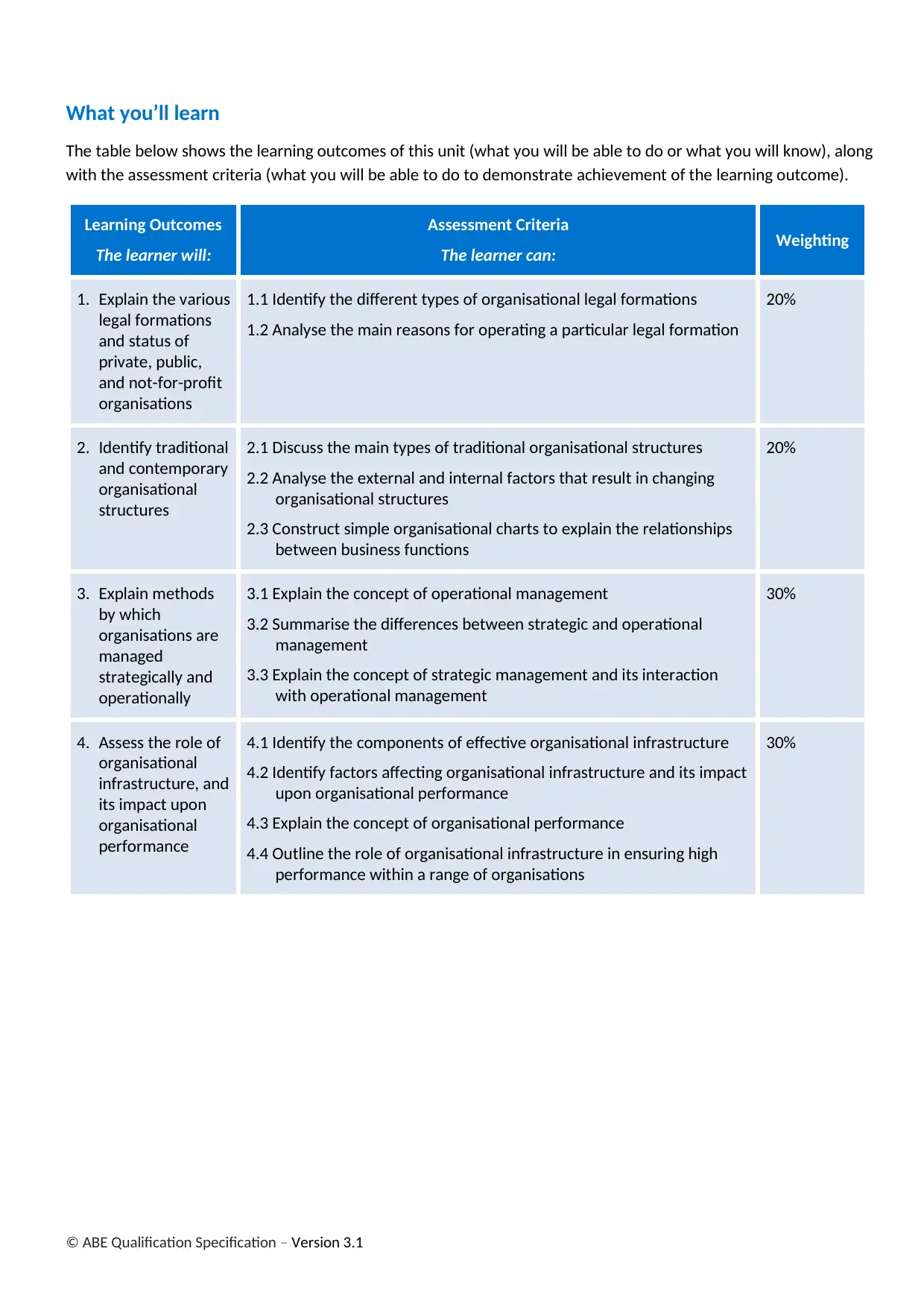
© ABE Qualification Specification – Version 3.1
What you’ll learn
The table below shows the learning outcomes of this unit (what you will be able to do or what you will know), along
with the assessment criteria (what you will be able to do to demonstrate achievement of the learning outcome).
Learning Outcomes
The learner will:
Assessment Criteria
The learner can: Weighting
1. Explain the various
legal formations
and status of
private, public,
and not-for-profit
organisations
1.1 Identify the different types of organisational legal formations
1.2 Analyse the main reasons for operating a particular legal formation
20%
2. Identify traditional
and contemporary
organisational
structures
2.1 Discuss the main types of traditional organisational structures
2.2 Analyse the external and internal factors that result in changing
organisational structures
2.3 Construct simple organisational charts to explain the relationships
between business functions
20%
3. Explain methods
by which
organisations are
managed
strategically and
operationally
3.1 Explain the concept of operational management
3.2 Summarise the differences between strategic and operational
management
3.3 Explain the concept of strategic management and its interaction
with operational management
30%
4. Assess the role of
organisational
infrastructure, and
its impact upon
organisational
performance
4.1 Identify the components of effective organisational infrastructure
4.2 Identify factors affecting organisational infrastructure and its impact
upon organisational performance
4.3 Explain the concept of organisational performance
4.4 Outline the role of organisational infrastructure in ensuring high
performance within a range of organisations
30%
What you’ll learn
The table below shows the learning outcomes of this unit (what you will be able to do or what you will know), along
with the assessment criteria (what you will be able to do to demonstrate achievement of the learning outcome).
Learning Outcomes
The learner will:
Assessment Criteria
The learner can: Weighting
1. Explain the various
legal formations
and status of
private, public,
and not-for-profit
organisations
1.1 Identify the different types of organisational legal formations
1.2 Analyse the main reasons for operating a particular legal formation
20%
2. Identify traditional
and contemporary
organisational
structures
2.1 Discuss the main types of traditional organisational structures
2.2 Analyse the external and internal factors that result in changing
organisational structures
2.3 Construct simple organisational charts to explain the relationships
between business functions
20%
3. Explain methods
by which
organisations are
managed
strategically and
operationally
3.1 Explain the concept of operational management
3.2 Summarise the differences between strategic and operational
management
3.3 Explain the concept of strategic management and its interaction
with operational management
30%
4. Assess the role of
organisational
infrastructure, and
its impact upon
organisational
performance
4.1 Identify the components of effective organisational infrastructure
4.2 Identify factors affecting organisational infrastructure and its impact
upon organisational performance
4.3 Explain the concept of organisational performance
4.4 Outline the role of organisational infrastructure in ensuring high
performance within a range of organisations
30%
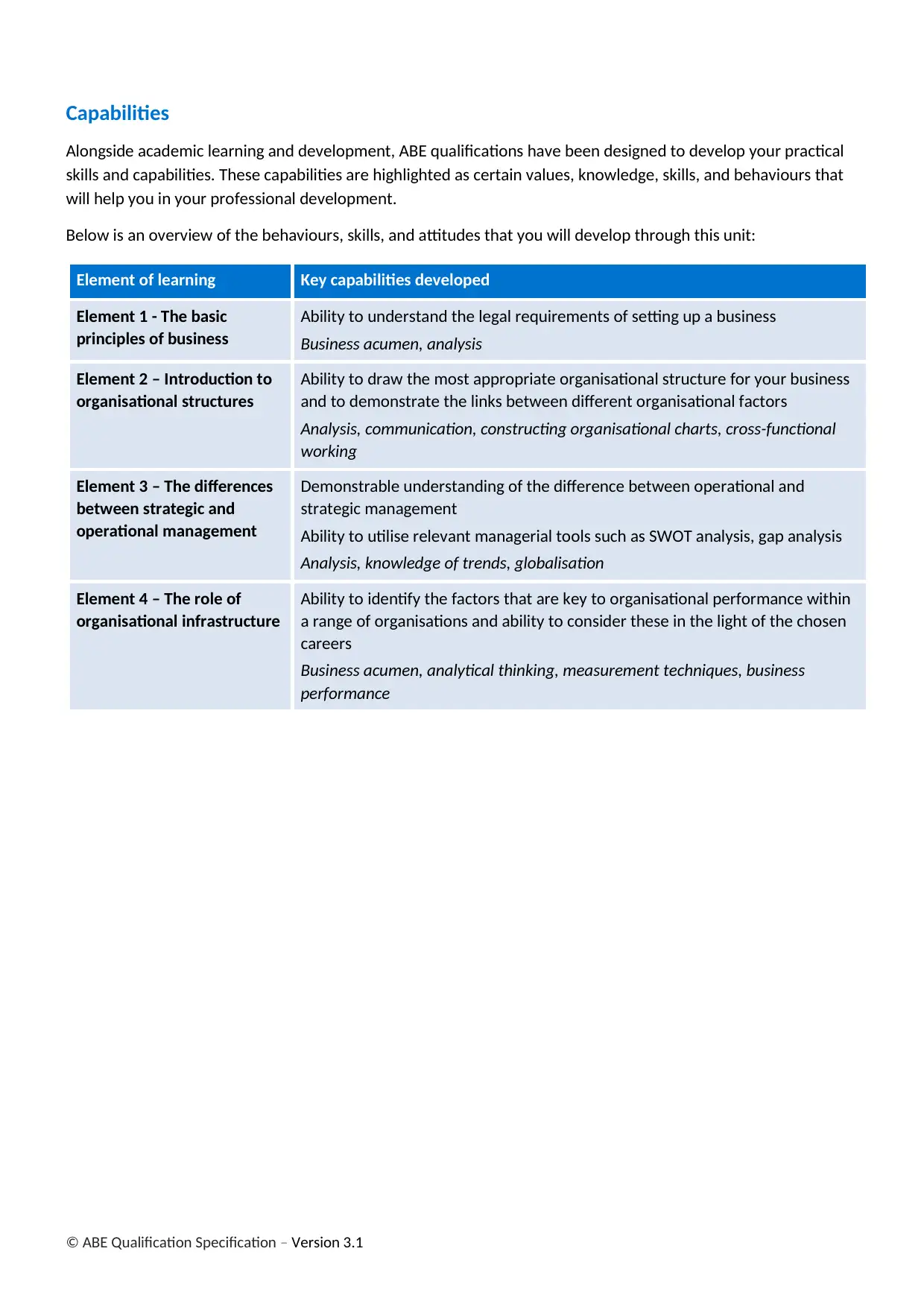
© ABE Qualification Specification – Version 3.1
Capabilities
Alongside academic learning and development, ABE qualifications have been designed to develop your practical
skills and capabilities. These capabilities are highlighted as certain values, knowledge, skills, and behaviours that
will help you in your professional development.
Below is an overview of the behaviours, skills, and attitudes that you will develop through this unit:
Element of learning Key capabilities developed
Element 1 - The basic
principles of business
Ability to understand the legal requirements of setting up a business
Business acumen, analysis
Element 2 – Introduction to
organisational structures
Ability to draw the most appropriate organisational structure for your business
and to demonstrate the links between different organisational factors
Analysis, communication, constructing organisational charts, cross-functional
working
Element 3 – The differences
between strategic and
operational management
Demonstrable understanding of the difference between operational and
strategic management
Ability to utilise relevant managerial tools such as SWOT analysis, gap analysis
Analysis, knowledge of trends, globalisation
Element 4 – The role of
organisational infrastructure
Ability to identify the factors that are key to organisational performance within
a range of organisations and ability to consider these in the light of the chosen
careers
Business acumen, analytical thinking, measurement techniques, business
performance
Capabilities
Alongside academic learning and development, ABE qualifications have been designed to develop your practical
skills and capabilities. These capabilities are highlighted as certain values, knowledge, skills, and behaviours that
will help you in your professional development.
Below is an overview of the behaviours, skills, and attitudes that you will develop through this unit:
Element of learning Key capabilities developed
Element 1 - The basic
principles of business
Ability to understand the legal requirements of setting up a business
Business acumen, analysis
Element 2 – Introduction to
organisational structures
Ability to draw the most appropriate organisational structure for your business
and to demonstrate the links between different organisational factors
Analysis, communication, constructing organisational charts, cross-functional
working
Element 3 – The differences
between strategic and
operational management
Demonstrable understanding of the difference between operational and
strategic management
Ability to utilise relevant managerial tools such as SWOT analysis, gap analysis
Analysis, knowledge of trends, globalisation
Element 4 – The role of
organisational infrastructure
Ability to identify the factors that are key to organisational performance within
a range of organisations and ability to consider these in the light of the chosen
careers
Business acumen, analytical thinking, measurement techniques, business
performance
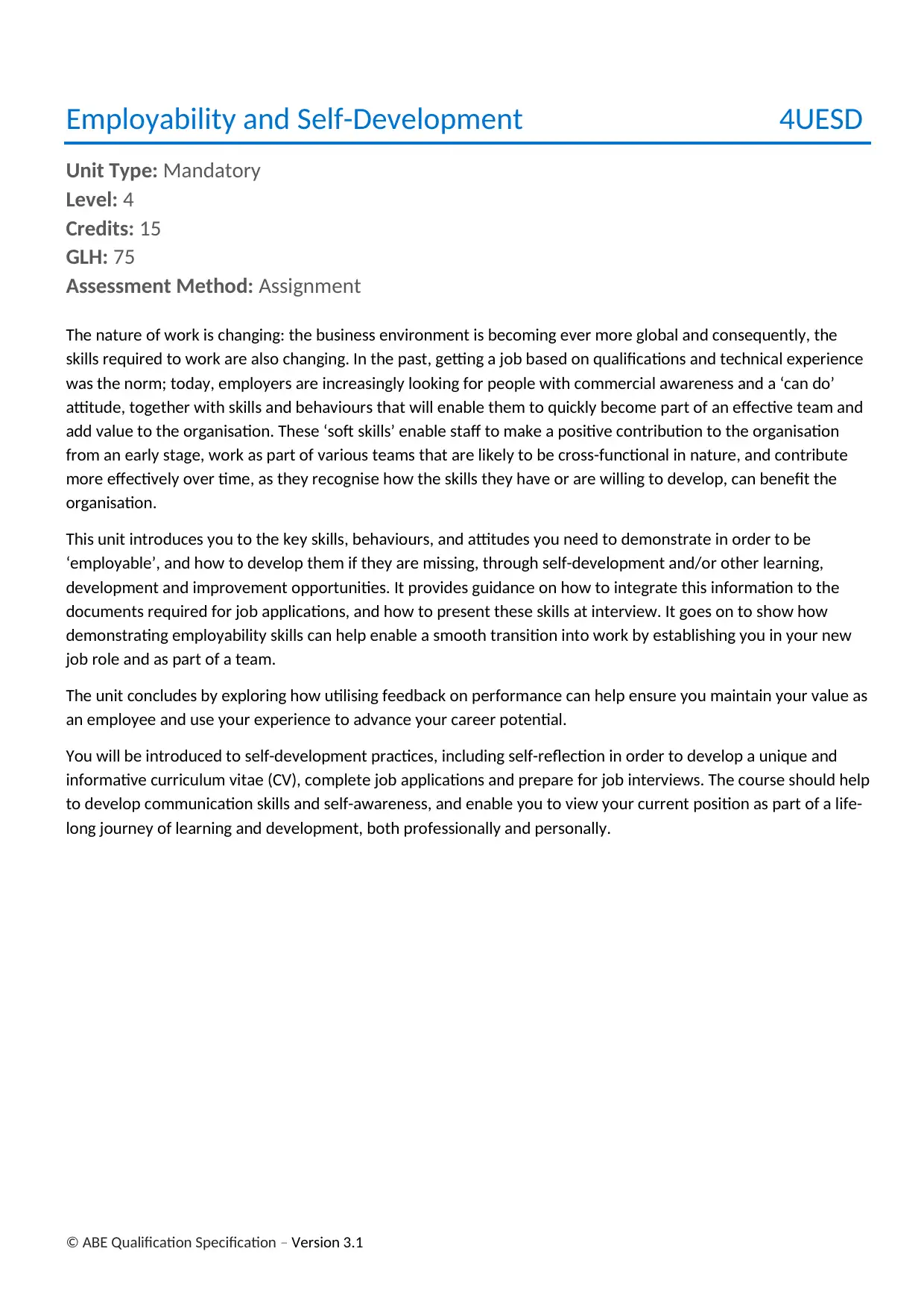
© ABE Qualification Specification – Version 3.1
Employability and Self-Development 4UESD
Unit Type: Mandatory
Level: 4
Credits: 15
GLH: 75
Assessment Method: Assignment
The nature of work is changing: the business environment is becoming ever more global and consequently, the
skills required to work are also changing. In the past, getting a job based on qualifications and technical experience
was the norm; today, employers are increasingly looking for people with commercial awareness and a ‘can do’
attitude, together with skills and behaviours that will enable them to quickly become part of an effective team and
add value to the organisation. These ‘soft skills’ enable staff to make a positive contribution to the organisation
from an early stage, work as part of various teams that are likely to be cross-functional in nature, and contribute
more effectively over time, as they recognise how the skills they have or are willing to develop, can benefit the
organisation.
This unit introduces you to the key skills, behaviours, and attitudes you need to demonstrate in order to be
‘employable’, and how to develop them if they are missing, through self-development and/or other learning,
development and improvement opportunities. It provides guidance on how to integrate this information to the
documents required for job applications, and how to present these skills at interview. It goes on to show how
demonstrating employability skills can help enable a smooth transition into work by establishing you in your new
job role and as part of a team.
The unit concludes by exploring how utilising feedback on performance can help ensure you maintain your value as
an employee and use your experience to advance your career potential.
You will be introduced to self-development practices, including self-reflection in order to develop a unique and
informative curriculum vitae (CV), complete job applications and prepare for job interviews. The course should help
to develop communication skills and self-awareness, and enable you to view your current position as part of a life-
long journey of learning and development, both professionally and personally.
Employability and Self-Development 4UESD
Unit Type: Mandatory
Level: 4
Credits: 15
GLH: 75
Assessment Method: Assignment
The nature of work is changing: the business environment is becoming ever more global and consequently, the
skills required to work are also changing. In the past, getting a job based on qualifications and technical experience
was the norm; today, employers are increasingly looking for people with commercial awareness and a ‘can do’
attitude, together with skills and behaviours that will enable them to quickly become part of an effective team and
add value to the organisation. These ‘soft skills’ enable staff to make a positive contribution to the organisation
from an early stage, work as part of various teams that are likely to be cross-functional in nature, and contribute
more effectively over time, as they recognise how the skills they have or are willing to develop, can benefit the
organisation.
This unit introduces you to the key skills, behaviours, and attitudes you need to demonstrate in order to be
‘employable’, and how to develop them if they are missing, through self-development and/or other learning,
development and improvement opportunities. It provides guidance on how to integrate this information to the
documents required for job applications, and how to present these skills at interview. It goes on to show how
demonstrating employability skills can help enable a smooth transition into work by establishing you in your new
job role and as part of a team.
The unit concludes by exploring how utilising feedback on performance can help ensure you maintain your value as
an employee and use your experience to advance your career potential.
You will be introduced to self-development practices, including self-reflection in order to develop a unique and
informative curriculum vitae (CV), complete job applications and prepare for job interviews. The course should help
to develop communication skills and self-awareness, and enable you to view your current position as part of a life-
long journey of learning and development, both professionally and personally.
Secure Best Marks with AI Grader
Need help grading? Try our AI Grader for instant feedback on your assignments.
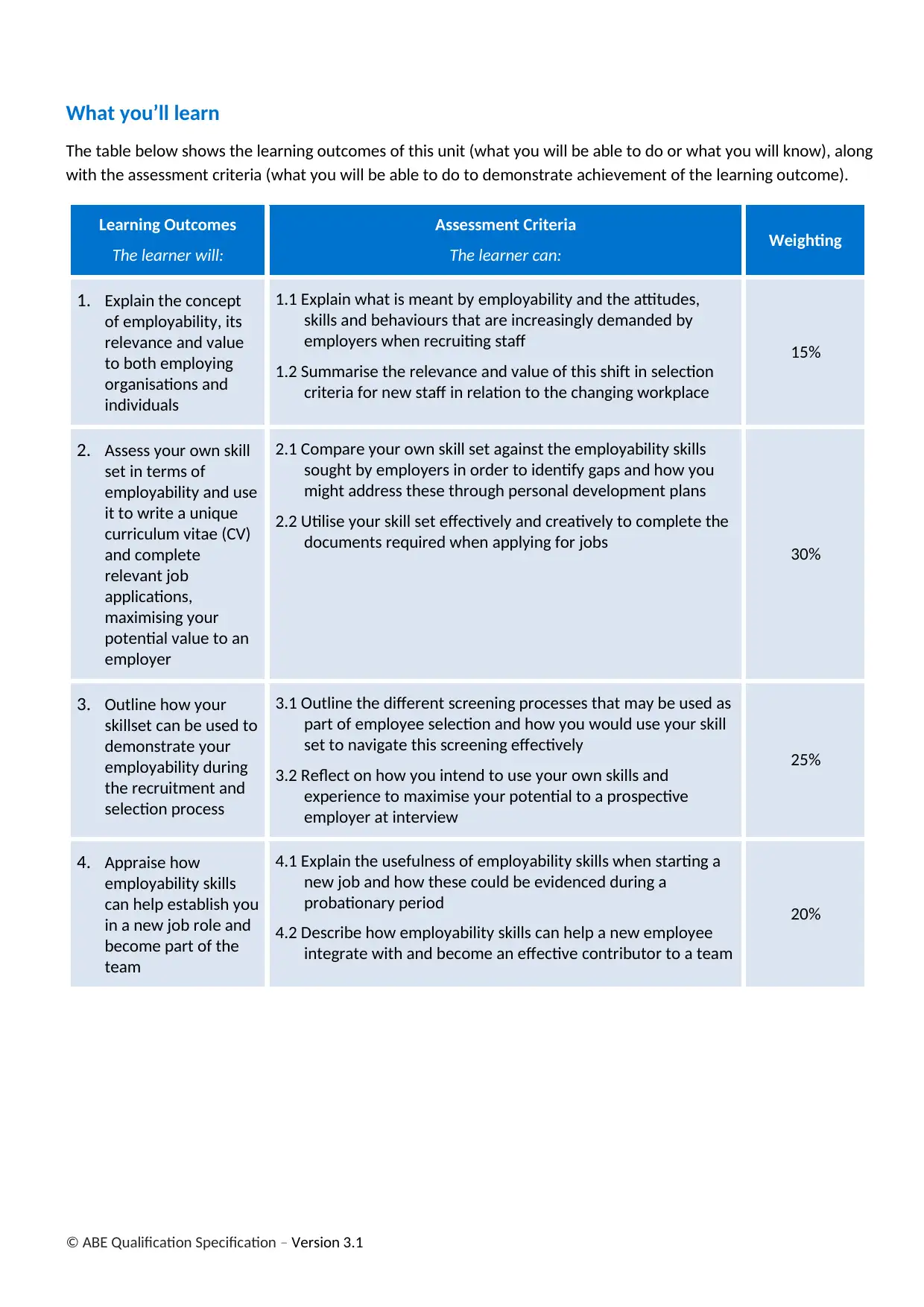
© ABE Qualification Specification – Version 3.1
What you’ll learn
The table below shows the learning outcomes of this unit (what you will be able to do or what you will know), along
with the assessment criteria (what you will be able to do to demonstrate achievement of the learning outcome).
Learning Outcomes
The learner will:
Assessment Criteria
The learner can: Weighting
1. Explain the concept
of employability, its
relevance and value
to both employing
organisations and
individuals
1.1 Explain what is meant by employability and the attitudes,
skills and behaviours that are increasingly demanded by
employers when recruiting staff
1.2 Summarise the relevance and value of this shift in selection
criteria for new staff in relation to the changing workplace
15%
2. Assess your own skill
set in terms of
employability and use
it to write a unique
curriculum vitae (CV)
and complete
relevant job
applications,
maximising your
potential value to an
employer
2.1 Compare your own skill set against the employability skills
sought by employers in order to identify gaps and how you
might address these through personal development plans
2.2 Utilise your skill set effectively and creatively to complete the
documents required when applying for jobs 30%
3. Outline how your
skillset can be used to
demonstrate your
employability during
the recruitment and
selection process
3.1 Outline the different screening processes that may be used as
part of employee selection and how you would use your skill
set to navigate this screening effectively
3.2 Reflect on how you intend to use your own skills and
experience to maximise your potential to a prospective
employer at interview
25%
4. Appraise how
employability skills
can help establish you
in a new job role and
become part of the
team
4.1 Explain the usefulness of employability skills when starting a
new job and how these could be evidenced during a
probationary period
4.2 Describe how employability skills can help a new employee
integrate with and become an effective contributor to a team
20%
What you’ll learn
The table below shows the learning outcomes of this unit (what you will be able to do or what you will know), along
with the assessment criteria (what you will be able to do to demonstrate achievement of the learning outcome).
Learning Outcomes
The learner will:
Assessment Criteria
The learner can: Weighting
1. Explain the concept
of employability, its
relevance and value
to both employing
organisations and
individuals
1.1 Explain what is meant by employability and the attitudes,
skills and behaviours that are increasingly demanded by
employers when recruiting staff
1.2 Summarise the relevance and value of this shift in selection
criteria for new staff in relation to the changing workplace
15%
2. Assess your own skill
set in terms of
employability and use
it to write a unique
curriculum vitae (CV)
and complete
relevant job
applications,
maximising your
potential value to an
employer
2.1 Compare your own skill set against the employability skills
sought by employers in order to identify gaps and how you
might address these through personal development plans
2.2 Utilise your skill set effectively and creatively to complete the
documents required when applying for jobs 30%
3. Outline how your
skillset can be used to
demonstrate your
employability during
the recruitment and
selection process
3.1 Outline the different screening processes that may be used as
part of employee selection and how you would use your skill
set to navigate this screening effectively
3.2 Reflect on how you intend to use your own skills and
experience to maximise your potential to a prospective
employer at interview
25%
4. Appraise how
employability skills
can help establish you
in a new job role and
become part of the
team
4.1 Explain the usefulness of employability skills when starting a
new job and how these could be evidenced during a
probationary period
4.2 Describe how employability skills can help a new employee
integrate with and become an effective contributor to a team
20%
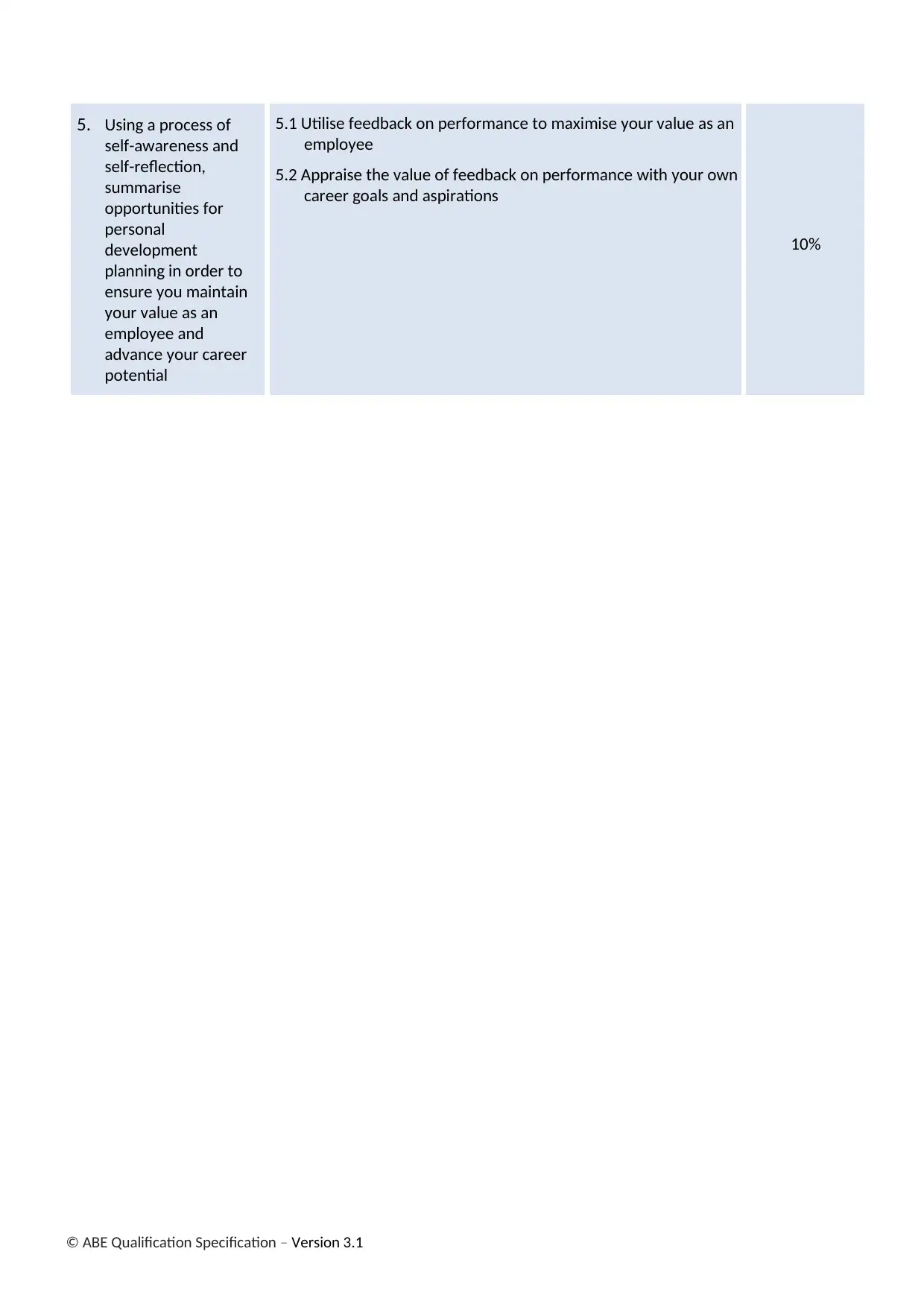
© ABE Qualification Specification – Version 3.1
5. Using a process of
self-awareness and
self-reflection,
summarise
opportunities for
personal
development
planning in order to
ensure you maintain
your value as an
employee and
advance your career
potential
5.1 Utilise feedback on performance to maximise your value as an
employee
5.2 Appraise the value of feedback on performance with your own
career goals and aspirations
10%
5. Using a process of
self-awareness and
self-reflection,
summarise
opportunities for
personal
development
planning in order to
ensure you maintain
your value as an
employee and
advance your career
potential
5.1 Utilise feedback on performance to maximise your value as an
employee
5.2 Appraise the value of feedback on performance with your own
career goals and aspirations
10%
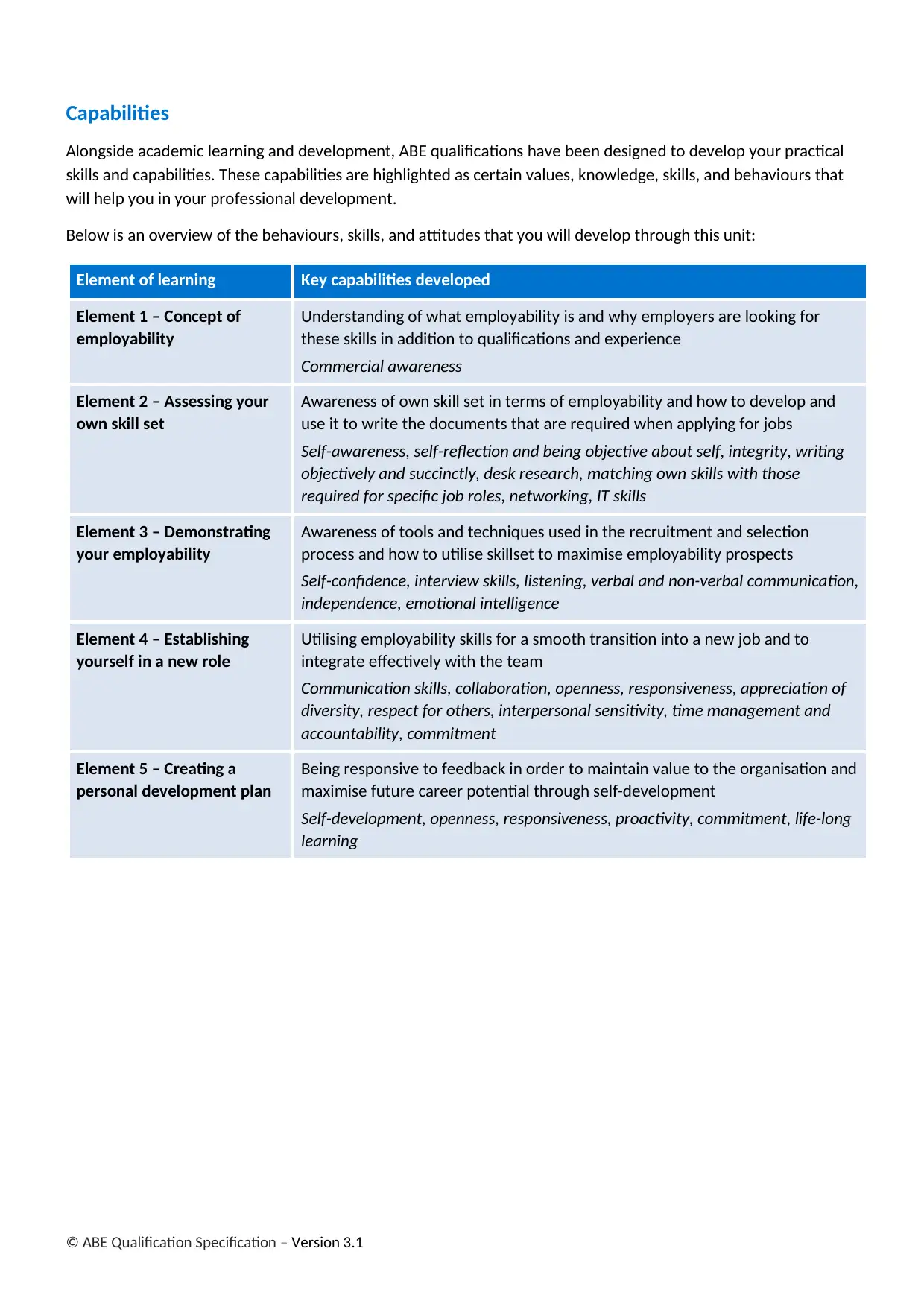
© ABE Qualification Specification – Version 3.1
Capabilities
Alongside academic learning and development, ABE qualifications have been designed to develop your practical
skills and capabilities. These capabilities are highlighted as certain values, knowledge, skills, and behaviours that
will help you in your professional development.
Below is an overview of the behaviours, skills, and attitudes that you will develop through this unit:
Element of learning Key capabilities developed
Element 1 – Concept of
employability
Understanding of what employability is and why employers are looking for
these skills in addition to qualifications and experience
Commercial awareness
Element 2 – Assessing your
own skill set
Awareness of own skill set in terms of employability and how to develop and
use it to write the documents that are required when applying for jobs
Self-awareness, self-reflection and being objective about self, integrity, writing
objectively and succinctly, desk research, matching own skills with those
required for specific job roles, networking, IT skills
Element 3 – Demonstrating
your employability
Awareness of tools and techniques used in the recruitment and selection
process and how to utilise skillset to maximise employability prospects
Self-confidence, interview skills, listening, verbal and non-verbal communication,
independence, emotional intelligence
Element 4 – Establishing
yourself in a new role
Utilising employability skills for a smooth transition into a new job and to
integrate effectively with the team
Communication skills, collaboration, openness, responsiveness, appreciation of
diversity, respect for others, interpersonal sensitivity, time management and
accountability, commitment
Element 5 – Creating a
personal development plan
Being responsive to feedback in order to maintain value to the organisation and
maximise future career potential through self-development
Self-development, openness, responsiveness, proactivity, commitment, life-long
learning
Capabilities
Alongside academic learning and development, ABE qualifications have been designed to develop your practical
skills and capabilities. These capabilities are highlighted as certain values, knowledge, skills, and behaviours that
will help you in your professional development.
Below is an overview of the behaviours, skills, and attitudes that you will develop through this unit:
Element of learning Key capabilities developed
Element 1 – Concept of
employability
Understanding of what employability is and why employers are looking for
these skills in addition to qualifications and experience
Commercial awareness
Element 2 – Assessing your
own skill set
Awareness of own skill set in terms of employability and how to develop and
use it to write the documents that are required when applying for jobs
Self-awareness, self-reflection and being objective about self, integrity, writing
objectively and succinctly, desk research, matching own skills with those
required for specific job roles, networking, IT skills
Element 3 – Demonstrating
your employability
Awareness of tools and techniques used in the recruitment and selection
process and how to utilise skillset to maximise employability prospects
Self-confidence, interview skills, listening, verbal and non-verbal communication,
independence, emotional intelligence
Element 4 – Establishing
yourself in a new role
Utilising employability skills for a smooth transition into a new job and to
integrate effectively with the team
Communication skills, collaboration, openness, responsiveness, appreciation of
diversity, respect for others, interpersonal sensitivity, time management and
accountability, commitment
Element 5 – Creating a
personal development plan
Being responsive to feedback in order to maintain value to the organisation and
maximise future career potential through self-development
Self-development, openness, responsiveness, proactivity, commitment, life-long
learning
Paraphrase This Document
Need a fresh take? Get an instant paraphrase of this document with our AI Paraphraser
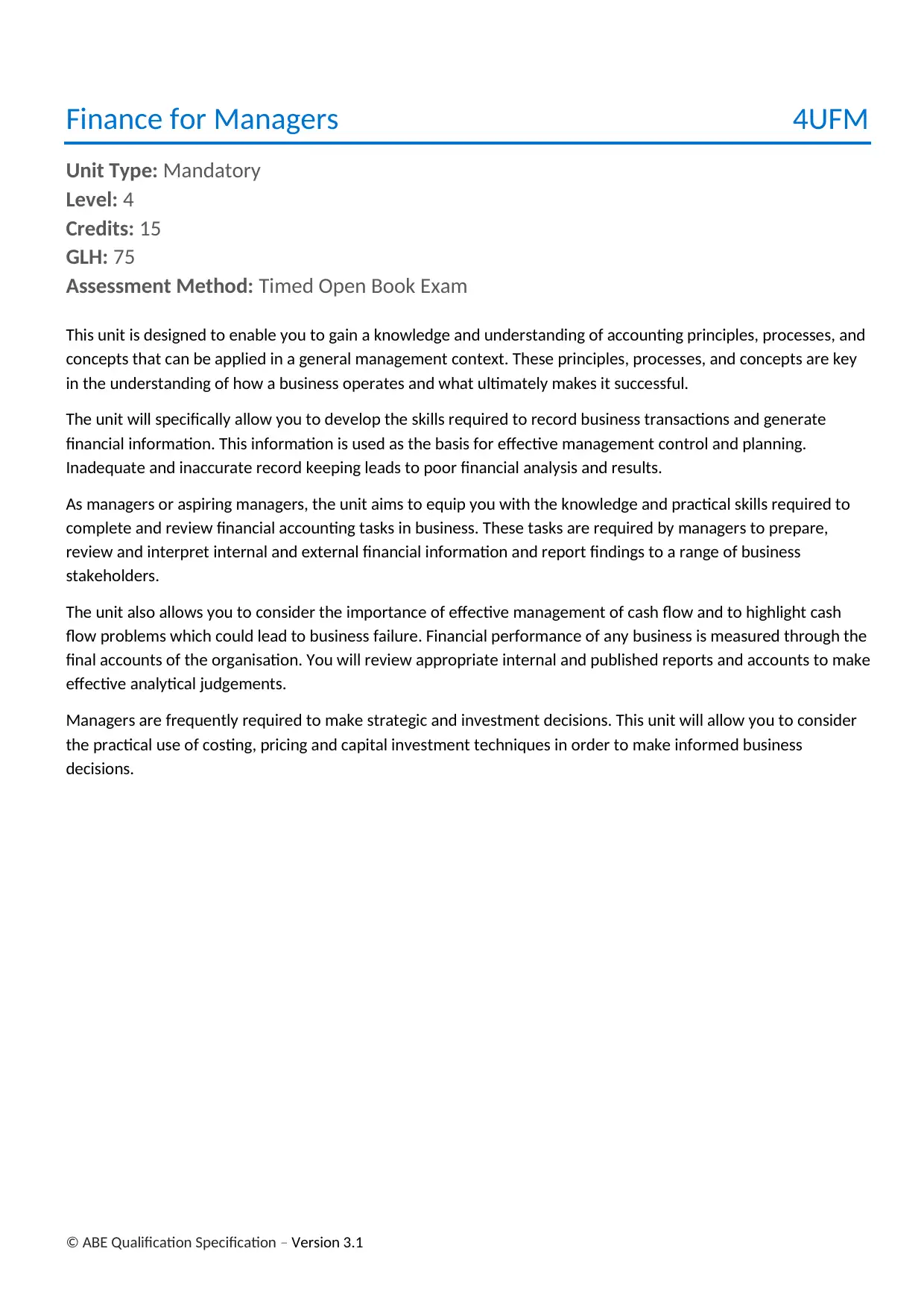
© ABE Qualification Specification – Version 3.1
Finance for Managers 4UFM
Unit Type: Mandatory
Level: 4
Credits: 15
GLH: 75
Assessment Method: Timed Open Book Exam
This unit is designed to enable you to gain a knowledge and understanding of accounting principles, processes, and
concepts that can be applied in a general management context. These principles, processes, and concepts are key
in the understanding of how a business operates and what ultimately makes it successful.
The unit will specifically allow you to develop the skills required to record business transactions and generate
financial information. This information is used as the basis for effective management control and planning.
Inadequate and inaccurate record keeping leads to poor financial analysis and results.
As managers or aspiring managers, the unit aims to equip you with the knowledge and practical skills required to
complete and review financial accounting tasks in business. These tasks are required by managers to prepare,
review and interpret internal and external financial information and report findings to a range of business
stakeholders.
The unit also allows you to consider the importance of effective management of cash flow and to highlight cash
flow problems which could lead to business failure. Financial performance of any business is measured through the
final accounts of the organisation. You will review appropriate internal and published reports and accounts to make
effective analytical judgements.
Managers are frequently required to make strategic and investment decisions. This unit will allow you to consider
the practical use of costing, pricing and capital investment techniques in order to make informed business
decisions.
Finance for Managers 4UFM
Unit Type: Mandatory
Level: 4
Credits: 15
GLH: 75
Assessment Method: Timed Open Book Exam
This unit is designed to enable you to gain a knowledge and understanding of accounting principles, processes, and
concepts that can be applied in a general management context. These principles, processes, and concepts are key
in the understanding of how a business operates and what ultimately makes it successful.
The unit will specifically allow you to develop the skills required to record business transactions and generate
financial information. This information is used as the basis for effective management control and planning.
Inadequate and inaccurate record keeping leads to poor financial analysis and results.
As managers or aspiring managers, the unit aims to equip you with the knowledge and practical skills required to
complete and review financial accounting tasks in business. These tasks are required by managers to prepare,
review and interpret internal and external financial information and report findings to a range of business
stakeholders.
The unit also allows you to consider the importance of effective management of cash flow and to highlight cash
flow problems which could lead to business failure. Financial performance of any business is measured through the
final accounts of the organisation. You will review appropriate internal and published reports and accounts to make
effective analytical judgements.
Managers are frequently required to make strategic and investment decisions. This unit will allow you to consider
the practical use of costing, pricing and capital investment techniques in order to make informed business
decisions.
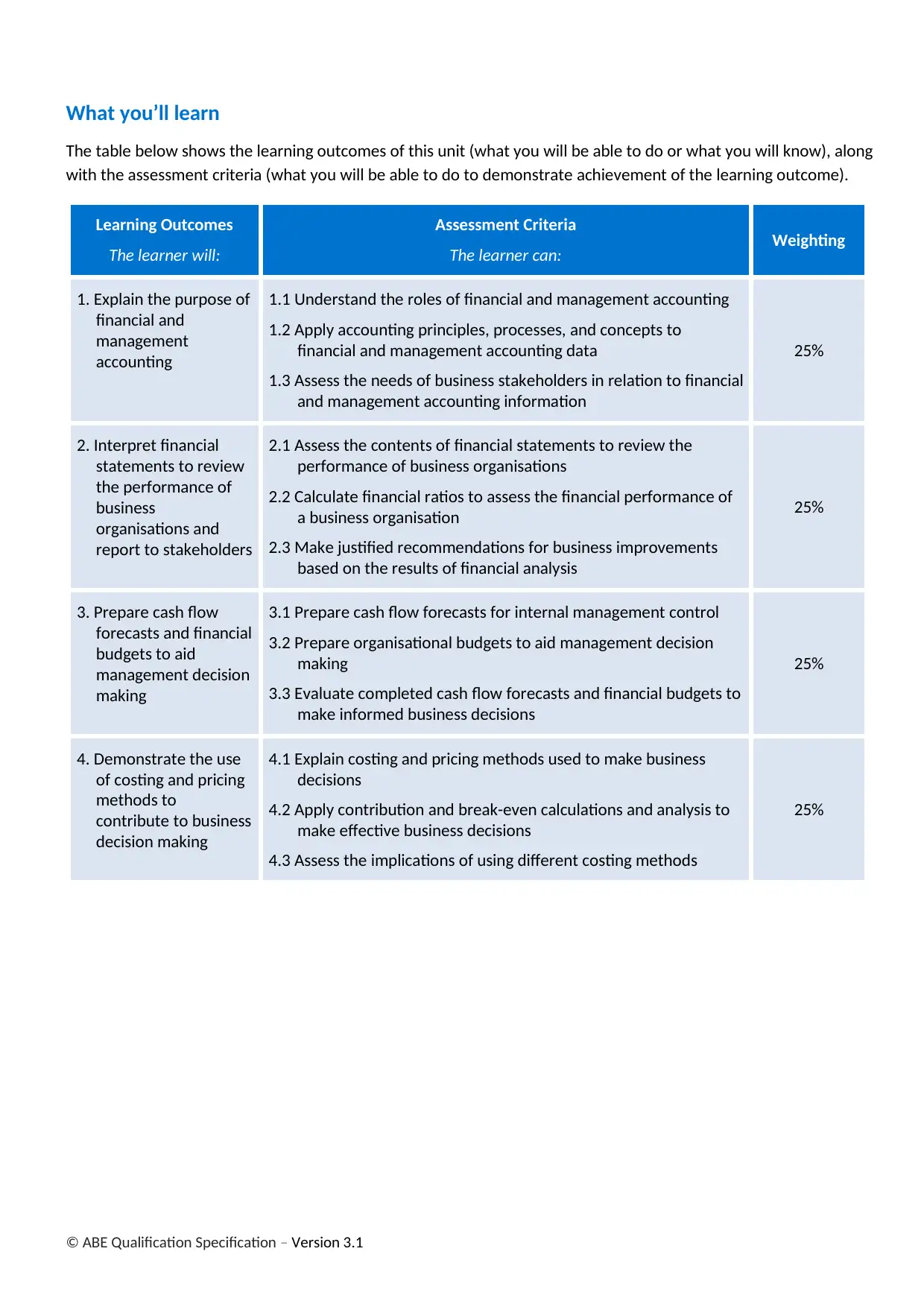
© ABE Qualification Specification – Version 3.1
What you’ll learn
The table below shows the learning outcomes of this unit (what you will be able to do or what you will know), along
with the assessment criteria (what you will be able to do to demonstrate achievement of the learning outcome).
Learning Outcomes
The learner will:
Assessment Criteria
The learner can: Weighting
1. Explain the purpose of
financial and
management
accounting
1.1 Understand the roles of financial and management accounting
1.2 Apply accounting principles, processes, and concepts to
financial and management accounting data
1.3 Assess the needs of business stakeholders in relation to financial
and management accounting information
25%
2. Interpret financial
statements to review
the performance of
business
organisations and
report to stakeholders
2.1 Assess the contents of financial statements to review the
performance of business organisations
2.2 Calculate financial ratios to assess the financial performance of
a business organisation
2.3 Make justified recommendations for business improvements
based on the results of financial analysis
25%
3. Prepare cash flow
forecasts and financial
budgets to aid
management decision
making
3.1 Prepare cash flow forecasts for internal management control
3.2 Prepare organisational budgets to aid management decision
making
3.3 Evaluate completed cash flow forecasts and financial budgets to
make informed business decisions
25%
4. Demonstrate the use
of costing and pricing
methods to
contribute to business
decision making
4.1 Explain costing and pricing methods used to make business
decisions
4.2 Apply contribution and break-even calculations and analysis to
make effective business decisions
4.3 Assess the implications of using different costing methods
25%
What you’ll learn
The table below shows the learning outcomes of this unit (what you will be able to do or what you will know), along
with the assessment criteria (what you will be able to do to demonstrate achievement of the learning outcome).
Learning Outcomes
The learner will:
Assessment Criteria
The learner can: Weighting
1. Explain the purpose of
financial and
management
accounting
1.1 Understand the roles of financial and management accounting
1.2 Apply accounting principles, processes, and concepts to
financial and management accounting data
1.3 Assess the needs of business stakeholders in relation to financial
and management accounting information
25%
2. Interpret financial
statements to review
the performance of
business
organisations and
report to stakeholders
2.1 Assess the contents of financial statements to review the
performance of business organisations
2.2 Calculate financial ratios to assess the financial performance of
a business organisation
2.3 Make justified recommendations for business improvements
based on the results of financial analysis
25%
3. Prepare cash flow
forecasts and financial
budgets to aid
management decision
making
3.1 Prepare cash flow forecasts for internal management control
3.2 Prepare organisational budgets to aid management decision
making
3.3 Evaluate completed cash flow forecasts and financial budgets to
make informed business decisions
25%
4. Demonstrate the use
of costing and pricing
methods to
contribute to business
decision making
4.1 Explain costing and pricing methods used to make business
decisions
4.2 Apply contribution and break-even calculations and analysis to
make effective business decisions
4.3 Assess the implications of using different costing methods
25%
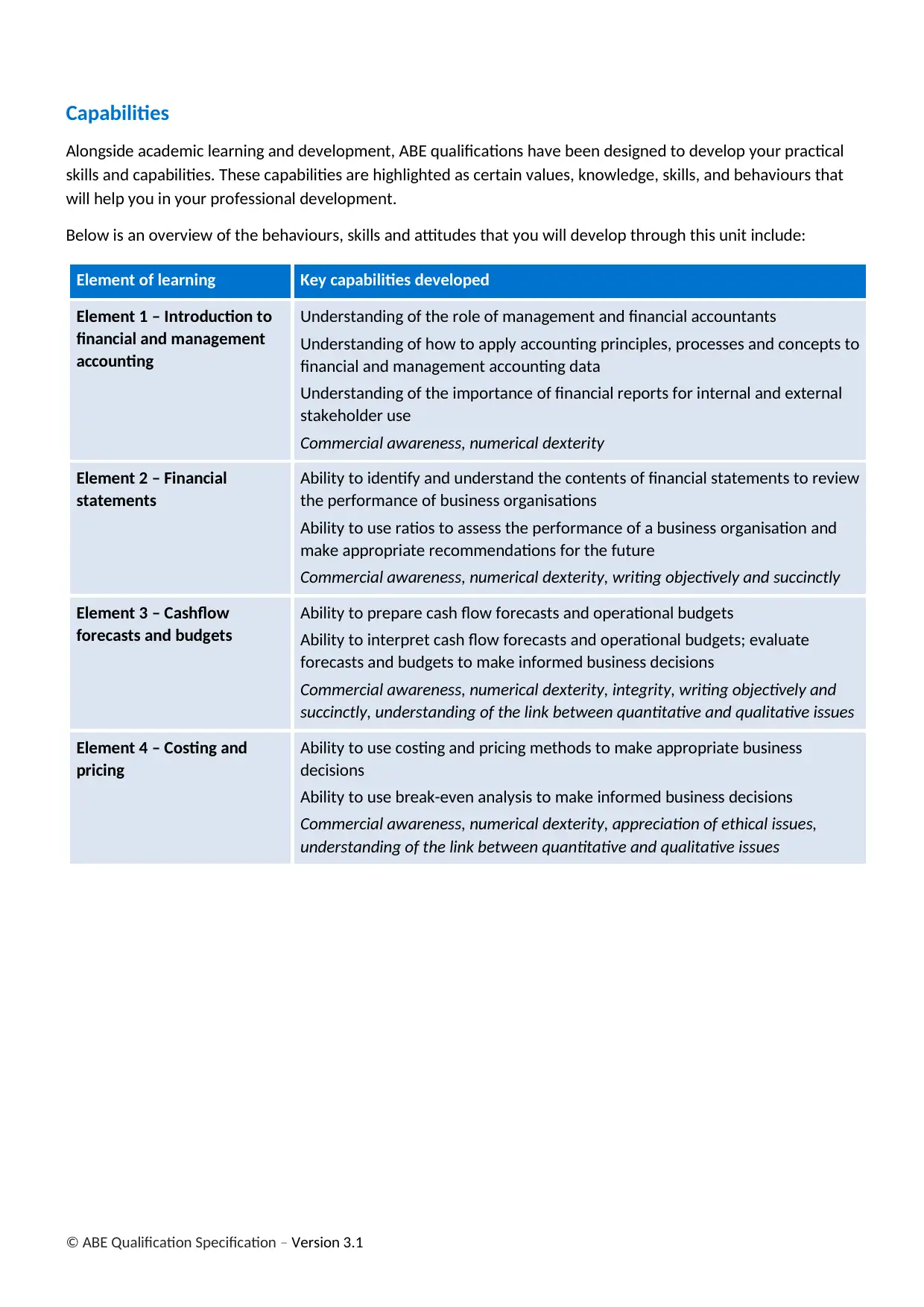
© ABE Qualification Specification – Version 3.1
Capabilities
Alongside academic learning and development, ABE qualifications have been designed to develop your practical
skills and capabilities. These capabilities are highlighted as certain values, knowledge, skills, and behaviours that
will help you in your professional development.
Below is an overview of the behaviours, skills and attitudes that you will develop through this unit include:
Element of learning Key capabilities developed
Element 1 – Introduction to
financial and management
accounting
Understanding of the role of management and financial accountants
Understanding of how to apply accounting principles, processes and concepts to
financial and management accounting data
Understanding of the importance of financial reports for internal and external
stakeholder use
Commercial awareness, numerical dexterity
Element 2 – Financial
statements
Ability to identify and understand the contents of financial statements to review
the performance of business organisations
Ability to use ratios to assess the performance of a business organisation and
make appropriate recommendations for the future
Commercial awareness, numerical dexterity, writing objectively and succinctly
Element 3 – Cashflow
forecasts and budgets
Ability to prepare cash flow forecasts and operational budgets
Ability to interpret cash flow forecasts and operational budgets; evaluate
forecasts and budgets to make informed business decisions
Commercial awareness, numerical dexterity, integrity, writing objectively and
succinctly, understanding of the link between quantitative and qualitative issues
Element 4 – Costing and
pricing
Ability to use costing and pricing methods to make appropriate business
decisions
Ability to use break-even analysis to make informed business decisions
Commercial awareness, numerical dexterity, appreciation of ethical issues,
understanding of the link between quantitative and qualitative issues
Capabilities
Alongside academic learning and development, ABE qualifications have been designed to develop your practical
skills and capabilities. These capabilities are highlighted as certain values, knowledge, skills, and behaviours that
will help you in your professional development.
Below is an overview of the behaviours, skills and attitudes that you will develop through this unit include:
Element of learning Key capabilities developed
Element 1 – Introduction to
financial and management
accounting
Understanding of the role of management and financial accountants
Understanding of how to apply accounting principles, processes and concepts to
financial and management accounting data
Understanding of the importance of financial reports for internal and external
stakeholder use
Commercial awareness, numerical dexterity
Element 2 – Financial
statements
Ability to identify and understand the contents of financial statements to review
the performance of business organisations
Ability to use ratios to assess the performance of a business organisation and
make appropriate recommendations for the future
Commercial awareness, numerical dexterity, writing objectively and succinctly
Element 3 – Cashflow
forecasts and budgets
Ability to prepare cash flow forecasts and operational budgets
Ability to interpret cash flow forecasts and operational budgets; evaluate
forecasts and budgets to make informed business decisions
Commercial awareness, numerical dexterity, integrity, writing objectively and
succinctly, understanding of the link between quantitative and qualitative issues
Element 4 – Costing and
pricing
Ability to use costing and pricing methods to make appropriate business
decisions
Ability to use break-even analysis to make informed business decisions
Commercial awareness, numerical dexterity, appreciation of ethical issues,
understanding of the link between quantitative and qualitative issues
Secure Best Marks with AI Grader
Need help grading? Try our AI Grader for instant feedback on your assignments.
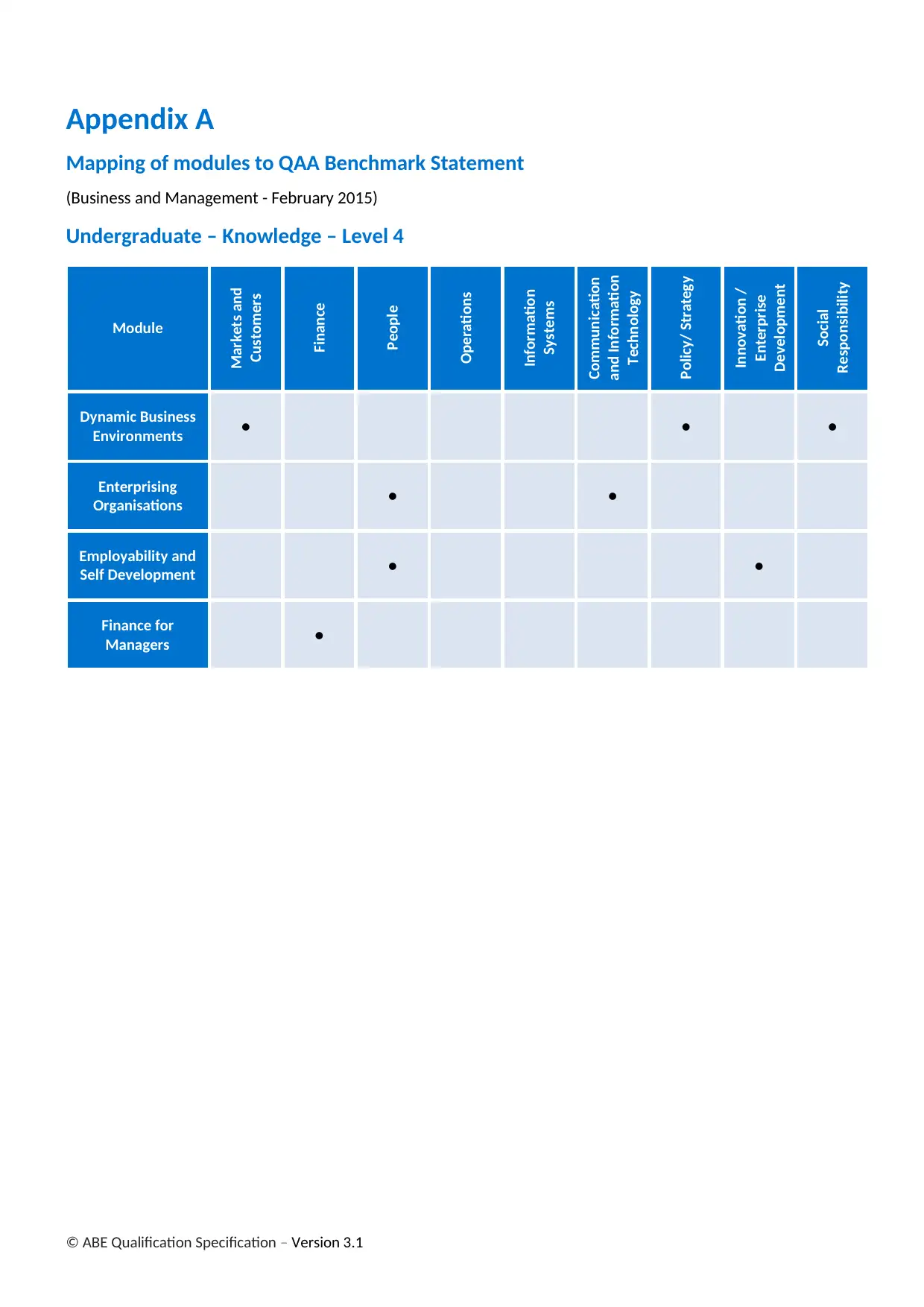
© ABE Qualification Specification – Version 3.1
Appendix A
Mapping of modules to QAA Benchmark Statement
(Business and Management - February 2015)
Undergraduate – Knowledge – Level 4
Module
Markets and
Customers
Finance
People
Operations
Information
Systems
Communication
and Information
Technology
Policy/ Strategy
Innovation /
Enterprise
Development
Social
Responsibility
Dynamic Business
Environments ● ● ●
Enterprising
Organisations ● ●
Employability and
Self Development ● ●
Finance for
Managers ●
Appendix A
Mapping of modules to QAA Benchmark Statement
(Business and Management - February 2015)
Undergraduate – Knowledge – Level 4
Module
Markets and
Customers
Finance
People
Operations
Information
Systems
Communication
and Information
Technology
Policy/ Strategy
Innovation /
Enterprise
Development
Social
Responsibility
Dynamic Business
Environments ● ● ●
Enterprising
Organisations ● ●
Employability and
Self Development ● ●
Finance for
Managers ●
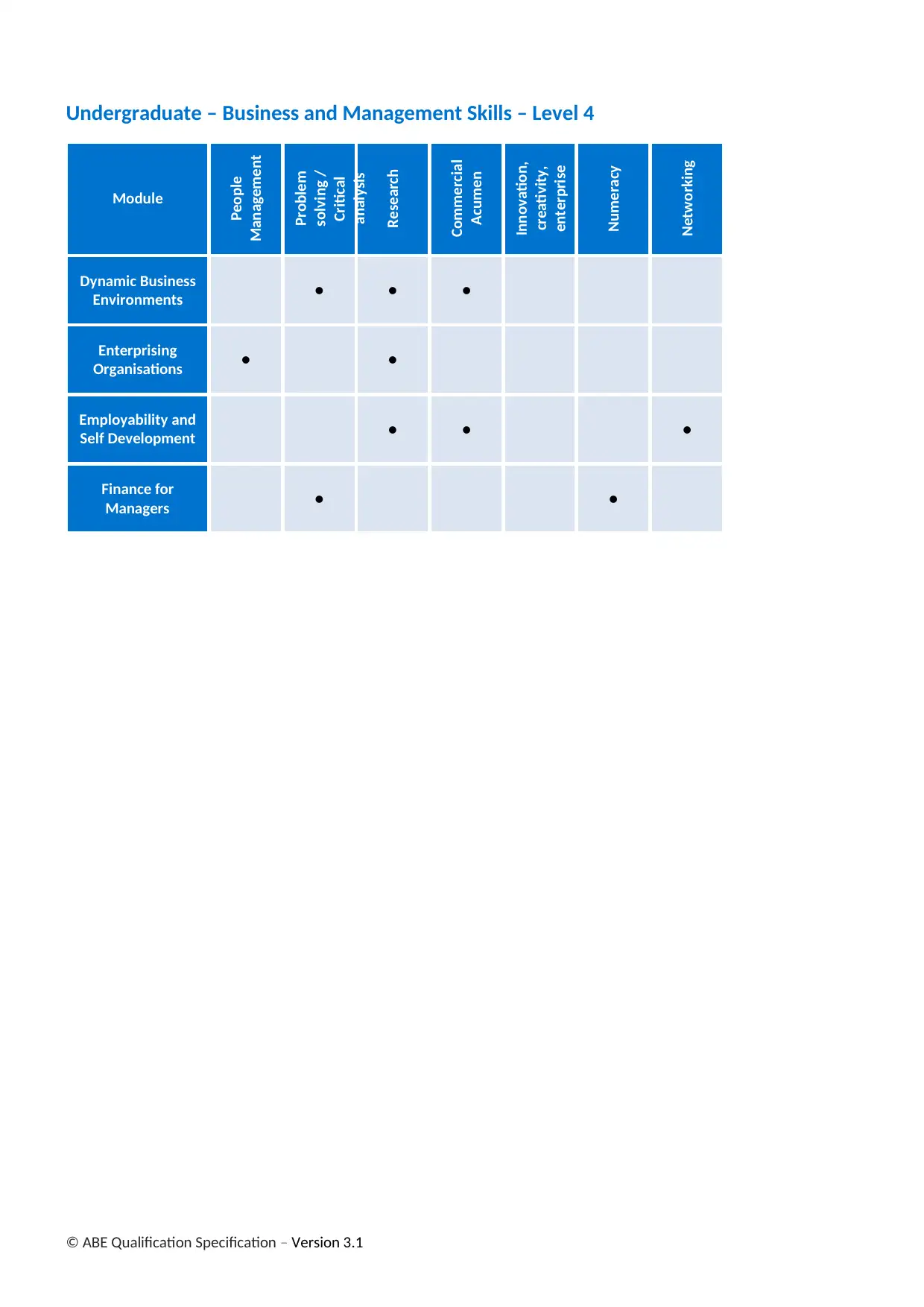
© ABE Qualification Specification – Version 3.1
Undergraduate – Business and Management Skills – Level 4
Module
People
Management
Problem
solving /
Critical
analysis
Research
Commercial
Acumen
Innovation,
creativity,
enterprise
Numeracy
Networking
Dynamic Business
Environments ● ● ●
Enterprising
Organisations ● ●
Employability and
Self Development ● ● ●
Finance for
Managers ● ●
Undergraduate – Business and Management Skills – Level 4
Module
People
Management
Problem
solving /
Critical
analysis
Research
Commercial
Acumen
Innovation,
creativity,
enterprise
Numeracy
Networking
Dynamic Business
Environments ● ● ●
Enterprising
Organisations ● ●
Employability and
Self Development ● ● ●
Finance for
Managers ● ●
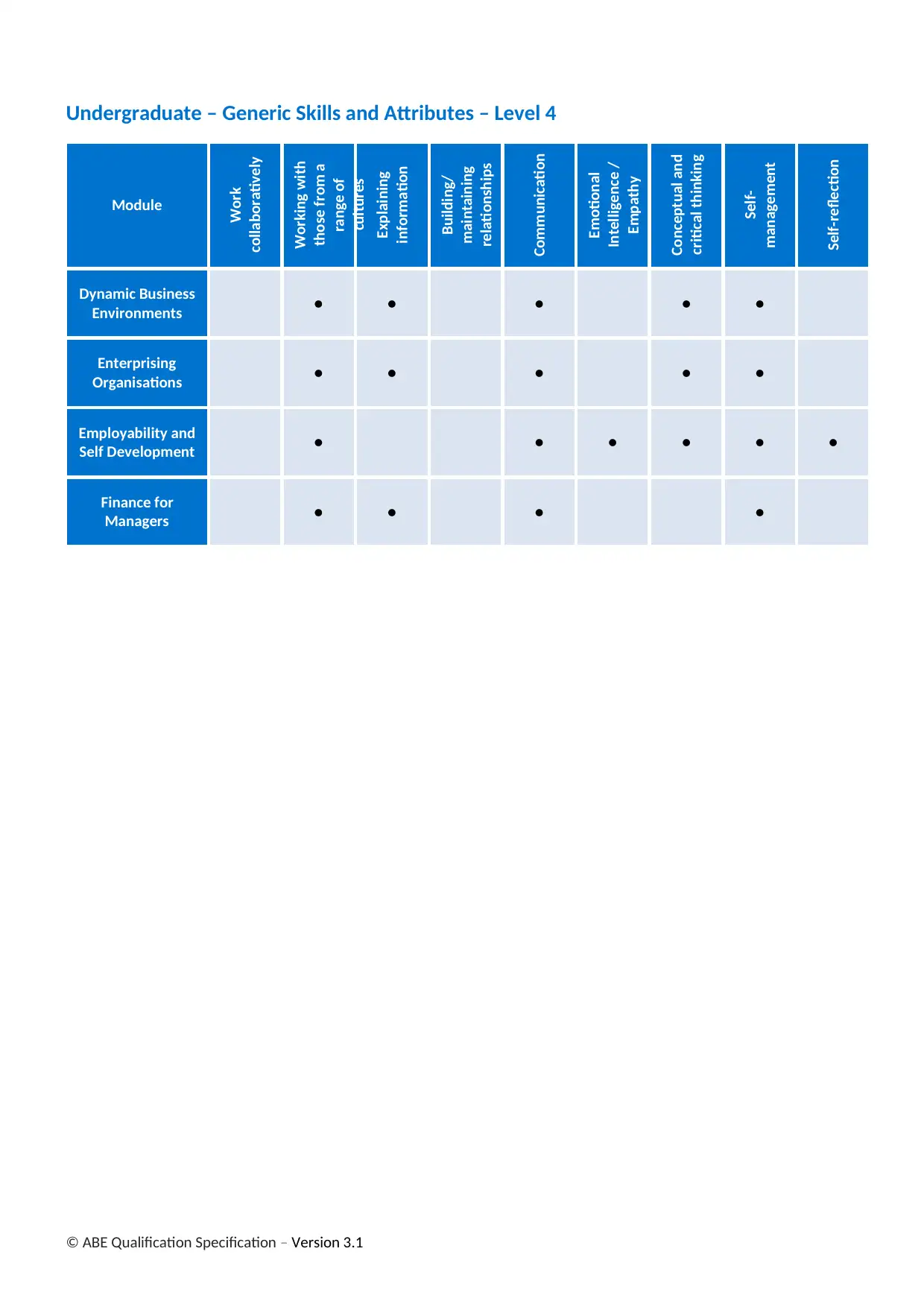
© ABE Qualification Specification – Version 3.1
Undergraduate – Generic Skills and Attributes – Level 4
Module
Work
collaboratively
Working with
those from a
range of
cultures
Explaining
information
Building/
maintaining
relationships
Communication
Emotional
Intelligence /
Empathy
Conceptual and
critical thinking
Self-
management
Self-reflection
Dynamic Business
Environments ● ● ● ● ●
Enterprising
Organisations ● ● ● ● ●
Employability and
Self Development ● ● ● ● ● ●
Finance for
Managers ● ● ● ●
Undergraduate – Generic Skills and Attributes – Level 4
Module
Work
collaboratively
Working with
those from a
range of
cultures
Explaining
information
Building/
maintaining
relationships
Communication
Emotional
Intelligence /
Empathy
Conceptual and
critical thinking
Self-
management
Self-reflection
Dynamic Business
Environments ● ● ● ● ●
Enterprising
Organisations ● ● ● ● ●
Employability and
Self Development ● ● ● ● ● ●
Finance for
Managers ● ● ● ●
Paraphrase This Document
Need a fresh take? Get an instant paraphrase of this document with our AI Paraphraser
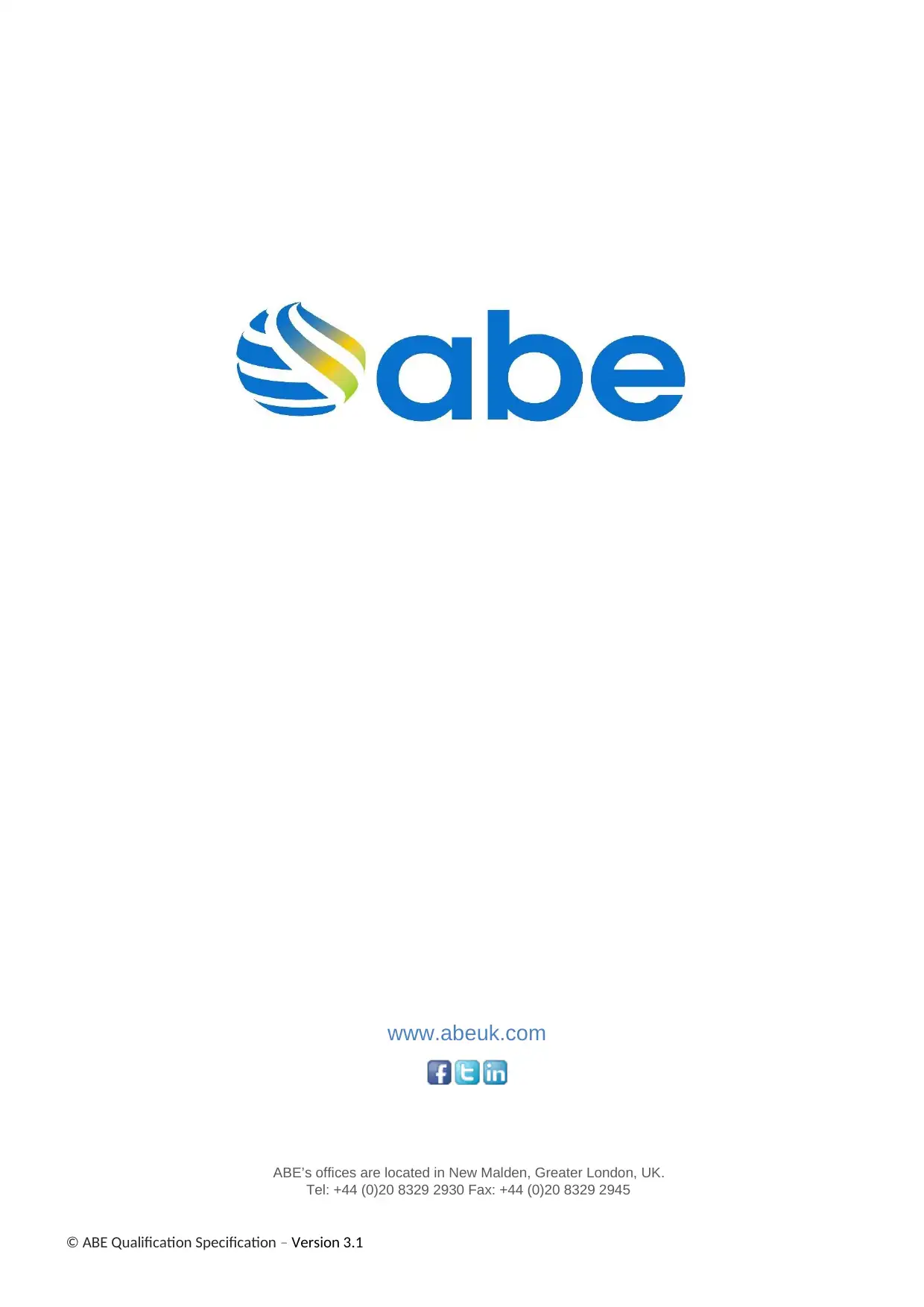
© ABE Qualification Specification – Version 3.1
www.abeuk.com
ABE’s offices are located in New Malden, Greater London, UK.
Tel: +44 (0)20 8329 2930 Fax: +44 (0)20 8329 2945
www.abeuk.com
ABE’s offices are located in New Malden, Greater London, UK.
Tel: +44 (0)20 8329 2930 Fax: +44 (0)20 8329 2945
1 out of 38
Your All-in-One AI-Powered Toolkit for Academic Success.
+13062052269
info@desklib.com
Available 24*7 on WhatsApp / Email
![[object Object]](/_next/static/media/star-bottom.7253800d.svg)
Unlock your academic potential
© 2024 | Zucol Services PVT LTD | All rights reserved.
